Thi:
1) Bố thí (cho): To give—To offer—To donate.
2) Đi thi: To go in (sit) for an examination.
3) Tử thi: Dead body—Corpse (of a murder person).
4) Thơ: Poetry.
Thi Ân: To grant (do) a favour.
Thi Ân Bất Cầu Báo, Còn Cầu Báo Là Thi Ân Có Mưu Đồ Và Sự Thi Ân
Như Vậy Sẽ Đưa Tới Ham Muốn Danh Lợi: One should not wish to be repaid
for good deeds. Doing good deeds with an intention of getting repayment
will lead to greed for fame and fortune.
Thi Bán Thi: Giết người bằng phương pháp Tỳ Đà La, nghĩa là lấy ma
lực bằng cách luyện chú trên một thây ma. Nếu là thây không đầu hay
từng phần của thây thì gọi là “Bán Thi.” Nếu là toàn thây thì gọi là
“Thi.”—To kill a person by the Vetala Method of obtaining magic power
by incantations on a dead body; when a headless corpse, or some part of
the body is use, it is called “Half-Corpse Vetala.” When the corpse is
used, it is called “Whole-Corpse Vetala.”
Thi Ca La Việt,尸迦羅越, Tu Xà Đà, con
trai của một vị trưởng giả trong thành Vương Xá—Sujata, son of an elder
of Rajagrha
Thi Đa Bà Na,尸多婆那, Sitavana
(skt)—Tên vùng Thi Đà Lâm ở Bắc Ấn Độ—A place named Sitavana in
Northern India.
Thi Đà Lâm,屍陀林, Sitavana (skt)—Còn
gọi là Thi Đà Bà, Thi Đa Bà Na, An Đà Lâm, Trú Ám Lâm, Khủng Tỳ Lâm,
Khủng Úy Lâm, Hàn Lâm—Rừng lạnh, nơi bỏ xác người chết hay là nghĩa địa
(chính âm là Thi Đa Bà Na, có nghĩa là Hàn Lâm hay rừng lạnh. Rừng nầy
nằm sâu trong rừng thẳm lạnh lẽo. Lúc Phật còn tại thế thì khu rừng nầy
nằm cạnh thành Vương Xá, xác người chết được đem bỏ vào đó cho kên kên
rỉa thịt)—Cold grove, a place for exposing corpses, a cemetery
Thi Hành: To carry out—To execute—To perform or fulfil (a
promise)—To give effect to (decree)—To enforce (the law)—To achieve
(work).
Thi Hào: Great poet.
Thi Họa: Poetry and painting.
Thi Khí,尸棄, Sikhin (skt)—Thức
Khí—Thức Cật—Crested or flame, explained by fire
1) Trong Câu Xá Luận bản cũ gọi là Lạt Na Thi Khí: Called
Ratnasikhin in Abhidharma, Kosa sastra old version.
2) Trong Bản Hạnh Kinh gọi là Loa Kết: Called “A Shell-like tuft of
hair” in the Orginal Practice Sutra.
3) Vị Phật thứ 999 của kiếp cuối cùng mà Đức Thích Ca Mâu Ni đã
từng gặp, cũng là vị Phật thứ nhì trong bảy vị cổ Phật: The 999th
Buddha of the last (preceeding) kalpa, whom Sakyamuni is said to have
met, the second of the Sapta Buddha.
4) Vị Phật thứ hai trong bảy vị Phật quá khứ, sanh tại Quang Tướng
Thành—The second of the seven Buddhas of antiquity, born in Prabhadvaja
as a Ksatriya.
5) Thi Khí còn là tên gọi của Đại Phạm Thiên Vương, nghĩa là “Đỉnh
Kết” hay “Hỏa Tai Đỉnh” (đại hỏa tai thời kiếp mạt). Vì nhập Hỏa Quang
Định mà đoạn lìa dục hoặc mà trở về theo giới đức—A Mahabrahma, whose
name Sikhin is defined as having a flame tuft on his head; connected
with the world-destruction by fire. Sikhin is also described as a flame
or a flaming head and as the god of fire, styled also “Suddha Pure.” He
observed the Fire Dhyana, broke the lures of the ralm of desire, and
followed virtue.
Thi Khí Phật,尸棄佛, See Thi Khí (3)
and (4)
Thi Khí Tỳ: tên một vị trời phụ trách về âm nhạc ở Thiên Đường Đông
Độ—A deva of music located in the Eastern Paradise.
Thi La,尸羅, Sila (skt)—Thi Đát
La
1) Thanh lương: Pure and cool.
2) Giới: Commandments—Restraint or keeping the commandments.
3) Ba La Mật thứ nhì trong Lục Ba La Mật, thanh tịnh ba nghiệp
thân, khẩu, ý: It is the second of the six paramitas, moral purity of
thought, word, and deed.
4) Bốn nghĩa hay bốn điều kiện của giới—Four meanings or four
conditions of sila:
a) Thanh lương: Chaste (pure and cool).
b) Yên ổn: Calm.
c) Yên tĩnh: Quiet.
d) Tịch Diệt: Extinguished (Nirvana).
5) Năm giới đầu trong thập giới là dành cho tất cả Phật tử: The
first five or panca-sila, of the ten sila or commandments are for all
Buddhists.
** For more information, please see Giới.
Thi La A Điệt Đa,尸羅阿迭多, Siladitya
(skt)—Giới Nhật—Son of Pratapaditya and brother of Rajyavardhana. Under
the spiritual auspices of Avalokitesvara, he became king of Kanyakubja,
606 A.D. and conquered India and the Punjab. He was merciful to all
creatures, strained drinking water for horses and elephants, he was
most liberal patron of Buddhism, re-established the great quinquennial
assembly, built many stupas, showed special favour to Silabhadra and
Hsuan-Tsang, and composed the Astama-hasri-Caitya-Samskrta-Strota (Bát
Đại Linh Tháp Phạm Tán). He reigned about 40 years.
Thi La Ba La Mật: Silaparamita (skt)—Hạnh trì một trong sáu hay
mười giới Ba La Mật—Morality—The second of the six or ten paramitas.
** For more information, please see Giới.
Thi La Bát Pha,尸羅鉢頗, Silaprabha
(skt)—Giới Quang là tên Phạn của Pháp Sư Đạo Lâm ở Thiên Trúc—The
Sanskrit name of a learned monk (T’ao-Lin) in India
Thi La Bạt Đà Đề,尸羅拔陀提, Silabhadra
(skt)—Tên của một vương tử trong Kinh Hiền Ngu quyển 6—Name of a
prince.
Thi La Bạt Đà La,尸羅跋陀羅, Silabhadra
(skt)—Một danh Tăng tại tu viện Na Lan Đà, thầy của Huyền Trang, vào
khoảng năm 625 sau tây Lịch—A famously learned monk of Nalanda, teacher
of Hsuan-Tsang, 625 A.D
Thi La Bất
Thanh Tịnh,尸羅不淸淨,
Impure commandments—Nếu giới bất tịnh, không ai vào được tam muội—If
the sila, or moral state, is not pure, none can enter samadhi.
Thi La Đạt Ma,尸羅達磨, Siladharma
(skt)—Giới Pháp, tên một vị sa môn nước Vu Điền—Name of a sramana of
Khotan
Thi La Tàng: Màn làm bằng đá quý thanh lương—A curtain made of
chaste precious stones.
Thi La Thanh Tịnh,尸羅淸淨, Thanh Tịnh Giới,
cấp thiết cho việc nhập định—Moral purity, essential to enter into
samadhi
Thi Lại Nã Phạt Để,尸賴拏伐底, Hiranyavati
(skt)—Kim Hà hay sông Vàng, tên của con sông trong lãnh thổ Né-Pal, bây
giờ là Gandaki, gần nơi Phật Thích Ca nhập Niết Bàn—The gold river, a
river of Nepal, now called Gandaki, near which Sakyamuni is said to
have entered nirvana
Thi Lợi,尸利, Cũng còn được gọi là
(also called) Sư Lợi, Thất Lợi, Thất Ly, Thất Lý, Tu Lợi, Tất Lợi
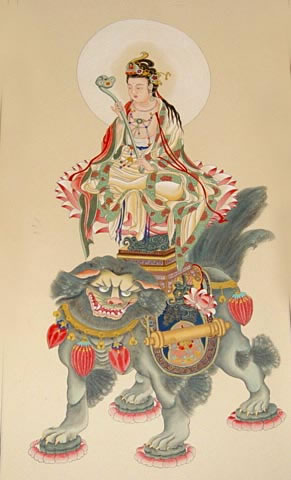
1) Danh từ Phạn ngữ có bốn nghĩa—A Sanskrit term with four
meanings:
· Thủ (đầu): High rank.
· Thắng (trội hơn, tốt đẹp hơn): Success.
· Cát Tường (tốt lành): Good—Good fortune—Prosperity.
· Đức: Virtues.
2) Tên vắn tắt của Ngài Văn Thù Sư Lợi: An abbreviation for the
name of Manjusri.
3) Một tiếp đầu ngữ hay tiếp vĩ ngữ có nghĩa là danh dự hay được
tôn vinh trước tên các vị Thần, các bậc vĩ nhân, hay những quyển sách
quý: An honorific prefix or affix to names of gods, great men, and
books.
4) Tên của vợ của Thần Visnu: Name of the wife of Visnu.
Thi Lợi Ca (Già) Na: Sriguna (skt)—Hậu Đức, một danh hiệu của
Phật—Abundantly virtuous, a title of a Buddha.
Thi Lợi Cúc Đa,尸利毱多, Srigupta
(skt)—Thi Lợi Quật Đa—Thất Lợi Cúc Đa—Tên một vị trưởng giả ở thành
Vương Xá, người đã dùng hầm lửa và cơm trộn thuốc độc định hại Phật,
nhưng không thành. Ông bèn quy y theo Phật—An elder in Rajagrha, who
tried to kill the Buddha with fire and poison, but he failed. He then
took refuge in the Triratna.
Thi Lợi Dạ,尸利夜, Sriyasas (skt)—Vị
Thần mang đến sự kiết tường—A god who bestows good luck
Thi Lợi Mật Đa La,尸利蜜多羅, Srimitra
(skt)—Một hoàng thái tử Ấn Độ, người đã thoái vị nhường ngôi cho em
mình, rồi xuất gia đi tu, sang Tàu, dịch bộ “Quán Đảnh” và các kinh
khác—An Indian prince who resigned his throne to his younger brother,
became a monk, came to China, translated the Summit of Contemplation
and other books
Thi Lợi Phật Thệ,尸利佛逝, Sribhuja
(skt)—Tên nước Châu Mạt La Du tức nước Thi Lợi Phật Thệ ngày nay—Name
of Malaya which is now Sribhuja
Thi Lợi Sa,尸利沙, Sirisa—Acacia
Sirissa (skt)—Also called Thi Lợi Sắc, Sá Lợi Sa, Dạ Hợp Thụ, Hợp Hôn
Thụ—Sa La Thụ—Cây Hợp Hôn, có hai loại—The marriage tree. There are two
kinds
1) Thi Lợi Sa: Loại có lá và quả to—Described as with large leaves
and fruit.
2) Thi Lợi Sử: Loại có lá và quả nhỏ—Described as with small leaves
and fruit.
Thi Lợi Sa Ca,尸利沙迦, Sirisaka
(skt)—Tên của một vị sư—Name of a monk
Thi Ma Xá Na,尸摩舍那, Smasana (skt) or
Asmasayana (skt)—Một nghĩa địa trong vùng Thi Đà Lâm—A cemetery in
Sitavana
Thi Quỷ,屍鬼, Quỷ tử thi, được
dựng dậy và sai đi giết hại kẻ thù (đây là một thứ chú thuật của ngoại
đạo)—A corpse-ghost, called up to kill an enemy
Thi Thành,尸城, Kusinagara or
Kusigramaka (skt)—Tên tắt của thành Câu Thi Na, thuộc Vương Quốc cổ Ấn
Độ, gần thành Kasiah, nơi Đức Phật nhập diệt, và cũng là nơi sanh của
chín học giả nổi tiếng ở Ấn Độ—Belonged to an ancient Indian Kingdom,
near Kasiah, the place where Sakyamuni died, also the birth place of
nine famous scholars
Video Kusinagara
Video Hanh Huong
Phat
Tich (Cau Thi Na )
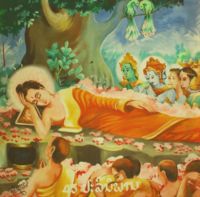
Thi Thố: To perform—To realize.
Thi Tỳ Ca,尸毘迦, Sivi (skt)—Thi Tỳ
Già—Theo Đại Trí Độ Luận, Thi Tỳ Ca là một trong những tiền thân của
Đức Phật, người đã từng cắt thịt mình bố thí cho chim bồ câu—According
to the sastra on Prajna-Paramita Sutra, Sivi was one of Sakyamuni’s
former incarnations, when to save a life of a dove he cut off and gave
his own flesh to an eagle which pursued it, which eagle was Siva
transformed in order to test him
Thí:
1) Bố thí: Dana (skt)—To give alms—To bestow—To give—Charity—See Bố
Thí in Vietnamese-English Section, and Dana in Sanskrit/Pali-Vietnamese
Section.
2) Thí dụ:
a) So sánh: To compare—To
allegorize—Resembling—Parable—Metaphor—Simile.
b) A-Ba-Đà-Na: Lấy pháp mình đã biết để làm sáng tỏ cái pháp chưa
biết—The avadana section of the canon
3) Thí phát: Cạo tóc—To shave the hair.
Thí Ân: See Thi ân.
Thí Chẩn: See Thí.
Thí Chủ,施主, Danapati (skt)—Tiếng
Phạn gọi là Đàn Viêt Bát Để
1) Người chủ làm việc bố thí, người tự mình bỏ ra của cải để cúng
dường: An almsgiver.
2) Người hộ trì Phật pháp: A patron of Buddhism.
A Ba Đà Na,阿波陀那, See Thí (2)
Thí Dụ Luận Sư,譬喩論師, Nhật Xuất Luận
Giả—Thí Dụ Sư—Vị tổ đầu tiên của Kinh Lượng Bộ (trong số 18 bộ Tiểu
Thừa)—Reputed founder of the Sautrankita school
Thí Dụ Lượng,譬喩量, Những thí dụ trong
kinh điển theo lý luận giúp người hiểu được giáo lý—The example in
logic
Thí Dụ Sư,譬喩師, See Thí Dụ Luận Sư
Thí Hành: Hành pháp bố thí (tài thí, pháp thí, và vô úy thí)—The
practice of charity—See Tam Bố Thí, Tứ Bố Thí, Ngũ Bố Thí, Thất Bố Thí,
and Bát Bố Thí.
Thí Hóa,施化, Bố thí chân lý giáo
hóa chúng sanh, hay bố thí và giáo hóa—To bestow the transforming truth
Thí Hộ,施護, Danapala (skt)—Vị
Tăng xứ Udyana, người đã dịch 111 bộ kinh sang Hoa ngữ. Năm 982 sau Tây
Lịch, ngài được ban tước hiệu Minh Tín Đại Sư—A native of Udyana who
translated into Chinese some 111 works. In 982 A.D. he received the
title of Great Master and brilliant expositor of the faith
Thí Huệ,施惠, To bestow kindness,
or charity
Thí Khai Phế,施開廢, Theo Kinh Pháp
Hoa, đây là từ mà tông Thiên Thai dùng để chỉ ba thời giáo thuyết của
Đức Phật—According to the Lotus Sutra, this is a term which the
T’ien-T’ai sect used to indicate the three periods of Buddha’s teaching
1) Thí Thời: Trước thời kỳ Pháp Hoa, Đức Phật đã nói về Tam thừa
giáo, đây Ngài chỉ dùng phương tiện thiện xảo để giúp người đi vào
Chánh Đạo Nhất Thừa Giáo, nên gọi là “vị thực thí quyền”—Bestowing the
truth in Hinayana and other partial forms.
2) Khai Thời: Thờ kỳ Đức Phật “khai quyền hiển thực” để giúp chúng
sanh hiểu rõ Tam Thừa chỉ là phương tiện của Nhất Thừa—Opening of the
perfect truth like the Lotus, as in the Lotus Sutra.
3) Phế Thời: Đức Phật chỉ dạy nên “phế quyền lập thực” một khi đã
biết rõ Tam Thừa chỉ là phương tiện cho Nhất Thừa—Abrogating the
earlier imperfect forms.
Thí Lâm,施林, Một trong bốn cách
tống táng, lâm táng, hay tống táng bằng cách đem xác người chết bỏ vào
trong rừng—One of the four kinds of burial, to give to the forest, i.e.
burial by casting the corpse into the forest
Thí Mạng: To risk (venture) one’s life.
Thí Nghịch: To kill a superior.
Thí Phát: Cạo tóc theo như Đức Phật Thích Ca, người đã dùng lưỡi
gươm bén cắt bỏ tóc hàm ý cắt đứt mọi hệ lụy với trần thế—To shave the
hair, following Sakyamuni, who cut off his locks with a sharp sword or
knife to signify his cutting himself off from the world.
Thí Tài,施財, Tài thí—To give
money to the poor
Thí Tăng,施僧, Cúng dường một vị
Tăng—To give alms to a monk
Thí Thân: To sacrifice one’s life.
Thí Thiết,施設, Thiết lập hay bắt
đầu—To start, to establish, or to set up
Thí Thiết Luận Bộ,施設論部, Karmikah
(skt)—Trường phái chủ trương trì giới vượt trên kiến thức—The school of
Karma, which taugh the superiority of morality over knowledge
Thí Thực,施食,
1) Cúng dường thức ăn cho chư Tăng: To bestow food on monks.
2) Bố thí thức ăn cho quỷ đói: To bestow food on hungry ghosts.
Thí Vô Úy,施無畏, Abhayandada or
Abhayadana (skt)—Còn gọi là Thí Vô Úy Giả hay Thí Vô Úy Tát Đỏa.
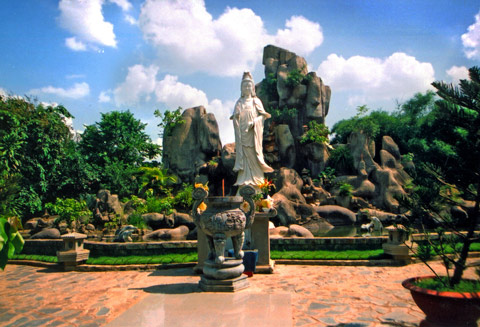
1) Người bố thí sự vô úy: Làm cho người khác không còn lo âu sợ
hãi—The bestower of fearlessness.
2) Một danh hiệu của Đức Quán Thế Âm (vì ngài là chỗ nương tựa của
chúng sanh, khiến họ không còn sợ hãi nữa): A title of Kuan-Yin.
3) Một vị Bồ Tát trong Thai Tạng Giới: A bodhisattva in the
Garbhadhatu.
Thí Vô Yếm Tự: See Na Lan Đà Tự.
Thỉ Chung: Beginning and end.
Thỉ Đam Tử,屎擔子, Gánh phân, ý nói
thân nguời trong chứa đầy phân mà con người phải luôn gánh nó đi khắp
nơi—A load of night-soil, i.e. the human body that has to be carried
about
Thỉ Phẩn Địa Ngục,屎糞地獄, Địa ngục chứa
đầy phân hôi thúi—The excrement hell
Thỉ Thạch,矢石, Mũi tên và đá là hai
thứ chống chọi lại với nhau vì tên không xuyên qua đá được—Arrow and
rock are two incompatibles, for an arrow cannot pierce a rock
Thị:
1) Là—Đúng: To be—Right.
2) Là: The verb to be, i.e. is, are, was, were, etc.
3) Chợ hay nơi hội họp công cộng: A market—A fair—An open place for
public assembly.
4) Mê: To be fond of—Given up to.
5) Nhìn thấy: To look—To see—To behold.
6) Thông báo: To indicate—To notify—To proclaim.
7) Trông coi: To attend—To wait on—Attendant.
Thị Cảm: Visual sensation.
Thị Chư Pháp Không Tướng, Bất Sanh Bất Diệt: There is no appearance
and disappearance of real dharmas—Real dharmas are bare manifestations.
They neither appear nor disappear.
Thị Diễn Đắc Ca,市演得迦, Jetaka (skt)—Sa
Đa Bà Hán Na—Sadvahana (skt)—Quốc vương của xứ Nam Kosala—A king of
southern Kosala, patron of Nagarjuna
Thị Dục: To desire.
Thị Giả,侍者, Người giúp đỡ như
ông A Nan làm thị giả cho Đức Phật—Companion—Attendant—Servant—Helper,
e.g. as Ananda was to the Buddha
Thị Giác:
1) Vision.
2) Initial enlightenment.
Thị Giáo,示教, To point out and
instruct.
Thị Hiện,示現, Pakasati
(p)—Vyaktaya (skt)—Bày tỏ ra ngoài—To manifest—To make manifest
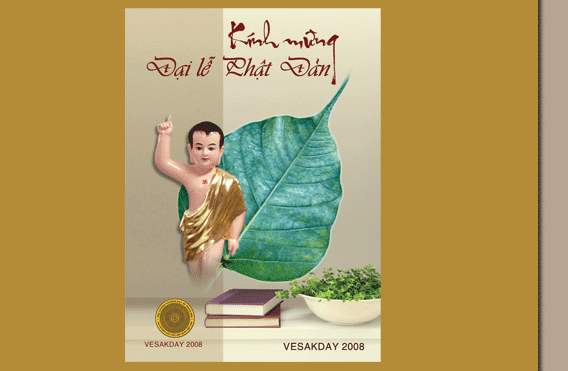
Thị Hiếu: Taste—Fondness—Desire—Liking.
Thị Lực: Power of eyesight (vision--seeing).
Thị Na Da Xá,嗜那耶舍, Jinayasas
(skt)—Một vị Tăng nổi tiếng người Ấn—A noted monk from India
Thị Oai: Thị uy—To display (show) one’s force—To intimidate—To
concuss.
Thị Phi,是非, Gossips of right and
wrong
Thị Quan: Mắt—Organ of sight.
Thị Tâm Thị Phật,是心是佛, Tâm tức
Phật—This mind is Buddha—The mind is Buddha
Thị Tâm Tác Phật: This mind becomes Buddha.
Thị Thế: To rely upon one’s influence.
Thị Thực: To attest—To certify.
Thị Tịch,示寂, Thị hiện niết bàn—To
indicate the way of nirvana
Thị Xứ Phi Xứ Lực,是處非處力, Khả năng biết
sự lý đúng hay không đúng, một trong Thập Lực—The power to distinguish
right from wrong, one of the ten Buddha-powers—See Thập Lực (1)
Thích Ca,釋迦, Sakya (skt)—Theo
Eitel trong Trung Anh Phật Học Từ Điển, bộ tộc hay gia đình Thích Ca,
người ta nói từ Thích Ca lấy từ danh từ “Saka” có nghĩa là thực vật,
nhưng theo Hoa ngữ có nghĩa là mạnh, có sức lực, và được giải thích
bằng chữ “Năng.” Dòng họ Thích Ca đã rày đây mai đó (dân du mục) dọc
theo thung lũng đồng bằng Ấn Hà,sau đó chiếm cứ một khu vực vài ngàn
dặm vuông nằm theo triền đồi xứ Népal và những vùng thảo nguyên về phía
nam. Kinh đô là thành Ca Tỳ La Vệ. Vào thời Đức Phật còn tại thế, bộ
tộc được đặt dưới sự quyền cai trị của Kosala, một vương quốc lân cận.
Về sau nầy, muốn cho vượt trội hơn Bà La Môn, những Phật tử đã dựng nên
một dòng họ huyền thoại—According to Eitel in The Dictionary of
Chinese-English Buddhist Terms, the clan or family of the Buddha, said
to be derived from Saka, vegetables, but interpreted in Chinese as
powerful, strong, and explained by “Neng.” The clan, which is said to
have wandered hither from the delta of the Indus, occupied a district
of a few thousand square miles lying on the slopes of the Nepalese
hills and on the plains to the south. Its capital was Kapilavastu. At
the time of the Buddha, the clan was under the suzerainty of Kosala, an
adjoining kingdom. Later Buddhists, in order to surpass Brahmans,
invented a fabulous line of five kings
(I) Một dòng họ huyền thoại Vivartakalpa khởi đầu bởi Thiên Tam
Muội Đa—A fabulous line of five kings of the Vivartaklapa headed by
Mahasammata.
(II) Theo sau đó là năm vị Luân Vương, và vị vua đầu tiên là Đảnh
Sanh Vương: Followed by five Cakravarti, the first being Murdhaja.
(III) Theo sau đó là mười chín (19) vua khác, bắt đầu với vua Xả Đế
và cuối cùng là vua Đại Thiên—Then came nineteen kings, the first being
Catiya, the last Mahadeva.
(IV) Sau đó được kế vị bởi các triều đại của 5.000 vị vua—These
were succeeded by dynasties of 5,000 kings.
(V) 7.000 vị vua—7,000 kings.
(VI) 8.000 vị vua—8,000 kings.
(VII) 9.000 vị vua—9,000 kings.
(VIII) 10.000 vị vua—10,000 kings.
(IX) 15.000 vị vua—15,000 kings.
(X) Sau đó vua Cồ Đàm mở đầu 1.100 vị vua, cuối cùng bởi vua
Iksvaku, ngự trị vùng Potala—After which king Gautama opens a line of
1,100 kings, the last, Iksvaku, reigning at Potala.
(XI) Với dòng vua cuối cùng Iksvaku, người ta nói dòng Thích Ca
khởi đầu. Bốn người con của Iksvaku ngự trị vùng Ca Tỳ La Vệ. Thích Ca
Mâu Ni là dòng dõi bảy đời của Iksvaku. Về sau thành Ca Tỳ La Vệ bị Trì
Quốc tiêu diệt, bốn người sống sót của dòng họ lập nên những vương quốc
Udyana, Bamyam, Himatala, và Sambi—With Iksvaku, the sakyas are said to
have begun. His four sons reigned at Kapilavastu. Sakyamuni was one of
his descendants in the seven generations. Later, after the destruction
of Kapilavastu by Virudhaka, four survivors of the family founded the
kingdoms of Udyana, Bamyam, Himatala, and Sambi.
Thích Ca Bà,釋迦婆, Sakra (skt)—Thiên
vương.
Thích Ca Bồ Tát,釋迦菩薩,
Sakya-bodhisattva (skt)—Một trong những tiền kiếp của Phật Thích Ca—One
of the previous incarnation of the Buddha
Thích Ca Đề Bà nhân Đà La: Sakra-devendra or Sakro-devanamindra
(skt)—Thích Đề Hoàn Nhơn—Thích Đế (Indra).
Thích Ca Mâu Ni,釋迦牟尼, Sakyamuni
(skt)—
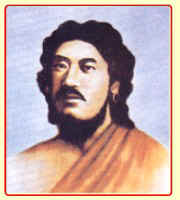
Video Life of the
Buddha (BBC)
Video Vi Sao Theo
Phat (Thich Nhat Tu)
Video Wisdom of the
Buddha
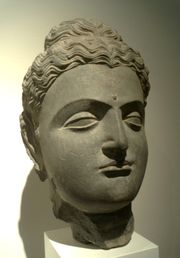
1) Đức Phật lịch sử, người đã sanh ra trong dòng họ Thích Ca—Nhà
Thông Thái của dòng họ Thích Ca—Phật Thích Ca Mâu Ni, vị Phật lịch sử
đã sáng lập ra Phật giáo. Ngài tên là Cồ Đàm Sĩ Đạt Đa, đản sanh năm
581-501 trước Tây lịch, là con đầu lòng của vua Tịnh Phạn, trị vì một
vương quốc nhỏ mà bây giờ là Nepal và kinh đô là Ca Tỳ La Vệ. Vào tuổi
29 Ngài lìa bỏ cung điện và vợ con, ra đi tìm đường giải thoát chúng
sanh. Vào một buổi sáng lúc Ngài 35 tuổi, Ngài đã thực chứng giác ngộ
trong khi đang thiền định dưới cội Bồ đề. Từ đó về sau, Ngài đã đi khắp
các miền Ấn Độ giảng pháp giúp người giải thoát. Ngài nhập diệt vào năm
80 tuổi—Sakyamuni Buddha—The historical Buddha, who was born into the
Sakya clan—The Sage of the Sakyas—A title applied to the
Buddha—Historical founder of Buddhism, Gautama Siddhartha, the Buddha
Sakyamuni, who was born in 581-501 BC as the first son of King
Suddhdana, whose small kingdom with the capital city of Kapilavastu was
located in what is now Nepal. At the age of twenty nine, he left his
father’s palace and his wife and child in search of the meaning of
existence and way to liberate. One morning at the age of thirty five,
he realized enlightenment while practicing meditation, seated beneath
the Bodhi tree. Thereafter, he spent the rest 45 years to move slowly
across India until his death at the age of 80, expounding his teachings
to help others to realize the same enlightenment that he had.
Thích Ca Sư Tử,釋迦獅子, Sakyasimha
(skt)—The lion of the Sakyas, i.e. the Buddha.
Thích Ca Tôn,釋迦尊, Bậc Chí Tôn của
dòng họ Thích Ca, ý nói Phật Thích Ca—The honoured one of the Sakyas,
i.e. Sakyamuni
Thích Ca Văn: Thích Ca Văn Ni—Sakyamuni, the saint of the Sakya
tribe—See Thích Ca Mâu Ni.
Thích Ca Văn Ni,釋迦文尼, See Thích Ca Mâu
Ni
Thích Chí: Satisfied—Content—Pleased.
Thích Chủng,釋種, Chủng tử Thích Ca—Bộ
tộc Thích Ca hay những đệ tử của Thích Ca, đặc biệt là chư Tăng Ni—The
Sakya-seed—The Sakya clan—The disciples of Sakyamuni, especially monks
and nuns
Thích Cung,釋宮, Cung điện Thích Ca,
chính từ nơi đó Thái Tử Sĩ Đạt Đa đã ra đi tìm đạo và đã thành Phật—The
Sakya palace, from which prince Siddhartha went forth to become Buddha
Thích Đảo,踢倒, Đá lộn nhào—To kick
over
Thích Đế,
釋帝, Sakra or Indra
(skt)—Đế vương của ba mươi ba tầng trời—Lord of the thrity three
Heavens
Thích Đề Hoàn Nhơn: Sakro-devanamindra or Indra (skt)—Trời Đế
Thích, cai trị cõi trời ba mươi ba tầng, được Phật tử coi như thấp hơn
Phật, nhưng lại là một vị thiên long hộ pháp—Sakra the Indra of the
devas, the sky-god. The god of the nature-gods, ruler of the
thirty-three heavens, considered by Buddhists as inferior to the
Buddhist saint, but as a deva-protector of Buddhism.
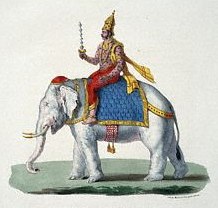
Thích Điển,釋典, Kinh điển Thích
Giáo—The scriptures of Buddhism
Thích Gây Gỗ: To be quarrelsome.
Thích Gia,釋家,
1) Người thuộc gia đình Thích Ca—The Sakya family.
2) Người giảng kinh nói pháp: The expounders of Buddhist sutras or
scriptures.
Thích Giáo,釋教, Phật
Giáo—Buddhism—The teaching of the Buddha (Sakyamuni)
Thích Hóa,適化, Thích ứng sự giáo
hóa vào hoàn cảnh thật—To adapt teaching to circumstance
Thích Hợp: Rational—Suitable—Appropriate—Fitting—To suite—To fit—To
be consonant (agreeable) with.
Thích Hùng,釋雄, Buddha, the hero of
the Sakyas
Thích Khẩu: Pleasant to the taste.
Thích Khen Ghét Chê: Fond of praise, but loathing of criticism.
Thích Luân,釋輪, Một biểu hiện của
đất hay địa luân—Sakra’s wheel, the discuss of Indra, symbol of the
earth
Thích Luận,釋論, The
Prajna-paramita-sutra; explanatory discussions, or notes on foundation
treaties—See Bát Nhã Ba La Mật Đa Tâm Kinh (Prajan Paramita Sutra)
Thích Lữ,釋侶, Tín đồ Phật
giáo—Tăng lữ—Follower or disciple of the Buddha—Buddhist
comrade—Buddhists
Thích Ma Nam,釋摩男, Sakya-Mahanama
Kulika (skt)—Thái tử Kulika, một trong năm vị đệ tử đầu tiên của
Phật—One of the first five of the Buddha’s disciples, prince Kulika
Thích Mạc,適莫,
1) Bênh vực và chống đối: Pro and con.
· Thích: Thích ý, vui thích, hay bênh vực—Pro.
· Mạc: Không thích ý, không vui thích, hay chống đối—Con.
2) Thuận và nghịch: According and contrary (to wishes).
· Thích: Thuận—According.
· Mạc: Nghịch—Contrary.
Thích Mệnh: The sovereign commands of the Buddha.
Thích Môn,釋門, Phật Giáo—Cửa dẫn
vào Thích giáo—The School of Sakyamuni—Buddhism
Thích Na: Ratna (skt)—Bảo (vật quí)—Precious thing—Jewel.
Thích Na Già La: Ratnakara (skt).
1) Kho báu vật: A jewel mine—The jewel heap.
2) Tên của một cư dân cùng thời với Đức Phật trong thành Tỳ Xá Lê:
Name of a native of Vaisali, contemporary of Sakyamuni.
3) Tên của vị Phật hay Bồ Tát: Name of a Buddha or Bodhisattva.
4) Tên của vị Phật thứ 112 trong hiền kiếp: Name of the 112th
Buddha of the present kalpa.
Thứ Na Thi Khí,刺那尸棄, Ratnasikhin
(skt)—See Thi Khí (3) and (4)
Thích Nghi,釋疑,
1) Giải thích những nghi nan: Explanation of doubtfull
points—Solution of doubts.
2) Thích hợp: Appropriate—Suitable.
Thích Nữ,釋女,
1) Những người nữ trong dòng họ Thích Ca: The women of the Sakya
clan.
2) Những vị nữ tu trong đạo Phật: Nuns in Buddhism.
Thích Phạm,釋梵, Đế Thích và Phạm
Thiên, cả hai đều là chư thiên hộ pháp—Indra and Brahma (both
protectors of Buddhism)
Thích Phong,釋風, Phong tục Phật
Giáo—The custom of Buddhism
Thích Sư,釋師, Đạo Sư Thích
Ca—Phật—The Sakya Teacher—Buddha
Thích Sư Tử,釋師子, Sư tử Thích Ca, ý
nói Đức Phật—The lion of the Sakyas, Buddha
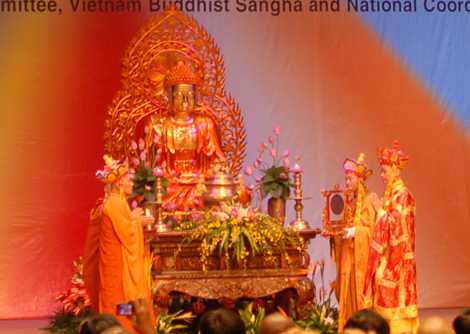
Thích Tàn Bạo: To be fond of cruelty.
Thích Tạng,釋藏, The tripitaka—The
Buddhist scriptures—The Sakya thesaurus
Thích Thị: Họ của bộ tộc Thích Ca—The Sakya clan or family name.
Thích Thú: Pleasant—The tone of pleasure—Interesting.
Thích Tử,釋子, Sakyaputriya
(skt)—Con Phật, chỉ một vị Tăng, học và thực hành giáo lý nhà
Phật—Buddha’s son—Monk—A person who understands and practice deeply the
philosophy (teaching) of Buddhism
Thích Ứng: Adaptability—Appropriate—The adaptability of body,
mental factors and consciousness.
Thích Ứng Với Mọi Người: To get along with people.
Thích Ý: Agreeable—Satisfied—Content—Pleased.
Thiêm: Thêm vào—To add—To increase—Additional.
Thiêm Phẩm,添品, Phẩm được thêm
vào—Additional chapter or chapters
Thiêm Thiếp: To be asleep.
Thiểm:
1) Ánh sáng lấp lóe: Flash.
2) Tránh hay lách sang một bên: To get out of the way.
Thiểm Đa,閃多, Quỷ—A demon, one of
Yama’s names.
Thiểm Điện Quang,閃電光, Ánh chớp lóe lên,
dùng để ví với sự mau lẹ mãnh liệt của sự việc—Lightening-flashing,
therefore awe-inspiring.
Thiệm: Trợ cấp—To supply—Supplied.
Thiệm Bộ,贍部, Jambu (skt)—Một loại
cây ăn trái ở Ấn Độ (hồng táo)—A fruit tree in India (a rose apple)
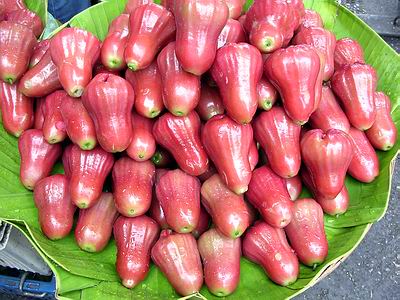
Thiệm Bộ Châu,贍部洲, See Thiệm Bộ Đề
Thiệm Bộ Đề: Nam Thiệm Bộ Châu,Jambudvipa.
Thiệm Bộ Kim,贍部金, Jambunada
(skt)—Dòng sông Jambunadi sản sanh ra vàng—The produce of gold from the
River Jambunadi
Thiệm Bộ Nại Đà
Kim,贍部捺陀金,
Jambunada-suvarna (skt)—Diêm Phù Na Tha—Diêm Phù Tàn Kim—Vàng nơi sông
Thiệm Bộ Nại Đà—The gold from the Jambunadi river
Thiệm Bộ Quang Tượng: Tôn tượng rực rỡ, đặc biệt là tôn tượng của
Phật Thích Ca được Ngài Cấp Cô Độc cho đúc—An image of gold glory,
especially the image of Sakyamuni attributed to Anathapindaka.
Thiên:
I) Bài văn hay quyển sách: A Text or a book.
II) Nghiêng về một bên hay thiên lệch: On one
side—Biased—Partial—Prejudiced—Deflected—One-sided.
III) See Deva.
IV) Dọn đi: To move—To remove.
V) Từ mà người Đông Á dùng để gọi Trời: A term which Eastern Asian
peoples used to call “Heaven.”
VI) The sky—The heavens of the gods—The Pure Buddha-Land—Sahasra
(thousand). There are many different heavens:
(A) Sơ Thiền Thiên (See Tứ Thiền thiên in Vietnamese-English
Section):
1) Phạm Phụ thiên: Brahma-parisadya (p)—The realm of Brahma’s
retinue.
2) Phạm Chúng thiên: Brahma-purohita (p)—The realm of Brahma’
ministers.
3) Đại Phạm thiên: Mahabrahma (p)—The realm of the great Brahmas.
(B) Nhị Thiền Thiên (See Tứ Thiền Thiên):
4) Diệu Quang thiên hay Thiểu Quang Thiên: Parittabha (p)—Cõi trời
có ít ánh sáng nhất trong cõi Nhị Thiền—Minor Light—The realm of minor
lustre.
5) Vô Lượng Quang thiên: Cảnh giới của những vị Phạm Thiên có ánh
sáng vô cùng và vô hạn định—Apramanabha (p)—Infinite Light—The realm of
infinite lustre.
6) Cực Quang Tịnh thiên: Quang Âm Thiên—Cảnh giới của những vị Phạm
Thiên có ánh sáng rực rỡ sáng lòa hơn hai cõi trời trên, chiếu khắp mọi
nơi. Ở đấy không nghe thấy âm thanh nào; khi các cư dân muốn nói
chuyện, một tia sáng thanh tịnh thoát ra khỏi miệng được dùng như ngôn
ngữ—Abhasvara—Utmost Light-Purity—The realm of the radiant Brahmas.
There are no sounds heard in this heaven; when the inhabitants wish to
talk, a ray of pure light comes out of the mouth, which serves as
speech.
(C) Tam Thiền Thiên (See Tứ Thiền thiên):
7) Thiểu Tịnh thiên: Cảnh giới của những vị Phạm Thiên có hào quang
nhỏ—Parittasubha (p)—Minor Purity—The realm of the Brahmas of minor
aura.
8) Vô Lượng Tịnh thiên: Cảnh giới của những vị Phạm Thiên có hào
quang vô cùng, vô hạn định—Apramanasubha (p)—Infinite Purity—The realm
of the Brahmas of infinite aura.
9) Biến Tịnh thiên: Cảnh giới của những vị Phạm Thiên có hào quang
vững chắc không lay động—Subhakrusna (p)—Universal Purity—The realm of
the Brahmas of steady aura.
(D) Tứ Thiền Thiên (See Tứ Thiền thiên):
10) Phúc Sanh thiên: Punyaprasava—Felicitous birth.
11) Vô Vân thiên: Anabhraka—Cloudless.
12) Quảng Quả thiên: Cảnh trời của những vị Phạm Thiên hưởng quả
rộng lớn—Brhatphala—Vehapphala (p)—Large fruitage—The realm of the
Brahmas of great reward.
13) Vô Phiền thiên:Asanjnisattva—No vexations, or free of trouble.
14) Vô Nhiệt thiên: Avrha—No heat.
15) Thiện Kiến thiên: Atapa—Beautiful to see.
16) Thiện Hiện thiên: Sudrsa—Sudassa (p)—Beautiful appearing—The
beautiful realm.
17) Sắc Cứu Cánh thiên: Sudarsana—The end of form.
18) Vô Tưởng thiên: Akanistha—The heaven above thought—The realm of
mindless beings.
(E) Chư thiên khác: Other devas:
19) Quang Âm thiên: Abhasvara—Light-sound heavens.
20) Cực Quang Tịnh thiên: The heavens of utmost light and purity
(one of the second dhyana heavens).
21) Địa Cư Thiên: Indra’s heaven on the top of Sumeru.
22) Không Cư Thiên: Heaven in space.
23) Tự Tại Thiên: Isvaradeva—King of the devas—God of Free Will—God
of Free Movement.
24) Diệu Hỷ Túc thiên: The heaven full of wonderful joy.
25) Biện Tài Thiên Nữ: Goddess of eloquence.
26) Diệu Âm Nhạc Thiên: Sarasvati—The wife or female energy of
Brahma—Biện Tài Thiên Nữ.
27) Đại Kiết Tường thiên: Mahasri.
** For more information, please see Tam
Chủng Thiên.
Thiên Ái,天愛, Devanampriya—Beloved
of the gods (natural fools, simpletons, or the ignorants)
Thiên Bách Ức Hóa Thân Phật: The hundred thousand myriad
Transformation bodies of the Buddha—Theo Kinh Pháp Bảo Đàn, Lục Tổ Huệ
Năng dạy về Thiên Bách Ức Hóa Thân Phật như sau: “Này thiện tri thức!
Sao gọi là Thiên Bách Ức Hóa Thân? Nếu chẳng nghĩ muôn pháp thì tánh
vốn như không, một niệm suy nghĩ gọi là biến hóa. Suy nghĩ việc ác là
hóa làm địa ngục, suy nghĩ việc thiện thì hóa làm thiên đường, độc hại
thì hóa làm rồng rắn, từ bi thì hóa làm Bồ Tát, trí huệ thì hóa làm
thượng giới, ngu si thì hóa làm hạ giới. Tự tánh biến hóa rất là nhiều,
người mê không hay tỉnh giác, mỗi niệm khởi ác thường đi trong con
đường ác, xoay về một niệm thiện, trí huệ liền sanh, đây gọi là Tự Tánh
Hóa Thân Phật.”—According to the Dharma Jewel Platform Sutra, the Sixth
Patriarch taught: “Good Knowing Advisors! What are the hundred thousand
myriad Transformation bodies of the Buddha? If you are free of any
thought of the ten thousand dharmas, then your nature is basically like
emptiness, but in one thought of calculation, transformation occurs.
Evil thoughts are being tranformed into hell-beings and good thoughts
into heavenly beings. Viciousness is transformed into dragons and
snakes, and compassion into Bodhisattvas. Wisdom is transformed into
the upper realms, and delusion into the lower realms. The
transformations of the self-nature are extremely many, and yet the
confused person, unawakened to that truth, continually gives rise to
evil and walks evil paths. Turn a single thought back to goodness, and
wisdom is produced. That is the Transformation-body of the Buddha
within your self-nature.”
Thiên Bẩm: Inborn—Innate.
Thiên Bộ: The classes of devas—The host of devas—The host of
heaven.
Thiên Bộ Luận Sư,千部論師, Ngài Long Thọ Bồ
Tát viết 1000 (thiên) bộ luận. Thế Thân hay Thiên Thân Bồ Tát căn cứ
vào Tiểu Thừa mà viết 500 bộ luận Tiểu Thừa, rồi sau đó lại viết thêm
500 bộ luận Đại Thừa—Master of a thousand sastras, a title for
Nagarjuna (Long Thọ) and Vasubandhu (Thế Thân Bồ Tát).

Video Nagarjuna:
Founder of Mahayana Buddhism
Thiên Bộ Thiện
Thần,天部善神,
Thiên bộ thiện thần gồm Phạm thiên, Trời Đế Thích, Tứ thiên vương và
các vị long thần hộ pháp khác—Brahma, Indra, the four devaloka-rajas,
and the other spirit guardians of Buddhism
Thiên Cái,天蓋, A Buddha’s canopy,
or umbrella—A nimbus of rays of light—A halo
Thiên Căn,天根, Tượng Dương Vật của
Thần Siva, mà Huyền Trang đã tìm thấy trong các đình miếu ở Ấn Độ; ông
nói rằng những người Ấn Giáo đã “sùng bái tượng nầy không biết
ngượng”—The phallic emblem of Siva, which Hsuan-Tsang found in the
emples of India; he says the Hindus “worship it without being ashamed.
Thiên Cẩu,天狗, Ulka (skt)—The
heavenly dog—A meteor—A star in Argo
Thiên Chân,偏眞, Bhutatathata (skt)
1) Chân lý tự nhiên, không phải do con người tạo ra; chân như hay
bản tánh thật thường hằng nơi vạn hữu, thanh tịnh và không thay đổi,
như biển đối nghịch lại với sóng (bản chất cố hữu của nước là phẳng
lặng và thanh tịnh chứ không dập dồn như sóng)—Permanent reality
underlying all phenomena, pure and unchanged, such as the sea in
contrast with the waves.
2) Nghĩa lý về cái “không” của Tiểu Thừa chỉ thiên lệch về một bên
chứ không siêu việt như cái “không” của Đại Thừa: The Hinayana doctrine
of unreality, a one-sided dogma in contrast with transcendental reality
of Mahayana.
Thiên Chân Độc
Lãng,天眞獨朗,
Chân như là sự chiếu sáng duy nhứt. Đây là lời tuyên bố quả quyết của
Đạo Thúy thời nhà Đường với nhà sư Nhật Bản Truyền Giáo. Hiểu được cơ
bản của chân như sẽ làm sáng tỏ mọi thứ, kể cả Phật quả—The fundamental
reality, or the bhutatathata, is the only illumination. It is a dictum
of Tao-Sui of the T’ang to the famous Japanese monk Dengyo. The
apprehension of this fundamental reality makes all things clear,
including the universality of Buddhahood
Thiên Chân Phật,天眞佛,
1) Chân Như: The Bhutatathata—The real or ultimate Buddha.
2) Tên khác của Pháp thân Phật: Another name for the Dharmakaya,
the source of all life.
Thiên Chấp,偏執, Chấp về một phía—To
hold firmly to a one-sided interpretation.
Thiên Chủ,天主, Devapati (skt)—Thiên
chủ của chư Thiên, danh hiệu của trời Đế Thích, thiên chủ của cõi trời
dục thiên thứ sáu—The lord of devas, a title of Indra—Lord of the sixth
heaven of desire. He is also opposing the Buddha-truth

Thiên Chủ Giáo
Pháp,天主教法,
Devendra-samaya (skt)—Giáo pháp của Thiên Chủ—Doctrinal method of the
lord of devas—A work on royalty in the possession of a son of
Rajabalendraketu
Thiên Chúa Giáo:
Christianity—
Phat Giao-Ki To
Giao Doi Chieu
Video Phat, Chua va
Ma (Thich Nhat Tu)
Video Jesus
was a Buddhist (BBC)
Video Jesus
in Kashmir 1/3 (BBC)
Video Jesus
in Kashmir (BBC) 2/3
Video Jesus
in Kashmir (BBC) 3/3
Hai mươi thế kỷ trước,
chúa Giê Su đã sáng lập ra Thiên Chúa giáo, và tín đồ Thiên Chúa xem
chúa Giê Su như là con của Thượng đế. Đây là tôn giáo cải cách từ Do
Thái giáo, theo đó họ xem Đức Chúa Trời là vị duy nhất sanh ra trời,
đất, và vạn vật. Theo bộ Tân và Cựu Ước thì vũ trụ trước đây là một
khoảng mênh mông mù mịt. Nhờ quyền phép của Đức Chúa Trời mà trong bảy
ngày đã tạo thành mặt trời, mặt trăng, tinh tú, đất, nước, sông, cây
cối, người và vật. Vào ngày thứ bảy, Ngài lấy chút đất hà hơi thành ra
ông A Đam, đồng thời lấy chút đất khác cùng một miếng xương sườn rồi hà
hơi vào thành ra bà Ê Và. Hai người ấy lấy nhau và sống như vợ chồng
trong Vườn Địa Đàng. Sau vì phạm tội ăn trái cấm trong vườn nên cả hai
bị đày xuống cõi trần làm thủy tổ loài người. Từ đó con cháu loài người
đều bị bó buộc trong tội tổ tông truyền. Theo giáo lý đạo Thiên Chúa
thì ai biết tôn trọng, kính thờ, và vâng lời Chúa sẽ được lên Thiên
Đàng đời đời sống hạnh phúc; trái lại sẽ bị đọa xuống địa ngục—Twenty
centuries ago, Jesus Christ, the founder of Christianity and regarded
by Christians as the son of God, reformed an old Hebrew religion
according to which God is the only creator of the universe and sentient
beings. From the Old and New Testaments, it is said that the universe
at the start was a dark and immense expanse. God with His supernatural
powers and magic created within seven days the sun, moon, stars, earth,
water, mountains, vegetation, man, and animals. On the seventh day of
creation, God breathed into the dust of the earth to create Adam. He
also created Eve by breathing into some dust mixed with the rib of
Adam. They were told to dwell in the Garden of Eden as husband and
wife. But after they had eaten the forbidden fruit of the Tree of
Knowledge of Good and Evil, they were evicted from the Garden and
condemned to live on earth as originators of mankind. From that time,
mankind had to suffer from the original sin. According to the Catholic
doctrine, whoever knows how to respect, venerate and obey God will be
saved to live happily in Heaven forever; those who do not will be
banished into Hell.
Thiên Chúng,天眾, The host of heaven,
includes Brahma, Indra, and all their host
Thiên Chúng Ngũ Tướng: Năm dấu hiệu tiến gần về sự chết của chư
thiên—The five signs of approaching demise (death) among the devas—See
Ngũ Suy.
Thiên Chức: Natural duty.
Thiên Ky,天機, Natural capacity—The
nature bestowed by Heaven
Thiên Cổ,天鼓,
1) Cổ xưa lâu đời: Antiquity.
2) Trống trời: Theo Phẩm 15 Kinh Hoa Nghiêm, ở Thiện Pháp Đường nơi
cõi Trời Đao Lợi có một cái trống chẳng đánh mà tự nhiên phát diệu âm,
cảnh báo chúng thiên trên cõi Trời nầy rằng đời vô thường và luôn bị
nghiệp báo chi phối. Chư Thiên trên tầng trời nầy nghe tiếng trống bèn
kéo nhau nghe Trời Đế Thích nói pháp vi diệu khiến họ đều phát tâm làm
lành lánh dữ. Do vậy chư Phật còn có danh hiệu là Thiên Cổ hay Trống
Trời. Lúc trống trời vang lên thì chúng ma đều sợ hãi bỏ chạy—According
to the Flower Adornment Sutra, Chapter 15, in the Good Law Hall of
Trayas-trimsas heavens, there is a deva-drum which sounds of itseft,
warning the inhabitants of the thirty-three heavens that even their
life is impermanent and subject to karma; at the sound of the drum
Indra preaches against excess. Hence it is a title of Buddhas as the
geat law-drum, who warns, exhorts, and encourages the good and
freightens the evil and demons. .
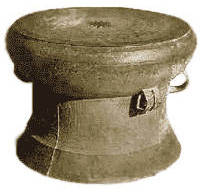
Thiên Cổ Âm,天鼓音, Vân Tự Tại Đăng
Vương—Dundubhisvara-raja (skt)—Lord of the sound of celestial drums,
such as thunder. Name of each of 2,000 kotis of Buddhas who attained
Buddhahood
Thiên Cổ Lôi Âm
Phật,天鼓雷音佛,
Cổ Âm Như Lai—Divyadundubhimeghanirghosa (skt)—Một trong năm vị Phật
trong Thai Tạng Giới Mạn Đà La, ở phía bắc của nhóm trung tâm. Người ta
nói đây là pháp thân hay “Đẳng Lưu” thân của Phật Thích Ca. Vị Phật nầy
cũng được biết đến như là Bất Động Tôn tương ứng với A Súc Bệ Phật—One
of the five Buddhas in the Garbhadhatu mandala, on the north of the
central group; said to be one of the dharmakaya of Sakyamuni or his
universal emanation body; it is known as Immutably-Honoured One
corresponding with Aksobhya.
Thiên Công: Eternalists believe that there exists a so-called
Creator who created all creatures.
Thiên Cung,天弓,
1) Cung của cõi trời: The deva bow—The rainbow.
2) Devapura—Devaloka—The palace of devas—The abode of the
gods—Heavenly palace.
3) Cung trời thứ sáu nằm trên núi Tu Di, giữa thế giới và Phạm
Thiên giới—The six celestial world situated above the Meru, between the
earth and the Brahmalokas.
4) The deva-bow—The rainbow.
** For more information, please see Thiên—Tam Chủng Thiên—Tứ Chủng
Thiên—Ngũ Chủng Thiên.
Thiên Cung Bảo
Tạng,天宮寳藏,
Thư viện chứa kinh tạng—Tàng kinh các—Tàng kinh các nơi cung trời Đâu
Suất trong cung của Đức Di Lặc—A library of the sutras—The treasury of
all the sutras in the Tusita Heaven in Maitreya’s palace
Thiên Cư:
1) The abode of the gods.
2) To change one’s residence.
Thiên Dân: Chư Thiên cư ngụ trên các cõi trời—Heavenly beings or
beings who live in the various Heavens—See Thiên.
Thiên Đản,偏袒, Hở một bên vai, như
mặc áo cà sa choàng qua vai phải và để hở vai trái. Đây là dấu hiệu của
sự tôn kính—Bare on one side, i.e. to wear the toga, or robe, over the
right shoulder, baring the other as a mark of respect
Thiên Đàng: Heaven.
Thiên Đao Lợi: See Trời Đao Lợi.
Thiên Đạo,天道, Deva-gati—Devasopana
(skt)
1) Cõi trời, cảnh giới cao nhất trong lục đạo, gồm 18 tầng trời sắc
giới và bốn tầng trời vô sắc giới. Một nơi hưởng phước, nhưng không là
nơi để tiến lên quả vị Bồ Tát—The highest of the six paths—The realm of
devas includes the eighteen heavens of form and four of formlessness. A
place of enjoyment, where the meritorious enjoy the fruits of good
karma, but not a place of progress toward bodhisattva perfection.
2) Đạo Trời: Đạo tự nhiên, lý tự nhiên, hay qui luật tự nhiên—The
Tao of Heaven—According to the Taoists, natural law or cosmic energy is
the origin and law of all things.
Thiên Đế,天帝,Indra
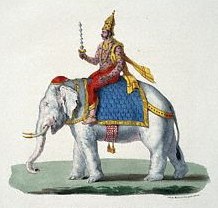
1) Vua của cõi Trời: King or emperor of Heaven—Heaven.
2) Nhân Đà La: Thích Ca—Thích Ca Bà—Indra.
3) Vua Trời Đế Thích, vua của cung trời Đao Lợi, một trong những vị
trời của Ấn Độ thời cổ. Vua cõi trời chiến đấu chống lại ma quỷ bằng
kim cang chùy. Phật giáo xem vị nầy như là vị trời hộ pháp, thấp hơn
Phật và các vị đã chứng ngộ Bồ Đề: Sakra, king of the devaloka. One of
the ancient gods of India, the god of the sky who fights the demons
with his vajra or thunderbolt. He is inferior to the trimurti, Brahma,
Visnu, and Siva, having taken the place of Varuna or sky. Buddhism
adopted him as its defender, though, like all the gods, he is
considered inferior to a Buddha or any who have attained bodhi.
Thiên Đế Sinh Lư Thai:
Thiên Đế thác sanh vào thai lừa—Theo Kinh
Pháp Cú kể lại, thì có một truyện tích kể lại vụ trời Đế Thích biết
mình sắp thác sanh vào thai lừa nên lòng buồn bã không nguôi. Người
khác bảo rằng muốn thoát khỏi cảnh nầy chỉ có cách là tin Phật. Trước
khi ông tới được Phật thì đã thác và thấy mình tái sanh vào bụng lừa.
Tuy nhiên, lời nguyện của ông đã có hiệu quả vì chủ lừa đánh lừa mẹ quá
mạnh đến sẩy thai và Thiên Đế được trở về kiếp cũ và lên gặp
Phật—According to the Dharmapada Sutra, Lord of devas, born in the womb
of an ass, a Buddhist fable, that Indra knowing he was to be reborn
from the womb of an ass, in sorrow sought to escape his fate, and was
told that trust in Buddha was the only way. Before he reached Buddha
his life came to an end and he found himself in the ass. His resolve,
however, had proved effective, for the master of the ass beat her so
hard that she dropped her foal dead. Thus Indra returned to his former
existence and began his ascent to Buddha.
Thiên Đế Thích,天帝釋, Đế Thích
Thiên—Trời Đế Thích, vị chúa tể của cung trời Đao Lợi cùng họ với Phật
Thích Ca—Sakra, king of the devaloka
Thiên Đế Thích
Thành,天帝釋城,
Còn gọi là Hỷ Kiến Thành hay Thiên Kiến Thành, thành của Thiên Đế, vua
của chư thiên. Thủ phủ của ba mươi ba tầng Trời Đế Thích. Cũng gọi là
Thiện Kiến Thành hay Hỷ Kiến Thành—The city of beautiful, or the city
of Sakra, the Lord of devas. The chief city or capital of the
thirty-three Indra-heavens. Also called the Sudarsana city good to
behold, or city a joy to behold
Thiên Địa Kính,天地鏡, The mirror of
heaven and earth (The Prajna-paramita sutra)
Thiên Định: Externalists believe in a so-called Determinism:
everything is predetermined by God.
Thiên Đô: To move the capital.
Thiên Đốc,天督, Một hình thức viết
sai của người Trung Hoa về chữ Ấn Độ—T’ien-Tu, an erroneous form of
Yin-Tu or India
Thiên Đồng,天童, Thiên đồng hộ pháp,
những thiên đồng sứ giả của chư Phật và chư Bồ Tát—Divine youths, such
as deva guardians of the Buddha-law who appear as Mercuries, or
youthful messengers of the Buddhas and Bodhisattvas
Thiên Đồng Sơn,天童山, Một nhóm tự viện
nổi tiếng gần núi Thiên Đồng, cũng được gọi là núi Thái Bạch; đây là
một trong năm núi nổi tiếng của Trung Quốc—A famous group of
monasteries in the mountain near Ningpo, also called Venus planet
mountain; this is one of the five famous mountains of China
Thiên Đức Bình,天德甁,
1) Bình chứa công đức của chư thiên: The vase of deva (divine)
virtue, i.e. the bodhi heart, all that one desires comes from it.
2) Như Ý Châu: The talismanic pearl.
3) Thiên Ý Thụ: Mỗi cõi trời dục giới đều có một cây Thiên Ý, sanh
ra tất cả những gì mà chư thiên mong muốn—The deva tree, the tree in
each devaloka which produces whatever the devas desire.
Thiên Đường,天堂, The mansions of the
devas, located between the earth and the Brahmalokas—The heaven
halls—Heaven.
Thiên Đường Địa
Ngục,天堂地獄,
The heavens and the hells, places of reward or punishment for moral
conduct
Thiên Giáo,偏教,
1) Quyền giáo: Partial or relative teaching.
2) Tông Thiên Thai cho rằng giáo thuyết Thiên Thai là “Viên Giáo,”
bao gồm hết tất cả những lời Phật dạy, trong khi Pháp Tướng và Tam Luận
chỉ là Quyền giáo. Tông nầy cũng xem ba giáo Tạng, Thông, Biệt là quyền
giáo—Partial or relative teaching; T’ien-T’ai regarded its own teaching
as the complete, or final and all-embracing teaching of the Buddha,
while that of Madhyamika school of Nagarjuna and Dharmalaksana schools
were partial and imperfect; in like manner, the three schools of
Pitaka, Intermediate, and Separate were also partial and imperfect.
** For more information, please see Quyền
Giáo in Vietnamese-English Section.
Thiên Giới,天界, See Thiên Đạo
Thiên Giới Lực Sĩ,天界力士, See Thiên Đạo
Thiên Hạ,天下, People—The whole
world
Thiên Hạnh: A bodhisattva’s natural or spontaneous correspondence
with fundamental law. One of the five natures of Bodhisattvas in the
Nirvana Sutra (Kinh Niết Bàn).
Thiên Hậu,天后, Queen of Heaven
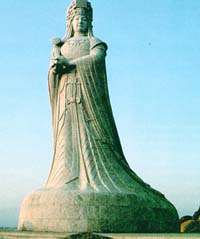
Thiên Hình Vạn Trạng: Multiform.
Thiên Hoa,天花, Thiên hoa được kể
trong Kinh Pháp Hoa có bốn loại—Deva or divine flowers, stated in the
Lotus Sutra as of four kinds:
1) Mạn Đà La (màu trắng): Mandaras (white in color).
2) Ma Ha Mạn Đà La (màu trắng): Mahamandaras (white in color).
3) Mạn Thù Sa (màu đỏ): Manjusakas (red in color).
4) Ma Ha Mạn Thù Sa (màu đỏ): Mahamanjusakas (red in color).
Thiên Hóa,遷化, Chết—To pass away—To
be taken away—To die
Thiên Họa,天畫, Deva lines or
pictures
Thiên Hoàng,天皇, Deva-king
Thiên Hoàng Tự: Chùa Thiên Hoàng nơi trụ trì của Sư Đạo Ngộ dưới
thời nhà Đường—T’ien-Huang monastery where Tao-Wu master resided during
the T’ang dynasty.
Thiên Hưng: Tên của một
ngôi chùa cổ ở Huế, Trung Việt. Chưa biết
thời điểm xây dựng chùa, chỉ biết năm Minh Mạng thứ 6 (1825), chùa
Thiên Hưng chỉ là một thảo am. Năm 1893, chùa được sư Thanh Chân, tức
là đại sư Viên Giác sau nầy, phát nguyện trùng tu, với sự hỗ trợ của
một mệnh phụ tên là Tôn Nữ Thanh Lương. Do đó chùa đã thay đổi cảnh sắc
và qui mô, chuyển tranh thành ngói, và có pháp khí tốt đẹp, tượng đồng
được đúc, tượng gỗ được thếp vàng lại, làm cho cảnh chùa sáng sủa hơn.
Năm 1911, Hòa Thượng Thanh Tú cùng với đồ đệ và giáo hội đã trùng tu
lại chùa, khiến cho cảnh chùa uy nghi tráng lệ hơn xưa. Vào năm 1927,
Hòa Thượng Quảng Tu trùng tu chánh điện. Năm 1935, chùa được ban biển
ngạch sắc tứ và Hòa Thượng được ban giới đạo độ điệp. Chùa Thiên Hưng
hiện vẫn còn giữ được hệ thống tượng thờ từ cuối thế kỷ thứ 19—Name of
an ancient temple in Huế, Central Vietnam. The date of building of the
temple is unknown. It is merely recorded that in the sixth year of king
Minh Mạng’s reign, Thiên Hưng temple was only a thatched house. In
1893, a monk named Thanh Chân, later he became great master Viên Giác,
committed himself to rebuild the temple with the assistance of a noble
lady named Tôn Nữ Thanh Lương. As a result, the appearance and
structure of the temple were changed considerably. Thatch was changed
to tiles, bronze statues were introduced and some wooden statues were
gilded, giving the temple a brighter look. In 1911, Most Venerable
Thanh Tú together with his disciples and the congregation, rebuilt the
temple, giving it a more impressive and magnificent appearance. In
1927, Most Venerable Quảng Tu rebuilt the main hall. In 1935, Thiên
Hưng temple was recognized as national temple by the throne and Most
Venerable Quảng Tu was honoured by the king with “Giới Đạo Độ Điệp.”
The temple still remains its system of statues from the late nineteenth
century.
Thiên Hương,天香, Deva
incense—Celestial perfume—Divine or excellent incense
Thiên Hướng: Tendency—Inclination.
Thiên Hữu,天有, Existence and joy as
a deva, derived from previous devotion, the fourth of the seven forms
of existence
Thiên Hữu Chấp: Kiến giải thiên về một bên cho vạn hữu là có và
chấp chặt vào đó—Strong attachment to the idea of a real existence of
all things.
Thiên Khẩu,天口, Miệng Trời—Phép của
Bà La Môn coi lửa là miệng trời, hỏa thiêu vật cúng thì chư Thiên được
ăn. Đây là nguồn gốc của Hộ Ma Cúng—The mouth of Brahma, or the gods, a
synonym for fire, as that element devours the offerings; to this the
homa, or fire altar cult is attributed, fire becoming the object of
worship for good fortune. Fire is also said to speak for or tell the
will of the gods
Thiên Kiến: Partial idea.
Thiên La Quốc,天羅國, The kingdom of the
king with kalmasapada (with spotted or striped feet)
Thiên Đảng,偏黨, Partial
Thiên Long,天龍, Thiên Long bao
gồm—Devas and nagas includes
1) Chư Long Thiên: Nagas together with the Devas.
2) Phạm Thiên: Brahma.
3) Đế Thích: Indra.
Thiên Long Bát Bộ,天龍八部,
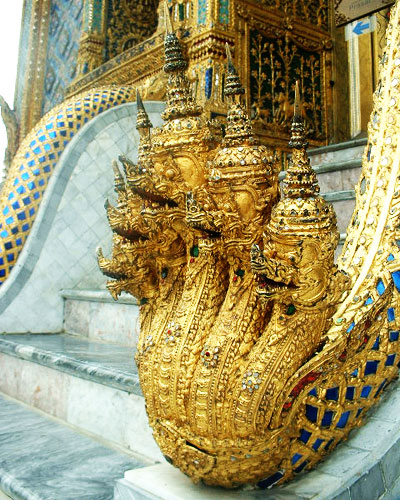
(A) Thiên long và các chúng khác trong bát bộ, đã có trong truyền
thuyết cổ Ấn Độ; tuy nhiên, thường được dùng trong Kinh điển Phật
giáo—Devas, nagas and others of the eight classes—The eight groups of
demon followers which existed in ancient Indian legends; however, they
were often utilized in Buddhist sutras to suggest the diversity of the
Buddha’s audiences.
(B) Bát bộ chúng hay tám loại chúng gồm chư thiên, hay phi nhân
được xem như là những thiên long hộ pháp, hay những vị cùng đến tham dự
những buổi pháp hội của Phật—Eight classes of divinities, or eight
kinds of gods and demi-gods. These are various classes of non-human
beings that are regarded as protectors of Buddhist Dharma and Buddhism
as part of the audience attending the Buddha’s sermons.
(C) Phân loại—Categories:
1) Thiên chúng: Deva (skr)—Chư Thiên trong các cõi trời (sáu cõi
trời Dục Giới, bốn trời Tứ Thiền Sắc Giới, Tứ Không Xứ)—Devas, gods, or
angels in the Heavens.
2) Long chúng: Nagas (skt)—Rồng—Dragons—Heavenly dragons.
3) Dạ Xoa chúng: Yaksas (skt)—Quỷ bay cực nhanh, giữ các cửa trời,
có liên hệ tới trời Đâu Suất, nhưng thường thấy nơi cõi người—Extremely
fast demons that guard Heaven’s Gates, sometimes associated with the
Tusita Heaven, but usually located on the human plane (realm).
4) Càn Thát Bà chúng: Gandharvas (skt)—Thần âm nhạc nơi cõi trời Đế
Thích—Musician Angels for the Cakra Heaven Kings.
5) A Tu La chúng: Asuras (skt)—Thần chiến đấu thường ở núi và đáy
biển quanh những triền bọc quanh núi Tu Di, bên dưới cõi trời Tứ Thiên
Vương—War gods, or evil spirits which live on the slopes of Mount Meru,
below the lowest heavenly sphere, that of the four Guardian Kings.
6) Ca Lâu La chúng: Garudas (skt)—Thần chim đại bàng cánh vàng, dài
đến 3.360.000 dặm—Heavenly (celestial) birds with golden wing spans of
approximately 3,360,000 miles.
7) Khẩn Na La chúng: Kinnaras (skt)—Nửa giống người nửa giống thần,
có tài trổi nhạc—Heavenly beings with human bodies and animal heads
(half-horse, half-men).
8) Ma Hầu La Già chúng: Mahoragas (skt)—Thần mãng xà (rắn lớn) có
thân dài trên 100 dậm—Serpent or Snake gods with body length over 100
miles.
Thiên Long Dạ Xoa,天龍夜叉, Devas, nagas,
yaksas
Thiên Lôi: God of thunder.
Thiên Lực Sĩ,天力士, See Thiên Đạo
Thiên Ma,天魔, Deva Mara (skt)
1) Một trong tứ ma trên cõi trời thứ sáu, thường che lấp hay cản
trở chơn lý Phật giáo—Celestial demons—Demons in heavens—One of the
four maras who dwells in the sixth heaven (Paranirmita-vasavartin), at
the top of the Kamadhatu, with his innumerable host, whence he
constantly obstructs the Buddha-truth and followers.
2) Danh từ nầy tiêu biểu cho những người lý tưởng luôn tìm cách
quấy phá Đạo Phật—This symbolizes idealistic people who disturb
Buddhism.
3) Sát Giả: Thường làm những chuyện phóng dật hại thân—The slayer.
4) Ba Tuần: Còn gọi là Ác Ái (là loại ma vương xuất hiện trong thời
Phật còn tại thế)—The mara who is sinful of love or desire, as he sends
his daughters to seduce the saints.
5) Ba Ty Dạ: Papiyan (skt)—Một loại ma vương đặc biệt hồi Phật còn
tại thế—The evil one. He is the special Mara of the Sakyamuni period.
Thiên Ma Ngoại Đạo,天魔外道, Thiên ma và
ngoại đạo đều là kẻ thù của chân lý—Maras and heretics are both enemies
of Buddha-truth
Thiên Mệnh: Ngoại đạo tin rằng có cái gọi là “Thiên
mệnh”—Externalists believe that there exists so called “Decree of God
and destiny (fate).”
Thiên Môn,偏門, Cửa hông, cửa mà tội
nhân bị tống khứ (nói về cửa hông của địa ngục)—A side door, one
through which offenders are expelled
Thiên Mục,篇目, Đề mục—A subject or
text exposed on a slip.
Thiên Ngục,天獄, The heavens and
hells—Devalokas and purgatories
Thiên Ngữ,天語, Tiếng Trời chỉ tiếng
Phạn, Bà La Môn tự cho tiếng Phạn là tiếng Trời—The deva language (the
language of Brahma or Sanskrit)
Thiên Nhạc,天樂,
1) Nhạc trời hay nhạc của chư Thiên—Heavenly (Celestial) music—The
music of the inhabitants of the heavens.
2) Một trong ba thứ hỷ lạc của chư Thiên: One of the three “joys”
of that of those in the heavens.
Thiên Nhãn,天眼, Divyacaksus (skt)
1) Mắt trời hay là mắt của thiên thú, thần thông thứ nhứt. Thiên
nhãn là mắt không bị giới hạn, thấy tất cả mọi thứ lớn nhỏ, xa gần,
thấy tất cả chúng sanh trong tam đồ lục đạo. Thiên nhãn có thể đạt được
bằng “tu đắc” qua thiền định hay “báo đắc” do tu phước mà được—Divine
eyes, the first abhijna. Divine sight is unlimited vision which all
things are open to it, large and small, near and distant, the destiny
of all beings in future rebirths. It may be obtained among men by their
human eyes through the practice of meditation, and as a reward or
natural possession by those born in the deva heavens.
2) Một trong năm loại Nhãn: One of the five classes of eyes.
Thiên Nhãn A Na Luật: Divine sight of Aniruddha.
Thiên Nhãn Lực,天眼力, Một trong mười lực
của Phật—The power of the celestial or deva eye, one of the ten powers
of a Buddha.
Thiên Nhãn Minh,天眼明, Thiên nhãn của một
vị Thánh, khiến vị nầy có thể thấy được những kiếp tái sanh của chính
mình và chúng sanh, đây là một trong tam minh—Clear vision of the
saint, or supernatural insight which enables him to know the future
rebirths of himself and all beings (future mortal conditions), one of
the three enlightenments
Thiên Nhãn Thiên,千眼天, Deva who has
thousand eye
Thiên Nhãn Thông,天眼通,
1) Có khả năng thấy được những diễn biến từ xa, cũng như thấy được
luân hồi sanh tử của chúng sanh—Celestial (Divine) Eye—Can see death
and rebirth—Power to see anywhere any time—The eye with which we can
see very distant things—Ability to see things and events at great
distance—Ability to see the births and deaths of sentient beings
everywhere.
2) Mắt của những người thực tập thôi miên: The vision of those who
practice hypnotism.
Thiên Nhãn Trí,天眼智, The wisdom
obtained by the deva eye
Thiên
Nhãn Trí Chứng Thông,天
眼智證通, Theo Câu Xá Luận, lục thông đều lấy trí làm thể,
làm lực dụng chứng tri sự phân biệt và thông đạt vô ngại. Thiên nhãn
trí chứng thông là dựa vào trí tuệ được khởi lên bởi thiên
nhãn—According to the Kosa sastra, the wisdom or knowledge that can see
things as they really are is the complete universal knowledge and
assurance of the deva eye
Thiên
Nhãn Trí Thông Nguyện,天
眼智通願, Lời nguyện thứ sáu trong 48 lời nguyện của Phật A
Di Đà, ngài sẽ chẳng thành Phật cho đến khi nào pháp giới chúng sanh
đều đạt được thiên nhãn—The sixth of Amitabha’s forty-eight vows, that
he would not enter the final stage until all beings had obtained this
divine vision.
Thiên Nhân,天人, Devas and
men—Superior persons
Thiên Nhân Đạo Sư,天人道師, See Thiên Nhân
Sư
Thiên Nhân Sư,天人師, Sasta
Deva-manusyanam (skt)—Xá Đa Đề Bà Ma Thố Xá Nam—Xá Đa Đề Bà Ma Mâu Nam
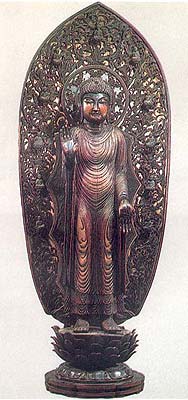
1) Vị giáo sư bậc thầy của trời và người: An Unequaled teacher of
Humans and Heavenly beings. He reveals goodness and morality, and he is
able to save.
2) Một trong các danh hiệu của Phật: One of the ten titles
(epithets) of a Buddha.
Thiên
Nhân Tán Hoa Thân Thượng,天人散花身上, The story of a man who saw a
disembodied ghost beating a corpse which he said was his body that had
led him into all sins, and further on an angel stroking and scattering
flowers on a corpse, which he said was the body he had just left,
always his friend
Thiên Nhĩ Thông,天耳通, Divyasrotra
(skt)—Một trong lục thông, nghe và hiểu mọi ngôn ngữ—The Divine
(Celestial—Deva) Ear—Supernatural or transcendental hearing—Power to
hear and understand all languages—One of the six miraculous
powers—Ability to hear the sounds of human and nonhumans, distant and
near sounds
Thiên Nhĩ
Trí Chứng Thông,天耳智證
通, See Thiên Nhĩ Trí Thông
Thiên Nhĩ Trí
Thông,天耳智通,
Thần thông thứ nhì trong lục thông, có khả năng nghe và hiểu tiếng nói
trong sắc giới—The second of the six abhijnas (lục thông) by which
devas in the form-world, certain arhats through the fourth dhyana, and
others can hear all sounds and understand all languages in the realms
of form, with resulting wisdom.
Thiên Nhĩ
Trí Thông Nguyện,天耳智
通願, Lời nguyện thứ bảy trong bốn mươi tám lời nguyện của
Đức Phật A Di Đà, nguyện chẳng thành Phật cho đến khi nào tất cả chúng
sanh đều có được Thiên Nhĩ Thông—The seventh of the forty-eight vows of
Amitabha, not to become Buddha until all obtain the divine ear
Thiên Nhiên: Natural.
Thiên Nhiên Chân Như-Phi Nhân Tạo Tác: Thiên nhiên chi chân như,
phi nhân tạo tác giả—Nature—Natural reality, not of human creation.
Thiên Nữ,天女, Devakanya or Apsaras
(skt)—Goddess—Female deity—Attendants on the regents of the sun and the
moon—Wives of Gandharvas
Thiên Phú: Inborn—Innate—Connate.
Thiên Quan,天冠, A deva crown,
surpassing human thought
Thiên Quỷ,天鬼,
1) Chư Thiên và ma quỷ: Devas and demons.
2) Tái sanh vào cõi chư Thiên và quỷ: Reincarnation among devas and
demons.
Thiên Sam,偏衫, Loại áo của chư Tăng
mặc phủ qua một vai, có người nói phủ vai phải, lại có người nói phải
phủ vai trái (tất cả chỉ là hình tướng bên ngoài, nội tâm mới là phần
quan trọng)—The monk’s toga, or robe, thrown over one shoulder, some
say the right, others the left.
Thiên Sư,天師,
1) Thầy dạy của vua: Preceptor of the emperor.
2) Danh hiệu của Sư Nhất Hành: A title of the monk I-Hsing.
3) Danh hiệu của giáo chủ Lão Giáo: A title of Taoist Pope.
Thiên Sứ,天使,
Deva-messegers—Divine (heaven) messengers, especially those of Yama—See
Tam Thiên Sứ and Ngũ Đại Sứ Giả
Thiên Thai,天台, The T’ien T’ai or
Heavenly terrace mountain
Thiên Thai Bát
Giáo,天台八教,
See Thiên Thai Ngũ Thời Bát Giáo
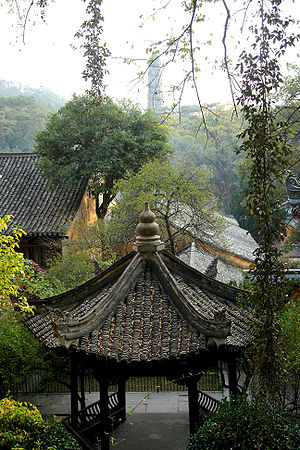
Thiên Thai Cửu Tổ: Chín vị Tổ liên tiếp của Tông Thiên Thai—The
sucession of the nine founders of the T’ien-T’ai Sect—The nine
patriarchs of the T’ien-T’ai Sect:
1) Long Thọ: Long Thọ được xem là Cao Tổ của tông Thiên
Thai—Nagarjuna was considered as the founder of the T’ien-T’ai
School—See Nagarjuna in Sanskrit/Pali-Vietnamese Section.
Video Nagarjuna:
Founder of Mahayana Buddhism
2) Huệ Văn (505-577): Nhị Tổ—Hui-Wen—See Huệ Văn.
3) Huệ Tư: Tam Tổ Huệ Tư—Hui-Su—See Huệ Tư.
4) Trí Giả: Tứ Tổ Trí Khải—Chih-Chê (Chih-I)—See Trí Khải.
5) Quán Đảnh: Ngũ Tổ Quán Đảnh—Kuan-Ting—See Quán Đảnh (3).
6) Pháp Hoa: Lục Tổ Pháp Hoa—Fa-Hua.
7) Thiên Cung: Thất Tổ Thiên Cung—T’ien-Kung.
8) Tả Khê: Bát Tổ Tả Khê—Tso-Ch’i.
9) Trạm Nhiên: Cửu Tổ Trạm Nhiên—Chan-Jan—See Trạm Nhiên.
Thiên Thai Đại Sư,天台大師, T’ien-T’ai Great
Master—Chih-I (Thạch Khải)—Vị sư đã sáng lập ra tông phái Thiên Thai,
ngài tên Đức An, họ Trần (538-597 sau Tây Lịch). Ngài theo học tu và
chịu ảnh hưởng rất lớn với Sư Huệ Tư ở Hồ Nam. Ngài thấy được trong
Kinh Pháp Hoa một lối diễn giảng đúng nghĩa của Đại Thừa Giáo. Vào năm
575 sau Tây Lịch, lần đầu tiên ngài đến núi Thiên Thai và sáng lập tông
phái nầy tại đó. Giáo thuyết của tông phái nầy trở thành căn bản cho
các trường phái Phật giáo tại Đại Hàn và Nhật Bản sau nầy—The monk who
founded T’ien-T’ai Sect—The actual founder of the T’ien-T’ai school,
Chih-I, his name was Tê-An, and his surname Ch’ên (538-597 AD). He
studied under Hui-Ssu of Hunan, he was greatly influenced by his
teaching; and found in the Lotus Sutra the real interpretation of
Mahayanism. In 575 AD, he first came to T’ien-T’ai and established his
school, which in turn was the foundation of important Buddhist schools
in Korea and Japan—See Thiên Thai Sơn
Thiên Thai Đức Thiều Thiền Sư: Zen master T’ien-Te-Shao—See Đức
Thiều Thiền Sư.
Thiên Thai Hóa Nghi Tứ Giáo: Bốn giáo pháp được định nghĩa bởi tông
Thiên Thai—The four modes of teaching, defined by the T’ien-T’ai:
1) Đốn Giáo: Direct Teaching.
2) Tiệm Giáo: Gradual Teaching.
3) Mật Giáo: Esoteric Teaching.
4) Bất Định Giáo: Indefinite Teaching.
Thiên Thai Hóa Pháp Tứ Giáo: The four periods of teaching.
1) Tạng Giáo: Tạng Giáo Tiểu Thừa—The Tripitaka Teaching, or the
Pitaka School was that of Hinayana.
2) Thông Giáo: Thông Giáo là giai đoạn phát triển đầu tiên của Phật
Giáo Đại Thừa với đầy đủ Tam Thừa (Thanh Văn, Duyên Giác, và Bồ Tát).
Giáo thuyết triển khai của Thông giáo nối liền Thông Giáo với Biệt Giáo
và Viên Giáo—Interrelated Teaching, or intermediate school, was the
first stage of Mahayana, having in it elements of all the three
vehicles (sravaka, pratyekabuddha, and bodhisattva). Its developing
doctrine linked it with Hinayana on the one hand and on the other hand
with the two further developments of the “separate” or “differentiated”
Mahayana teaching, and perfect teaching.
3) Biệt Giáo: Differentiated Teaching.
4) Viên Giáo: Tên khác của Bí Mật giáo—Complete, Perfect, or Final
Teaching; a name for the esoteric sect.
Thiên Thai Luật,天台律, Luật của tông
Thiên Thai hay còn gọi là Đại Thừa Viên Đốn Giới—The laws (which are
ascribed as the Mahayana perfect and immediate moral precepts) of the
T’ien-T’ai sect as given in
1) Luật đã được Phật nói tới trong Kinh Pháp Hoa: The commandments
which the Buddha mentioned in the Lotus Sutra.
2) Mười Giới trọng: The ten primary commandments in the Brahma’s
Net Sutra—See Mười Giới Trọng Của Chư Bồ Tát Trong Kinh Phạm Võng.
3) Bốn Mươi Tám Giới Khinh (Kinh Phạm Võng): Forty-eight secondary
commandments of the Brahma’s net Sutra (Brahmajala)—See Bốn Mươi Tám
Giới Khinh.
Thiên Thai Ngũ Thời Bát Giáo: Five Periods and Eight Teachings
of
the T’ien T’ai school—
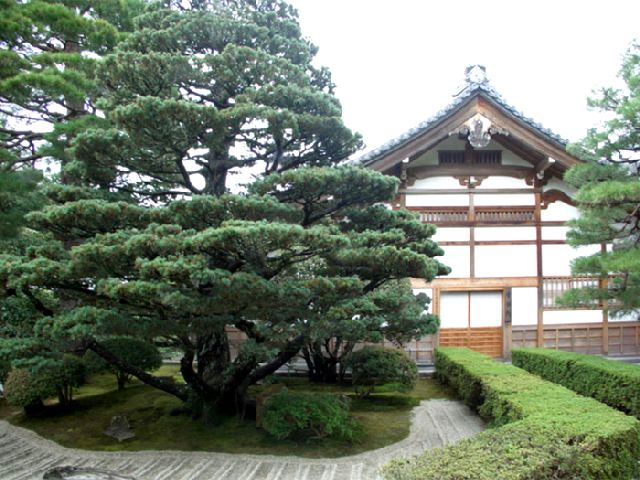
Đây là cách xếp loại những lời Phật dạy theo
quan điểm của phái Thiên Thai, do Trí Giả Đại Sư người Trung Quốc thiết
lập. Phái Thiên Thai, học thuyết dựa vào Kinh Diệu Pháp Liên Hoa và
thừa nhận Ngài Long Thọ Bồ tát làm trưởng lão đầu tiên của mình. Trường
phái nầy lợi dụng tất cả mọi phương tiện nhằm đạt tới đại giác. Qua
việc phân loại tiến trình giảng kinh và học thuyết Phật thành năm thời
kỳ và Tám Giáo Lý (bốn loại giáo lý cộng thêm bốn phương pháp giảng
giải) chứng tỏ trường phái nầy hệ thống hóa sự thuyết giảng của Phật—A
classification of the Buddha’s teachings from the standpoint of the
T’ien-T’ai sect, made by its Chinese founder Chih-I. The school of
Celestial Platform of which doctrine is based on the Lotus Sutra and
sees Nagarjuna as its first patriarch. This sect takes advantage of all
expedients to practice to attain enlightenment. The classification of
sutras and the teachings of Buddha into five periods (or five stages)
and eight teachings (four doctrines plus four methods of expounding
them) represents and attempt to systematize the teachings of Buddha:
A) Năm Thời Kỳ, trong đó thời Hoa Nghiêm kéo dài 21 ngày, thời A
Hàm kéo dài 12 năm, thời Phương Quảng kéo dài 8 năm, thời Bát Nhã kéo
dài 22 năm, và thời Niết Bàn kéo dài 8 năm—Five Periods in which the
Avatamsaka period lasted for twenty-one days, the Agama period for
twelve years, the Vaipulya period for eight years, the Prajna period
for twenty-two years, and the Nirvana period for eight years:
B) Bát giáo—Eight methods: Tám giáo còn gọi là Bát Giáo, tức là tám
khoa hay tám phương thức giáo hóa của Phật dạy cho chúng sanh tu hành.
Bát Giáo chia ra làm bốn về phương pháp và bốn về nội dung—Eight
Doctrines are eight methods or means used by the Buddha to teach
sentient beings to cultivate. Eight teachings, four of which are
methods, and the rest four are contents:
a) Bốn phương pháp—Four methods:
1) Đốn giáo—Instantaneous Doctrine: Ở đây Đức Phật tuyên thuyết về
sở chứng của Ngài mà không cần đến phương tiện nào cả, đây là thời Hoa
Nghiêm. Phương pháp đốn giáo nầy được những người thượng căn thượng trí
áp dụng, vì những người nầy có khả năng hiểu được chân lý bằng trực
giác. Đốn giáo là giáo pháp đốn ngộ hay ngộ cấp kỳ tức là pháp môn trực
chỉ dành cho những hành giả thượng căn trong nhà Thiền—The Sudden
(Abrupt) Doctrine, in which the Buddha preached what he had conceived
without using any expediency, this is the time of the Wreath. This
sudden method or the method of the Buddhavatamsaka-Sutra, which is to
be used with the most talented students who understand the truth
directly. Instantaneous or Sudden Doctrine is Dharma teachings which
will lead to a fast awakening and enlightenment such as Zen Buddhism,
reserved for those at the highest level of cultivators.
2) Tiệm giáo—Gradual or Deliberate Doctrine: Đức Phật dùng “Tiệm
Giáo” dẫn dụ mọi người đi lần vào sự tư duy sâu thẳm, dùng tất cả mọi
phương tiện, đây là thời Lộc Uyển, Phương Đẳng và Bát Nhã. Phương pháp
“Tiệm Giáo” nầy được đại đa số áp dụng vì nó đi từ thấp đến cao, từ căn
bản đến phức tạp như Pháp Môn Tịnh Độ. Phương pháp nầy bao hàm các thời
kỳ A Hàm, Phương Quảng và Bát Nhã—The Buddha utilized the “Gradual
Doctrine” to induce people gradually into deeper thinking, using all
sorts of measures, this is the time of the Deer Park, of Development
and of Wisdom. The Gradual Doctrine teaches cultivators to gain
enlightenment gradually from lower to higher levels such as the
Pureland Dharma Door. This gradual method or the method of Agama,
Vaipulya and Parinirvana-sutras. This method is utilized by the
majority of people because it progresses from the elementary to more
complex teachings.
3) Mật giáo—Esoteric Doctrine: Trên thực tế, đây là giáo lý bí mật
bất định, nó không nhất định và biến thiên vì thính giả khuất lấp nhau
bởi sức thần thông của Phật và mỗi người nghĩ rằng Phật chỉ giảng cho
riêng mình mà thôi. Phương pháp bí truyền chỉ được Phật dùng khi nói
riêng với một người và chỉ có người đó hiểu được. Khác với Thông giáo,
Mật giáo dạy về nghĩa thâm mật của Phật giáo. Phương pháp dạy hành giả
về cách bắt ấn, trì chú, tam mật tương ưng, tức thân thành Phật. Thân
khẩu ý của hành giả tương ưng với thân khẩu ý của Phật—The Secret
Teaching. In fact, it is a mystical indeterminate doctrine. It is
indeterminate and varied because many a listener is concealed from
another by the Buddha’s supernatural power and each thinks that the
Buddha is teaching him alone. Thus all hear separately and variously.
Such indeterminacy exists from the time of the Wreath to the time of
Wisdom. The secret method, which was used by the Buddha only when
addressing to one person, in which case the Buddha was understood by
this only person. Opposite to the Common Doctrine, this Dharma is
passed on at a hidden level and has the characteristics of the deepest
and most profound meanings of Buddhism. This doctrine teaches
cultivators to recite mantras, make Buddha seals with hands, etc. If
the three karmas of the cultivators become one with the Buddha, then
the cultivators will attain Buddhahood. Meaning if the cultivators’
Mind, Spech and Body is similar to that of the Buddha, then Buddhahood
is attained.
4) Bất Định giáo—Indefinite or Indeterminate Doctrine: Giáo lý bất
định, không bí mật mà Phật dùng khi có mặt nhiều đệ tử khác trình độ
nhau, nhưng đều hiểu lời Phật giảng. Giáo pháp mà Phật tùy theo căn cơ
nghi thuyết dạy, chớ không nhứt định là phải thuộc riêng về một căn cơ
nào cả—The Indeterminate Doctrine, non-mystical indeterminate doctrine,
in which though the students have different levels, they still
understood his words in different ways (all listeners know that all are
hearing together and yet they hear differently and understand
vaiously). The Buddha used Indefinte Doctrine to teach sentient beings
with different levels of understanding.
b) Bốn nội dung—Four contents:
5) Tiểu Thừa hay Tạng Giáo—Pitaka Doctrine: Tạng giáo là các pháp
môn tu học có dạy chung trong Tam Tạng kinh luật và luận. A Hàm và tất
cả giáo lý Tiểu Thừa, như được thấy trong văn học Tỳ Bà Sa, thích hợp
với Thanh văn và Duyên giác—The Doctrine of Tripitaka teaching
(Scriptures) or Pitaka (Storage) Doctrine includes various Dharma Doors
of cultivation taught to all in the Tripitaka or 'Three Storages.’
(Sutra, Precept Pitaka, and Upadesa Pitaka or commentary of Sutra).
Agamas or traditions of discourses and all Hinayana doctrines, such as
those found in the Vaibhasika literature, appropriate for Sravakas and
Pratyeka-buddhas.
6) Thông Giáo—Common Doctrine: Chung cho tất cả ba thừa và là giáo
lý sơ cơ của Đại Thừa. Trong khi một vị sơ tâm Bồ Tát theo những tu tập
như các vị trong tam thừa, thì một đại Bồ Tát thâm nhập cảnh giới của
Biệt Giáo và Viên Giáo. Đây là giáo thuyết tổng quát, dành cho cả Tiểu
lẫn Đại thừa, nhằm chỉ dạy cho Thanh văn, Duyên giác và Bồ tát trong
giai đoạn phát triển đầu tiên. Giáo pháp nầy dạy chung cho tất cả ba
căn cơ thượng trung hạ và cả ba thừa Tiểu Trung Đại: The Doctrine
Common to All or the connecting teaching. It is common to the three
Vehicles and is elementary doctrine of Mahayana. While an inferior
Bodhisattva follows the same practices as the people of the three
Vehicles, a superior Bodhisattva will penetrate into “Distinct
Doctrine” and “Doctrine of Perfection.” This general teaching, which is
for both Hinayana and Mahayana. And is meant for Sravakas,
Pratyeka-buddhas and Bodhisattvas in their first level of progress. The
Common Doctrine or Apparent Doctrine refers to the teachings used
collectively to reach all three levels of sentient beings High,
Intermediate, and Low.
7) Biệt Giáo—Specific Doctrine: Đây là học thuyết thuần nhất Đại
Thừa và chỉ dành riêng cho Bồ Tát. Tạng giáo và Thông giáo chỉ giảng về
cái “không” phiến diện hay “thiên không,” Biệt giáo giảng về Trung Đạo,
và do đó nó riêng biệt. Có người nói Biệt Giáo là pháp dạy riêng cho
mỗi căn cơ hoặc Thượng, hoặc Trung, hoặc Hạ, cùng ba thừa, hoặc riêng
cho Tiểu Thừa Thanh Văn, hoặc riêng cho Trung Thừa Duyên Giác, hoặc
riêng cho Đại Thừa Bồ Tát—The Distinct Doctrine or special teaching for
Mahayana Bodhisattvas. The Doctrine of Pitakas and the Doctrine Common
to all teach the simple one-sided “Void” while this doctrine teaches
the Middle Path, and, therefore, is distinct and separate. Someone says
that Specific Doctrine include teachings geared specifically to each
level of High, Intermediate, or Low of the three vehicles which include
Sravakas or Lesser Vehicle, or Pratyeka-Buddhas or Intermediate
Vehicle, or Mahayana Bodhisattvas or Greater Vehicle.
8) Viên giáo—Perfect Doctrine: Học thuyết hoàn hảo hay tròn đầy,
thuyết giảng con đường giữa. Viên có nghĩa là toàn thiện, biến mãn,
viên mãn, viên thông. Biệt giáo giảng về một “trung đạo” độc lập và
cách biệt, và chỉ một phương tiện riêng biệt, còn Viên giáo là giáo
pháp tròn đầy, giảng vể Trung Đạo của viên thông và quán triệt. Do đó,
nó không phải là một trung đạo cách biệt, phiến diện, mà là một trung
đạo thực thể, hoàn toàn hòa hợp , trên lý thuyết cũng như thực tế. Như
thế “Viên” có nghĩa là một pháp chứa đựng tất cả các pháp, nghĩa là
“Nhất tức nhất thiết và nhất thiết tức nhất.” Viên giáo còn gọi là “Đại
Thừa Giáo Pháp Tối Thượng Thừa” như giáo pháp trong Kinh Hoa Nghiêm chỉ
chuyên dạy cho các hàng Bố Tát Đại Sĩ Pháp Thân, từ Thập Trụ đến Thập
Địa Bồ Tát—The complete, round teaching, or perfect teaching that of
the Middle-Way. “Round” means perfection, all pervading, all
fulfilling, all permeating. The Distinct Doctrine teaches an
independent and separate Middle Path and is simple-separate mean, while
the Round Doctrine, the most complete and penetrating which teaches the
Middle Path of perfect permeation and mutual identification. Therefore,
it is not a separate, one-sided Middle Path, but the Middle Path as
noumenon, perfectly harmonious, theoretically and practically. Thus
“round” means that one element contains all elements, i.e., the
principle of “One is all and all is one.” The Perfect Doctrine is also
called the ultimate teaching of Mahayana Buddhism. It is the most
complete and penetrating teaching used to teach the Maha-Bodhisattvas,
or Enlightened Beings striving to attain the Ultimate Enlightenment of
Buddhahood, such as the teachings in the Avatamsaka Sutra, which were
taught specifically for the Great Strength Dharma Body
Maha-Bodhisattvas from Ten-Entrances to Ten-Grounds Maha-Bodhisattvas.
Thiên Thai Nhị Ứng Thân: Tông Thiên Thai lập ra hai loại
thân—T’ien-T’ai sect has the distinction of two kinds of nirmanakaya.
1) Thắng Ứng Thân: Superior or supernatural Nirmanakaya.
2) Liệt Ứng Thân: Inferior or natural Nirmanakaya.
Thiên Thai Sơn,天台山, Núi Thiên Thai,
nơi xuất phát của tông phái Thiên Thai. Tên Thiên Thai dùng để chỉ chân
núi Tiên Hà Lĩnh, Thai Châu, miền Nam Trung Hoa, nơi có “Tam Đài Lục
Tinh,” nơi mà Chih-I (Trí Khải) hay Đại Sư Thiên Thai đã xây dựng những
tự viện và sáng lập ra tông phái nầy—The T’ien-T’ai or Heavenly Terrace
mountain, T’ai-Chou, South China, the location of the T’ien-T’ai sect;
its name is attributed to the “Three Stairs Six Stars” at the foot of
Ursa Major, under which it is supposed to be, but more likely because
of its height and appearance. It gives its name to a hsien in the
Chekiang T’aichow prefecture, southwest of Ningpo. The monastery, or
group of monasteries was founded there by Chih-I, who is known as the
T’ien-T’ai Great Master.
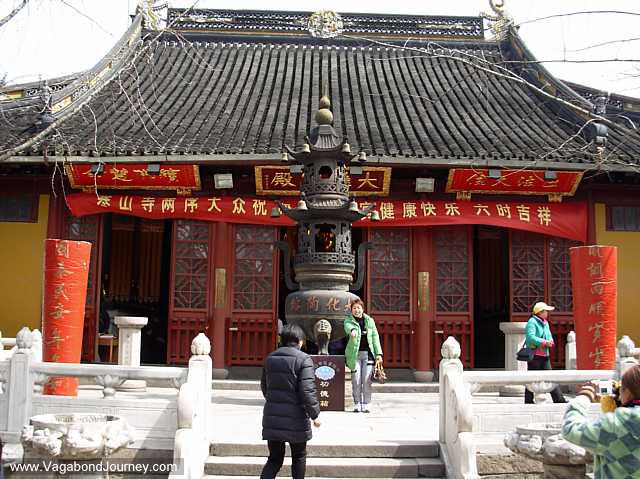
Thiên Thai Tam
Giáo,天台三教,
Ba giáo của Thiên Thai tông. Theo tông Thiên Thai thì giáo thuyết của
Phật Thích Ca được chia làm ba loại—Three modes of Sakyamuni’s
teaching, according to the T’ien T’ai
(A) Đại Cương Tam Giáo:
1) Đốn giáo: Tức thì khai ngộ—The sudden or immediate teaching, by
which the learner is taught the whole truth at once.
2) Tiệm giáo: Từ từ khai ngộ—The gradual teaching.
3) Bất định giáo: The undetermined or variable method whereby he is
taught what he is capable of receiving.
(B) Quyền Môn Tam Giáo:
1) Tiệm Giáo: Gradual Teaching.
2) Đốn Giáo Immediate Teaching.
3) Viên Giáo: Perfect teaching—The last being found in the final or
complete doctrine of the Lotus Sutra.
(C)
1) Tam Tạng Giáo: The Tripitaka doctrine or orthodox Hinayana.
2) Thông Giáo: Intermediate, or interrelated doctrine, such as
Hinayana-cum-Mahayana.
3) Biệt Giáo: Differentiated or separated doctrine, such as the
early Mahayana as a cult or development, as distinct from Hinayana.
Thiên Thai Tam Thời Giáo: Theo tông Thiên Thai, giáo thuyết
của Đức
Phật có thể chia làm ba thời kỳ, thí, khai, và phế—According to the
T’ien-T’ai sect, Buddha’s teaching can be divided into three periods of
bestowing, opening, and abrogating—See Thí Khai Phế.
Thiên Thai Thập Định: The T’ien-T’ai’s ten fields of meditation or
concentration—See Chỉ Quán Thập Định.
Thiên Thai Thập Tổ: Mười vị Tổ của tông phái Thiên Thai—The
ten
patriarchs of the T’ien-T’ai sect:
1) Từ tổ thứ nhất đến tổ thứ 9 đã nói trong Thiên Thai Cửu Tổ—From
1 to 9 already mentioned in the nine patriarchs of the T’ien-T’ai
sect—See Thiên-Thai Cửu Tổ.
10) Tổ thứ mười của tông phái Thiên Thai là ngài Đạo Thúy. Ngài
được xem là tổ thứ mười tại Nhật Bổn, vì ngài là người đã mang giáo
pháp Thiên Thai truyền qua Nhật vào thế kỷ thứ chín và là thầy của
Tuyền Giáo Đại Sư (sơ tổ tông Thiên Thai tại Nhật)—The ten patriarch
was Tao-Sui. He was considered a patriarch in Japan, because he was the
teacher of Dengyo Daishi who brought the Tendai system to that country
in the ninth century.
Thiên Thai
Thiều Quốc Sư,天台韶國師,
Thiên Thai Thiều Quốc Sư là một Tăng sĩ đã phục hưng tông phái Thiên
Thai bằng cách du hành sang Cao Ly để ghi chép lại Thiên Thai Tam Bộ
còn giữ được nguyên bản của Ngài Trí Giả, rồi trở về xây dựng chùa
chiền và chấn hưng tông phái. Ngài được Tiền Chu (960-997 sau Tây
Lịch), lúc bấy giờ là vua của nước Ngô Việt mà kinh đô ở Hàng Châu
phong cho ngài làm Quốc Sư—T’ien-T’ai Shao Kuo Shih, a Chekiang priest
who revived the T’ien-T’ai sect by journeying to Korea, where the only
copy of Chih-I’s works existed, copied them, and returned to revive the
T’ien-T’ai school. Ch’en-Shu (960-997 AD), ruler of Wu-Yueh, whose
capital was at Hangchow, entitled him Imperial Teacher.
Thiên Thai Tông,天台宗, T’ien-T’ai School
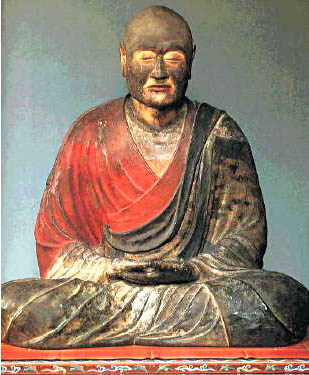
(I) Thiên Thai tông Trung Quốc—Chinese T’ien-T’ai:
(A) Lịch sử tông Thiên Thai—The history of the T’ien-T’ai School:
Tông Thiên Thai là tông phái Phật giáo duy nhất còn tồn tại ngày nay
tại Trung Quốc. Thiên Thai là tên của một hòn núi ở Thai Châu, miền nam
Trung Hoa. Tông Thiên Thai được Đại Sư Trí Giả đời Tùy sáng lập, lấy
tên núi đặt tên cho tông phái. Trí Giả Đại Sư đã trú ngụ tại núi Thiên
Thai và giảng dạy đồ chúng suốt thời nhà Trần và Tùy. Tông phái do ông
thành lập thường được gọi là Thiên Thai theo tên núi, nhưng đúng tên
của nó là Pháp Hoa vì tông nầy lấy Kinh Pháp Hoa làm bản kinh. Tông
phái chủ trương khai mở chân lý vạn pháp bằng thiền quán. Tông cực
thịnh vào đời nhà Đường. Dưới thời nhà Tống khi tông phái nầy suy vi,
thì Sư Tứ Minh khởi lên trung hưng tông nầy và hiển dương chính tông
của Sơn Gia, trong khi Sơn Ngoại thì có Sư Ngộ Ân, nhưng về sau nầy
phái Sơn Ngoại bị mai một, còn phái Sơn Gia với giáo thuyết thâm sâu và
sự trung hưng của Sư Tứ Minh, nên đã lan truyền qua đến Nhật
Bản—T’ien-T’ai is the only living Buddhist school in China today.
T’ien-T’ai is the name of a mountain in T’ai-Chou, South China. This
school was founded by Great Master Chih-Chê (or Chih-I). The T’ien-T’ai
or Tendai Sect was named after the name of the mountain. Chih-I lived
on the mountain and taught his disciples during the Ch’ên and Sui
Dynasties. The school founded by him was generally called the
T’ien-T’ai (after the name of the mountain), but was properly named the
Fa-Hua after the title of the text Saddharma-pundarika from which the
doctrine of the school is derived. It maintains the identity of the
Absolute and the world of phenomena, and attempts to unlock the secrets
of all phenomena by means of meditation. It flourished during the T’ang
dynasty. Under the Sung, when the school was decadent, arose Ssu-Ming,
under whom there came the division of Hill or T’ien-T’ai School and the
School outside, the later following Wu-ên and in time dying out; the
former, a more profound school, adhered to Ssu-Ming; it was from this
school that the T’ien-T’ai doctrine spread to Japan. Thiên Thai Tam Bộ
(gồm Kinh Pháp Hoa với Luận Trí Độ, Kinh Niết bàn và Đại Phẩm Kinh).

(B) Triết lý và kinh luận—Philosophy and chief works:
a) Triết lý—Philosophy: Tuy là những bộ phái Phật giáo đều có nguồn
gốc từ Ấn Độ, nhưng sự miệt mài nghiên cứu kinh điển Phật giáo của các
học giả Trung Hoa đã làm xuất hiện những dạng thức tu hành hoàn toàn
mới mẽ, dường như phát sanh ra từ bối cảnh Trung Hoa hơn là Ấn Độ. Ngài
Trí Khải lập ra một hệ ‘Tam Quán’ có tên là Chí Quán hay sự quán triệt
hoàn toàn. Hệ tam quán nầy gồm ‘Không-Giả-Trung’ (see Không Giả Trung):
Although these Buddhist schools in China had their origin in Indian
Buddhism, but the ceaseless study of the Buddhist texts by the Chinese
schools resulted in completely new religious experiences which seem to
have grown out of the historical background of China rather than of
India. Chi-K’ai established a threefold system of comprehension which
is called Chi-Kuan, or ‘Perfect Comprehension.’ This system consists of
three comprehensions, namely, empty, hypothetical, and medial (see
Không Giả Trung).
b) Kinh luận—Main texts: các kinh sách chính của tông phái nầy gồm
có kinh Diệu Pháp Liên Hoa, Đại Trí Độ Luận, kinh Niết Bàn, kinh Đại
Bát Nhã Ba La Mật Đa: The main texts of the T’ien-T’ai sect include the
The Wonderful Dharma of the Lotus Sutra (Saddharma-Pundarika-Sutra),the
Mahaprajna-paramita-sastra, the Mahanirvana sutra, and the
Mahaprajnaparamita sutra.
c) Tác phẩm—Chief works: Ngài Trí Giả đã thuyết giảng Tam Bộ: Huyền
Nghĩa (nói về giáo tướng), Văn Cú (nói về kinh văn), và Chỉ Quán (chỉ
rõ nhất tâm quán hành): The three principal works of the T’ien-T’ai
founder are called The Tri-Sutras of the T’ien-T’ai (Thiên Thai Tam
Bộ), such as the exposition of the deeper meaning of the Lotus Sutra
(Pháp Hoa Huyền Nghĩa), Exposition of its text (Văn Cú), and meditation
which stressed on the “inner light” (Chỉ Quán).
(II) Thiên Thai tông Nhật Bản—Japanese T’ien-T’ai:

(A) Lịch sử tông Thiên Thai Nhật Bản—The history of the Japanese
T’ien-T’ai: Tông Thiên Thai Nhật Bản được Đại sư Tối Trừng (Saicho)
sáng lập tại Nhật vào năm 804. Ông thường được biết nhiều qua tên
Dengyo-Daishi. Ông gia nhập Tăng đoàn khi còn trẻ và đi đến Trung Hoa
để nghiên cứu thêm về đạo Phật. Tại đây ông được các luận sư của trường
phái Thiên Thai nổi tiếng truyền dạy Chánh Pháp. Theo Giáo Sư Junjiro
Takakusu trong Cương Yếu Triết Học Phật Giáo, thì Tối Trừng được Đạo
Toại truyền cho học thuyết Thiên Thai và Bồ Tát giới, được Thuận Giáo
truyền cho học thuyết Chân Ngôn tông, và Tu Nhiên truyền cho Thiền
tông. Sau một năm lưu trú ở Trung Hoa, ông trở về Nhật Bản để truyền bá
giáo lý mới nầy tại chùa Enryakuji trên núi Tỷ Duệ (Hiei). Ngôi chùa
nầy chẳng bao lâu đã phát triển thành một trung tâm quan trọng cho tất
cả mọi công cuộc nghiên cứu và tu tập Phật giáo tại Nhật—The T’ien-T’ai
(Tendai) sect was founded in Japan in 804 A.D. by Saicho, who was
better known as Dengyo-Daishi. He entered the Order young and went for
further study to China, where he received instruction in the Dharma
from teachers at the famous T’ien-T’ai school. According to Prof.
Junjiro Takakusu in The Essentials of Buddhist Philosophy, he received
the T’ien-T’ai doctrine and the Bodhisattva ordination from Tao-Sui,
the mystic doctrines (mantra) from Shun-Chiao, and the Zen meditation
from Hsiu-Jan. On his return to Japan, he propagated the new doctrine
in the temple called Enryakuji on Mount Hiei. This temple soon grew to
be an important center of all Buddhist studies and practices in Japan.
(B) Triết lý tông Thiên Thai—The philosophy of the Japanese
T’ien-T’ai school: Dù rằng tông Thiên Thai Nhật Bản và Trung Quốc đều
căn cứ chủ yếu vào kinh sách của Đại Thừa là Kinh Diệu Pháp Liên Hoa,
và Ngũ thời Bát giáo, tông phái nầy khác với Thiên Thai Trung Hoa ở
đường lối thực hành. Đại sư Tối Trừng đã đề ra phương pháp hành trì gọi
là ‘Trực giác của tâm.’—Even though both Chinese and Japanese
T’ien-T’ai sects base themselves essentially on the Mahayana texts,
i.e., the Saddharma-pundarika, and the T’ien-T’ai’s Five Periods and
Eight Doctrines, the Japanese T’ien-T’ai differs from the Chinese
T’ien-T’ai in its practical approach. Dengyo Daishi also introduced a
practical method called ‘intuition of the mind’ (kwanjin)—See Thiên
Thai Ngũ Thời Bát Giáo
(C) Sự phát triển của tông Thiên Thai tại Nhật Bản—The development
of the Tendai sect in Japan: Trung tâm giảng huấn trên núi Tỷ Duệ do
đại sư Tối Trừng thành lập đã trở thành trung tâm lớn của nhành Phật
học tại Nhật. Một thời đã có 3.000 tự viện làm túc xá cho học chúng,
qui tụ tất cả mọi ngành Phật học hiển và mật. Hiện tại có ba chi phái
của tông Thiên Thai, đó là Sơn Môn (Sammon), Tự Môn (Jinon), và Chân
Thạnh (Shinsei). Chi phái sau nầy là Tịnh Độ. Những tự viện thuộc ba
chi phái nầy hiện thời tính khoảng trên 4.000—The educational
headquarters on Mount Hiei was established by Saicho and became the
greatest center of Buddhist learning in Japan. Once there were some
3,000 monasteries to house the students thronging there from all
branches of Buddhism, exoteric and esoteric. At present there are three
branches of the Tendai in Japan; namely, Samon, Jimon, and Shinsei, the
last being an Amita-pietism. The monasteries belonging to the three
branches number more than 4,000 at the present time.
*** For more information, please see Thiên Thai Sơn and Thiên Thai
Ngũ Thời Bát Giáo.
Thiên Thai Tứ Giáo,天台四教, The four types
each of method and doctrine, as defined by T’ien-T’ai school—See Thiên
Thai Hóa Nghi Tứ Giáo.
Thiên Thân,天親, Thế Thân, Bà Tẩu Bàn
Đậu
(Vasubandhu),
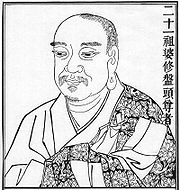
Video Vasubandhu:
The Brilliant Yogacara Thinker
Ngài Thiên Thân, hay Thế Thân, là người Peshawar, sanh 900 năm sau ngày
Phật nhập Niết bàn.
Sáng tác nổi tiếng của Ngài là Abhidharmakosa. Ông đã được người anh là
Vô Trước (Asanga) giúp chuyển tu từ Tiểu Thừa sang Đại Thừa. Vào ngày
lễ đổi tông phái ấy, ông muốn cắt bỏ cái lưỡi đã phỉ báng Đại Thừa,
nhưng ngài Vô Trước đã can ngăn và khuyên ông nên dùng chính cái lưỡi
ấy chuộc lỗi. Ông đã viết bộ Duy Thức Học và những tác phẩm Đại Thừa
khác. Ông là tổ thứ 21 của dòng Thiền Ấn Độ—Vasubandhu (a native of
Peshawar, born 900 years after the Buddha’s nirvana). Vasubandhu’s
great work, Abhidharmakosa. He was converted from Hinayana to Mahayana
by his brother, Asanga. On his conversion he would have cut out his
tongue for its past heresy, but he was dissuaded by his brother, who
bade him use the same tongue to correct his errors, whereupon he wrote
“The Teaching of the Nature of the Eight Consciousnesses” (Duy Thức
Học) and other Mahayanist works. He is called the twenty-first
patriarch.
Thiên Thần,天神, Deva (skt)—Đề
Bà—Celestial (Heaven) spirit—God of heaven

2) Chư thiên, kể cả chư thiên cư ngụ trên cung trời dục giới: Deva
and gods in general, including the inhabitants of the the devalokas,
all subject to metempsychosis.
Thiên Thần Địa Kì,天神地祇,
1) Thiên Thần: Devas.
2) Địa Kỳ: Earth spirits, nagas, demons, ghosts, etc.
Thiên Thê Sơn,天梯山,
1) Núi Thang Lên Trời: The ladder-to-heaven hill or monastery.
2) Núi Thiên Thai: T’ien-T’ai mountain in Chekiang.
Thiên Thể: Celestial body.
Thiên Thọ: Heaven-bestowed—A name of Devadatta.
Thiên Thọ Vương,天樹王, The parijata tree
which grown in front of Indra’s palace—The king among the heavenly
trees
Thiên Thu: A thousand autumns—Eternity.
Thiên Thú,天趣, See Thiên Đạo
Thiên Thủ Thiên Nhãn Đại Bi Quán
Thế Âm Bồ Tát: Thousand-Hand
Thousand-Eye Great Mercy Avalokitesvara Bodhisattva.
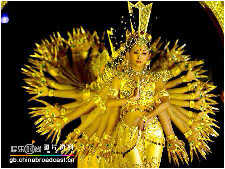
Video Avalokitesvara
(China Disabled People)
Video Quan Am Thi
Kinh (Thich Nhat Tu)
Thiên Thừa,天乘, Devayana (skt)—Một
trong ngũ thừa, có công năng đưa những người tu tập thiện nghiệp đến
một trong sáu cõi trời dục giới, cũng như đưa những người tu tập thiền
định đến những cảnh trời sắc giới hay vô sắc giới cao hơn—The deva
vehicle—Divine Vehicle—One of the five vehicles—It transports observers
of the ten good qualities (thập thiện) to one of the six deva realms of
desire, and those who observe dhyana meditation to the higher heavens
of form and non-form
Thiên Thức,天識, Chân Như—Natural
perception or wisdom—The primal endowment in men—The Bhutatathata (chân
như)
Thiên Thực,天食, Sudha (skt)—Thực
phẩm của chư Thiên gồm nước cam lộ, nước hồ đào và trường sanh bất
tử—Food of the gods include sweet dew, nectar and ambrosia
(A) Thực phẩm cho chư Thiên cao cấp màu trắng: White-coloured Food
for gods of higher ranks.
(B) Thực phẩm cho chư Thiên cấp thấp hơn thì có nhiều màu (xanh,
vàng, đỏ): Coloured Food for gods of lower ranks (blue—yellow—red).
Thiên Thượng,天上, Những tầng trời bên
trên, như lục dục Thiên, lục sắc Thiên và lục vô sắc Thiên—The heavens
above, such as the six devalokas, six rupalokas and six arupalokas
Thiên
Thượng Thiên Hạ Duy Ngã Độc Tôn,天上天下唯我獨尊, “Trên trời dưới trời, riêng ta
cao nhất. Trên trời dưới trời riêng ta tôn quý nhất.” Đó là lời Đức
Phật lúc Ngài mới giáng sanh từ bên sườn phải Hoàng Hậu Ma Da và bước
bảy bước đầu tiên. Đây không phải là một câu nói cao ngạo mà là câu nói
để chứng tỏ rồi đây Ngài sẽ hiểu được sự đồng nhứt của bản tánh thật
của toàn vũ trụ, chứ không phải là bản ngã theo thế tục. Lời tuyên bố
nầy cũng là thường pháp của chư Phật ba đời. Đối với Đại Thừa, Ngài là
tiêu biểu cho vô lượng chư Phật trong vô lượng kiếp—The first words
attributed to Sakyamuni after his first seven steps when born from his
mother’s right side: “In the heavens above and earth beneath I alone am
the honoured one.” This is not an arrogant speaking, it bears witness
to an awareness of the identity of I, the one’s own true nature or
Buddha-nature with the true nature of the universe, not the earthly
ego. This announcement is ascribed to every Buddha, as are also the
same special characteristics attributed to every Buddha, hence he is
the Tathagata come in the manner of all Buddhas. In Mahayanism he is
the type of countless other Buddhas in countless realms and periods
Thiên Tiên,天仙, Deva-Rsis (skt)—Deva
and rsis—Heavenly fairies—Immortals—Deva genii—Thiên Tiên có nghĩa là
những người tu tiên đắc đạo được lên cõi trời—Heavenly Fairies are
people who cultivate and attain the Taoist path so that they are reborn
in Heavens
1) Ngài Long Thọ Bồ Tát đưa ra mười loại Tiên có đời sống đến
100.000 năm mới đi đầu thai—Nagarjuna gives ten classes of rsis whose
lifetime is 100,000 years, the they reincarnated.
2) Năm loại Tiên khác—Another category is fivefold:
· Thiên Tiên: Thiên Tiên ở quanh núi Tu Di—Deva-rsis in the
mountain round Sumeru.
· Thần Tiên: Những vị Tiên bay vút trên không trung—Spirit-rsis who
roam the air.
· Nhân Tiên: Những người đã đạt được năng lực trường sanh bất
tử—Humans who have attained the powers of immortals.
· Địa Tiên: Earth-rsis, subterranean.
· Quỷ Tiên: Pretas, or malevolent rsis.
Thiên Tiểu,偏小, Nghiêng về cái nhỏ,
chỉ sự thuyết pháp của Đức Phật trong 12 năm sau khi thành đạo (người
ta cho rằng nghĩa lý mà Đức Phật thuyết giảng trong thời kỳ nầy chỉ mới
là bước đầu hạn hẹp)—The partial and minor teaching of the Buddha
during the first twelve years of his ministry
Thiên Tiểu Tình,偏小情, Tư tưởng thiên
lệch nhỏ hẹp, cho rằng dù ngã giả, nhưng chư pháp là thật—The partial
or narrower idea that thought the ego is unreal, things are real
Thiên Tính: Nature.
Thiên Tôn,天尊,
1) Bậc tôn quý nhứt của chư Thiên—The most honoured among devas—The
highest of divine beings.
2) Thiên vương hộ pháp và những bậc tôn quý khác của chư Thiên—The
Maharaja protectors of Buddhism and others in the sense of honoured
devas.
3) Những bậc Thần Thánh của những người theo Lão Giáo: Title
applied by the Taosits to their divinities.
4) Danh hiệu của Đức Phật: A title of the Buddha.
Thiên Trúc,天竺, Hiền Đậu—Ấn
Độ—India—Hindu
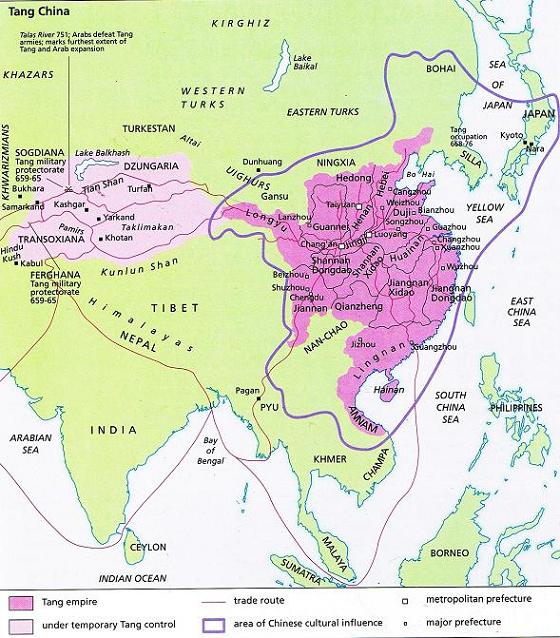
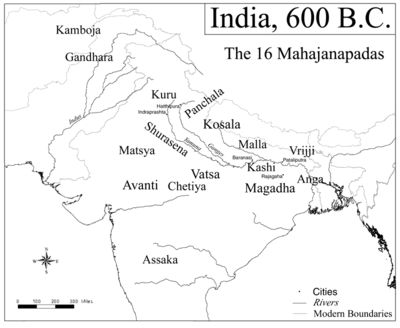
Thiên Trúc Cửu
Nghi,天竺九儀,
The nine forms of etiquette of India—See Cửu Nghi
Thiên Trúc Lục Thời: Sáu mùa trong năm ở Ấn Độ—Six seasons of a
year in India:
1) Tiệm Nhiệt Thời: Vasanta (skt)—Mùa nóng dần từ 16 tháng giêng
đến 15 tháng ba—Entering hot season, from the first month, sixteenth
day, to the third month, fifteenth.
2) Nhiệt Thời: Grisma (skt)—Mùa nóng từ 16 tháng 3 đến 15 tháng
5—From the third month, sixteenth day, to the fifth month,
fifteenth—See Thiên Trúc Tam Thời (1).
3) Vũ Thời: Varsakala (skt)—Mùa mưa từ 16 tháng 5 đến 15 tháng
7—From the fifth month, the sixteenth day, to the seventh month,
fifteenth—See Thiên Trúc Tam Thời (2).
4) Mậu Thời: Sarada (skt)—Mùa tươi tốt từ 16 tháng bảy đến 15 tháng
chín—Verdant season, from the seventh month, the sixteenth day, to the
ninth month, fifteenth.
5) Tiệm Hàn Thời: Hemanta (skt)—Mùa lạnh dần từ 16 tháng chín đến
15 tháng mười một—From the ninth month, the sixteenth day, to the
eleventh month, fifteenth—See Thiên Trúc Tam Thời (3).
6) Thịnh Hàn Thời: Sisira (skt)—Mùa cực lạnh từ 16 tháng mười một
đến 15 tháng giêng—Very-cold season, from the eleventh month, the
sixteenth day, to the first month, fifteenth.
Thiên Trúc Ngũ Sơn,天竺五山, Năm núi ở Ấn Độ,
những nơi mà Phật hội họp chúng đệ tử của Ngài—The five mountains of
India on which the Buddha assembled his disciples
1) Bề Ba La Bạt Thứ: Vaibhara.
2) Tát Đa Bát Na Cầu Ha: Nam Sơn Thạch Thất—Saptaparnaguha.
3) Nhân Đà La Thế La Cầu Ha: Indrasailaguha.
4) Tát Pha Thứ Hồn trực Ca Bát Ba La: Sarpiskundika-pragbhara.
5) Kỳ Xà Quật: Grdhrakuta.
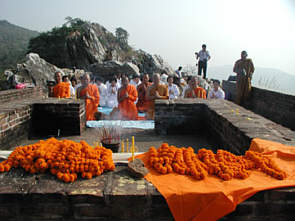
Thiên Trúc Quốc,天竺國,
1) Ấn Độ: India.
2) Thân Độc: Sindhu.
3) Hiền Đậu: Hindu.
4) Ấn Trì Già La hay Ấn Đà La Bà Tha Na: Indravadana or
Indrabhavana (skt)—Nơi cư ngụ của Trời Đế ThíchThe region where Indra
dwells.
Thiên Trúc Tam
Thời,天竺三時,
Ba mùa trong một năm ở Ấn Độ—Three seasons of an Indian year
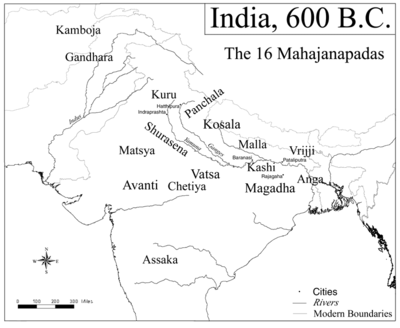
1) Nhiệt Thì: Grisma (skt)—Mùa nóng từ 16 tháng giêng đến 15 tháng
năm—The hot season, from first month sixteenth day, to fifth month,
fifteenth.
2) Vũ Thì: Varsakala (skt)—Mùa mưa từ 16 tháng năm đến 15 tháng
chín—The rainy season, from fifth month, sixteenth, to ninth month,
fifteenth.
3) Hàn Thì: Hemanta (skt)—Mùa lạnh từ 16 tháng chín đến 15 tháng
giêng—The cold season, from ninth month sixteenth, to first month
fifteenth.
Thiên Trúc Thập Nhị Nguyệt:
Mười hai tháng trong năm ở Ấn Độ—The
twelve months of a year in India:
1) Tháng Giêng: Caitra (skt)—January.
2) Tháng Hai: Vaisakha (skt)—February.
3) Tháng Ba: Jyaistha (skt)—March.
4) Tháng Tư: Asadha (skt)—April.
5) Tháng Năm: Sravana (skt)—May.
6) Tháng sáu: Bhadrapada (skt)—June.
7) Tháng Bảy: Asvayuja (skt)—July.
8) Tháng Tám: Karttika (skt)—August.
9) Tháng Chín: Margasirsa (skt)—September.
10) Tháng Mười: Pausa (skt)—October.
11) Tháng Mười Một: Magha (skt)—November.
12) Tháng Mười Hai: Phalguna (skt)—December.
Thiên Trung Thiên,天中天, Tôn hiệu của Đức
Phật (Thiên là đấng được người tôn kính, Phật là đấng được Thiên tôn
kính, nên gọi là Thiên Trung Thiên). Phật được danh hiệu nầy khi Ngài
thuyết pháp trên cung Thiên Vương. Ngày nay chúng ta còn thấy hình
tượng chư Thiên quỳ mọp trước mặt Ngài—Devatideva (skt)—Deva of devas.
The name given to Siddhartha (Sakyamuni) when, on his presentation in
the temple of Mahesvara (Siva), the statues of all the gods prostrated
themselves before him.
Thiên Tu Bồ Đề,天須菩提, Deva-Subhuti
(skt)—Một trong ba vị đệ tử Phật có tên là Thiên Tu Bồ Đề, vị nầy thì
thích ăn mặc áo quần tươm tất và sống đời tịnh hạnh—One of the three
Subhutis, disciples of the Buddha; said to have been so called because
of his love of fine clothing and purity of life
Thiên Tụ,篇聚,
(A) Nghĩa của Thiên Tụ—The meanings of “Thiên Tụ:
1) Làm sai: Wrong doing.
(B) Phân loại Thiên Tụ—Categories of “Wrong-doing”
1) Ngũ Thiên Tụ: Năm loại làm sai—Five kinds of wrong doing—See Ngũ
Thiên Tụ.
2) Lục Thiên Tụ: Six kinds of wrong doing-See Lục Thiên Tụ.
3) Thất Thiên Tụ: Seven kinds of wrong doing—See Thất Thiên Tụ.
Thiên Tư: Innate gift.
Thiên Từ,天祠,
Devalaya—Devatagara—Devatagrha (skt)—Đình miếu Bà La Môn—Brahminical
temples
Thiên Tử,天子, Son of heaven king—A
son of heaven
1) Vua hay Thái tử, những người đã từng tu tập thập thiện trong đời
trước và kết quả là đời nầy sanh ra làm vua hay thái tử—Emperor or
Princes, those who in previous incarnations have kept the middle and
lower grades of the ten good qualities (thập thiện), and in
consequence, are born here as princes or kings.
2) Thiên Tử Nghiệp Ma: Tên của một loài ma vương của cõi trời dục
giới thứ sáu, chuyên chống lại chân lý nhà Phật—The title of one of the
four maras, who is the lord of the sixth heaven of desire, who also
opposes the Buddha-truth.
Thiên Tử Nghiệp Ma: See Thiên Chủ.
Thiên Tý Thành,天臂城, Devadarsita or
Devadista (skt)—Nơi cư ngụ của ngài Thiện Giác Trưởng Giả, là cha của
Hoàng hậu Ma Da (mẹ của Đức Phật)—Deva-arm city, the residence of
Suprabhuddha, father of Maya (who is the mother of the Buddha)
Thiên Viên,偏圓,
1) Tương đối còn nghiêng lệch và viên mãn: Relative and complete.
2) Cái tương đối thiên lệch của Tiểu Thừa và cái viên mãn của Đại
Thừa: Partial and all-embracing, i.e. Hinayana and Mahayana.
3) Thông giáo và Viên giáo của tông Thiên Thai: The intermediate
schools and perfect schools (between Hinayana and Mahayana) of
T’ien-T’ai sect.
Thiên Võng: Heaven’s net.
Thiên Vương,天王, Bốn nhân vật có hình
dáng như quỷ. Theo truyền thuyết thì họ sống bên trên núi Tu Di, họ là
những thần hộ pháp, họ chiến đấu chống lại cái ác và bảo vệ cái thiện,
mỗi thiên vương canh giữ một phương—Mahasvara—Maharaja-devas—There are
four demonic-looking-figures deva kings in the first lowest devaloka
(Tứ Thiên Vương). According to the myth, they dwell on the world
mountain Meru and are guardians of the four quarters of the world and
the Buddha teaching. They fight against evil and protect places where
goodness is taught
1) Trì Quốc Thiên Vương: Dhartarastra (skt)—Deva king in the East.

2) Tăng Trưởng Thiên Vương: Virudhaka (skt)—Deva king in the South.
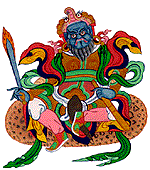
3) Quảng Mục Thiên Vương: Virupaksa (skt)—Deva king in the West.
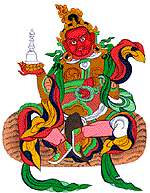
4) Đa Văn Thiên Vương: Dhanada or Vaisravana (skt)—Deva king in the
North.
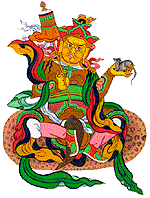
Thiên Vương Đường: The hall
of the deva kings.
Thiên Vương Như
Lai,天王如來,
Devaraja-Tathagata (skt)—Tên của vị Phật mà tiền thân là Đề Bà Đạt Đa,
kẻ đã nhiều lần hãm hại Phật—The name on which Devadatta, the enemy of
Sakyamuni Buddha, will be known on his future appearance as a Buddha in
the universe called Devasopana (Devadatta’s present residence in hell
being temporary for his karmaic expurgation).
Thiên Y,天衣, Deva garment, of
extreme lightness
Thiên Y Nghĩa Hoài: See Nghĩa Hoài Thiền Sư.
Thiên Y Phất
Thiên Tuế,天衣拂千歲,
Áo trời ngàn năm—Thí dụ lấy một tảng đá một dặm, hai dặm, vẩn đến mười
dặm vuông, rồi lấy áo trời chỉ nặng ba thù, cứ ba năm thì lấy áo quẹt
đá một lần, quẹt mãi cho đến khi mòn hết đá. Số thời gian áo trời quẹt
mòn hết tảng đá gọi là một tiểu kiếp—An illustration of the length of a
small kalpa: if a great rock, let it be one, two, or even 40 li-square,
be dusted with a deva garment once in a hundred years till the rock be
worn away, the kalpa would still be unfinished
Thiên Y Thiền Sư: Zen Master Tian-Yi-Yi-Huai—See Nghĩa Hoài Thiền
Sư.
Thiên Ý Thụ,天意樹, The tree in each
devaloka (tầng trời) which produces whatever the devas desire—See Thiên
Đức Bình (3)
Thiền,禪,Jhana (p)—Dhyana (skt)
Thiền: Jhana (p)—Dhyana (skt)—Tịnh lự hay đình chỉ các tư
tưởng
khác, chỉ chuyên chú suy nghĩ vào một cảnh)—To meditate—To enter into
meditation.

Video Toa Thien
(Buddhist Meditation)
Video Breathing
Meditation with Thich Nhat Hanh)
Video Living in the
Present Moment with Thich Nhat Hanh)
Những lời Phật dạy về “Thiền” trong Kinh Pháp Cú—The Buddha’s
teachings on “Dhyana” in the Dharmapada Sutra:
1) Tu Du-già thì trí phát, bỏ Du-già thì tuệ tiêu. Biết rõ hay lẽ
này thế nào là đắc thất, rồi nỗ lực thực hành, sẽ tăng trưởng thêm trí
tuệ—From meditation arises wisdom. Lack of meditation wisdom is gone.
One who knows this twofold road of gain and loss, will conduct himself
to increase his wisdom (Dharmapada 282).
2) Gìn giữ tay chân và ngôn ngữ, gìn giữ cái đầu cao, tâm mến thích
thiền định, riêng ở một mình, thanh tịnh và tự biết đầy đủ, ấy là bậc
Tỳ kheo—He who controls his hands and legs; he who controls his speech;
and in the highest, he who delights in meditation; he who is alone,
serene and contented with himself. He is truly called a Bhikhshu
(Dharmapada 362).
3) Này các Tỳ Kheo, hãy mau tu thiền định! Chớ buông lung, chớ mê
hoặc theo dục ái. Đừng đợi đến khi nuốt hườn sắt nóng, mới ăn năn than
thở—Meditate monk! Meditate! Be not heedless. Do not let your mind
whirl on sensual pleasures. Don’t wait until you swallow a red-hot iron
ball, then cry, “This is sorrow!” (Dharmapada 371).
4) Ai nhập vào thiền định, an trụ chỗ ly trần, sự tu hành viên mãn,
phiền não lậu dứt sạch, chứng cảnh giới tối cao, Ta gọi họ là
Bà-la-môn—He who is meditative, stainless and secluded; he who has done
his duty and is free from afflictions; he who has attained the highest
goal, I call him a Brahmana (Dharmapada 386).
Thiền Ba,禪波, Những lượn sóng hay
tư tưởng khuấy động trong lúc hành thiền—Disturbing waves, or thoughts
during meditation
Thiền Ba La Mật,禪波羅密, Dhyana-paramita
(skt)—Thiền định là hành pháp giúp chúng sanh đạt hoàn toàn tịnh lự,
vượt thoát sanh tử, đáo bỉ ngạn. Đây là Ba La Mật thứ năm trong Lục Độ
Ba La Mật—The attainment of perfection in the mystic trance, crossing
the shore of birth and death. This is the fifth of the six paramitas
Thiền Bệnh,禪病, Các loại bệnh gây ra
bởi người tham thiền mà không hiểu rõ về thiền như vọng tưởng hay vọng
kiến—The illnesses of meditation, i.e. wandering thoughts, illusions,
or the illusions and nervous troubles of the mystic
Thiền Cầu,禪毬, Quả cầu lông dùng để
ném đánh thức người tu thiền ngủ gật (trong Luật Thập Tụng, Đức Phật
dạy: “Có thầy tu ngủ gật trong lúc tọa thiền, hãy lấy nước gội đầu. Nếu
cứ ngủ gật nữa thì lấy quả cầu lông mà ném. Nếu vẫn cứ còn ngủ gật thì
lấy Thiền trượng mà đánh)—A ball of hair or feather used to throw at
and awaken those who fell asleep during meditation
Thiền Cuồng: Mad Zen—See Cuồng Thiền.
Thiền Cư,禪居,meditation hall
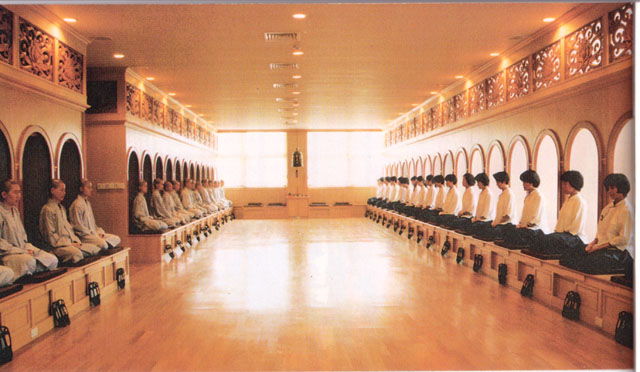
1) Một nơi để tu tập thiền định: A meditation abode—See Thiền
Đường.
2) Vào Thiền: To dwell in meditation.
3) Thiền Tăng: A hermit monk.
Thiền Duyệt,禪悅, Tâm thần khoan khoái
vui thích của người nhập vào thiền định—Joy of the mystic trance
Thiền Duyệt Thực,禪悅食, Sức mạnh nuôi
dưỡng tâm thức của Thiền, khi nhập vào thiền định thì thân tâm nhẹ
nhàng khoan khoái giúp trưởng dưỡng thân thể và huệ mạng—The nourishing
powers and the joy of the mystic trance of Zen
Thiền Đại Thừa: Mahayana Meditation—Đây là phương pháp tu thiền
định dựa trên kinh điển Đại Thừa. Thiền Đại Thừa là loại thiền đốn ngộ
hay thượng thừa thiền. Thiền Đại Thừa nhấn mạnh: “Ai cũng có thể thiền
định, đi đến đại ngộ và đạt thành Phật Quả.”—This is the method of
practicing meditation which is based on the Mahayana Sutras. Mahayana
Meditation is considered as “Instant Awakening Meditation,” or “Supreme
Meditation.” Mahayana Meditation emphasizes: “Everyone is able to
meditate, is able to be awakened instantly and attain the Buddhahood.”
Thiền Định,
禪定, Dhyana and Samadhi
(skt)
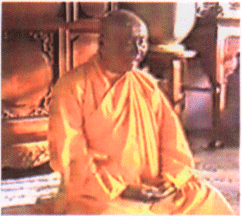 Phuong
Phap Toa Thien (HT Thanh Tu)
Phuong
Phap Toa Thien (HT Thanh Tu)
(I) Nghĩa của Thiền Định—The meanings of Samadhi:
a) Thiền theo tiếng Phạn là Dhyana. Thiền là một yếu tố của Định;
tuy nhiên, cả hai từ được dùng gần như lẫn lộn với nhau: Dhyana is
Meditation (Zen), probably a transliteration. Meditation is an element
of Concentration; however, the two words (dhyana and samadhi) are
loosely used.
b) Định theo tiếng Phạn là Samadhi. Định bao trùm toàn bộ bối cảnh
của Thiền, để tâm chuyên chú vào một đối tượng mà đạt tới trạng thái
tịch tĩnh không tán loạn—Concentration is an interpretation of Samadhi.
Samadhi covers the whole ground of meditation, concentration or
abstraction, reaching to the ultimate beyond emotion or thinking.
Thiền Định Ba La Mật:
Dhyana-paramita (skt)—Thiền định Ba La Mật là
cửa ngõ đi vào hào quang chư pháp, vì nhờ đó mà chúng ta đạt đến định
tỉnh cũng như những nội lực thâm diệu, và cũng nhờ đó mà chúng ta có
thể dạy dỗ và hướng dẫn những chúng sanh có tâm trí tán loạn—Dhyana
paramita is a gate of Dharma-illumination; for with it, we accomplish
all balanced states of dhyana and wonderfully profound powers, and we
teach and guide distracted living beings.
Thiền Định Tinh Tấn: Dhyana and Virya (skt)—Meditation balance and
diligence—Hai trong sáu Ba la mật—Two of the six paramitas.
Thiền Đốn Ngộ:
Sudden-enlightened Zen.
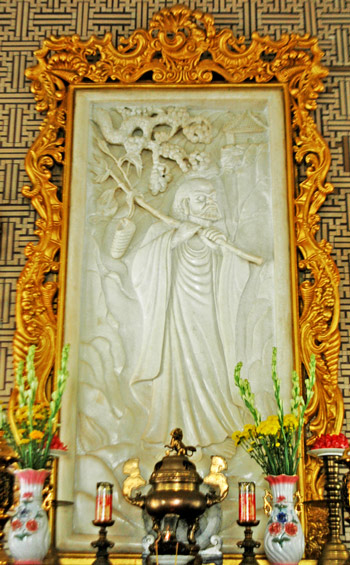
Video Thien Quan
& Giai Thoat (Thich Nhat Tu)
· Thiền phái được truyền từ Tổ Bồ Đề Đạt Ma. Theo Thiền sư D.T.
Suzuki trong Thiền Luận, Tập I, sự phân hóa dưới thời Ngũ Tổ Hoằng Nhẫn
thành hai tông phái của Huệ Năng và Thần Tú giúp cơ duyên cho Thiền
phát triển thuần túy hơn bằng cách tước bỏ những yếu tố không cần
thiết, hoặc nói đúng hơn, những yếu tố không tiêu hóa được. Rốt cùng
phái Thiền Đốn ngộ của Huệ Năng tồn tại vượt qua Thần Tú, chứng tỏ
Thiền Đốn Ngộ ứng hợp một cách tuyệt hảo nhất với nếp tâm lý và cảm
nghĩ của người Trung Hoa—Zen sect transmitted from Bodhidharma.
According to Zen master D.T. Suzuki in the Essays in Zen Buddhism, Book
I, the differentiation of two schools under the fifth patriarch, by
Hui-Neng and Shen-Hsiu, helped the further progress of pure Zen by
eliminating unessential or rather undigested elements. Eventually the
school of Hui-Neng survived the other proves that his Zen was in
perfect accord with Chinese psychology and modes of thinking.
· Thiền đốn ngộ có bốn đặc tính đặc thù Sudden-enlightened Zen is
distinguished by four characteristics:
1) Bất Lập Văn Tự: It is not established by words.
2) Giáo Ngoại Biệt Truyền: It is a special transmission outside the
teachings.
3) Trực Chỉ nhân Tâm: It directly points to the human mind.
4) Kiến Tánh Thành Phật: Through it one sees one’s own nature and
becomes a Buddha.
Thiền Đường,禪堂, Meditation Center
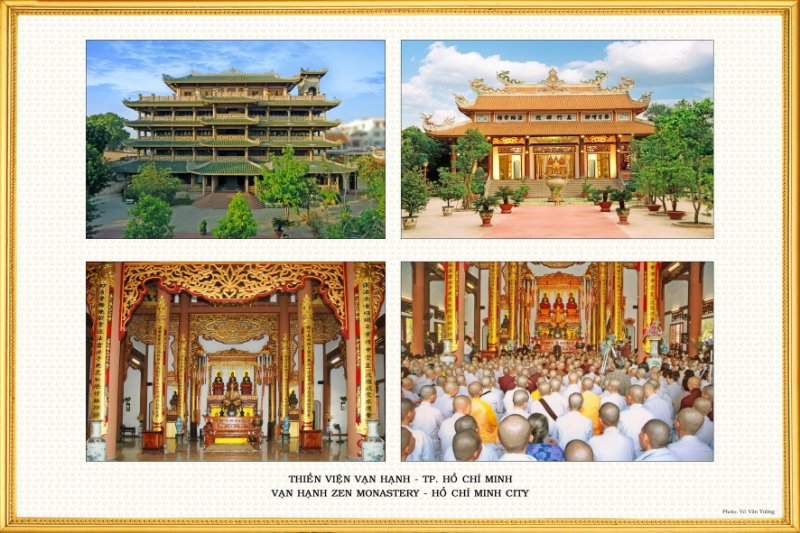
Video Introduction
to Buddhist Meditation
Video Breathing
Meditation
Thiền đường là một
căn phòng căn nhà lớn trong tự viện hay thiền viện. Tại các chùa lớn,
thường Thiền Đường là một kiến trúc biệt lập chỉ để thực hành tọa
thiền, chứ không có các nghi lễ khác—Buddhist meditation hall
(center)—Buddhist temple or Zen hall (room) or meditation hall of the
Ch’an sect. In large temples, meditation hall is a separate structure,
where only meditation is practiced without any other ceremonies
Thiền Gia,禪家, Thiền Tông—Thiền Môn
1) Người tu thiền: Meditator.
2) Phật Tử: Buddhist.
3) Thiền Tông: The Ch’an Sect.
Thiền Giáo,禪教,
1) Giáo pháp nhà Thiền: Giáo thuyết xiển dương tông chỉ nhà Thiền
(trực chỉ nhân tâm, kiến tánh thành Phật)—The teaching of the Ch’an
(Zen) sect.
2) Thiền và Giáo: Thiền Tông (bất lập văn tự, giáo ngoại biệt
truyền) và Giáo Tông (lấy học và hiểu làm chính yếu)—The esoteric
tradition and the teaching of the scriptures.
Thiền Hà,禪河,
1) Thiền định được ví như dòng sông Thiền dập tắt lửa tâm: The
dhyana river, i.e. the mystic trance like a river extinguishes the
fires of the mind.
2) Sông Ni Liên Thiền chảy ngang qua Bồ Đề Đạo Tràng: The river
Nairanjana (Niladyan), which flows past Gaya.

Thiền Hành: Hành pháp tọa
thiền hay hành nghi của thiền gia—The
methods employed in meditation; the practices, or disciplines, of the
Ch’an school.
Video Peace is Every
Step (Thich Nhat Hanh)
Video Living in the
Present Moment (Thich Nhat Hanh)
Video Mindful
Movement (Thich Nhat Hanh)
Thiền Hóa: Tánh chất chuyển hóa của Thiền—The transforming
character of Ch’an.
Thiền Hòa,禪和, Thiền Hòa Giả—Thiền
Hòa Tử—Bạn đồng tu thiền (lời xưng hô thân tình đạo
vị)—Meditation-associates, or fellow monks
Thiền Hòa Giả: See Thiền Hòa.
Thiền Hòa Tử: See Thiền Hòa.
Thiền Tuệ,禪慧, Thiền dịnh và trí
huệ (y vào hai món nầy thì có thể nhiếp hết thảy các hành chứng)—The
mystic trance and wisdom
Thiền Khách: Zen guest.
Thiền Lạc: Sự hỷ lạc trong thiền định—The joy of abstract
meditation.
Thiền Lâm,禪林,Monastery
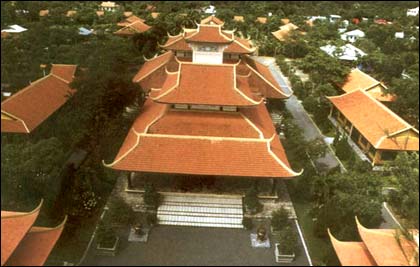
1) Rừng Thiền: Meditation forest or grove of meditation.
2) Tự viện hay Thiền viện: Pagoda or a monastery.
3) Tự viện hay Thiền viện nhiều như cây trên rừng: Monasteries as
numerous as trees in a forest.
Thiền Luật,禪律, Thiền Tông và Luật
Tông—The Ch’an and Vinaya sects, i.e. the Meditative and Disciplinary
schools
** For more information, please see Thiền
Tông and Luật Tông.
Thiền Lục,禪錄, Ký lục của Thiền
Tông—The records of the Ch’an sect
Thiền Lữ,禪侶,
1) Bạn đồng tu Thiền: Fellow-meditators.
2) Tăng lữ đồng tu: Fellow-monks.
Thiền Môn,禪門,Meditation school,Zen
sect

Video Zen Garden
& Music
Video
Hinh Anh Vang Trang (Thich Nhat Tu)
1) Pháp Môn Thiền Định nói chung: The meditative method in general.
2) Thiền Ba La Mật: Dhyana paramita—See Lục Độ Ba La Mật.
3) Thiền Tông được Tổ Bồ Đề Đạt Ma truyền sang Trung Quốc, tâm tâm
tương truyền như một trường phái mật giáo: The intuitional school
established in China according to tradition by Bodhidharma, personally
propagated from mind to mind as an esoteric school.
Thiền Môn Ngũ Tông,禪門五宗, Năm tông phái
Thiền (Từ Sơ Tổ Bồ Đề Đạt Ma đến Lục Tổ Huệ Năng, Thiền Tông Trung Quốc
vẫn là một tông duy nhất, nhưng sau đó được chia làm năm tông)—The five
Ch’an schools
1) Lâm Tế Tông: Tông Lâm Tế vẫn còn tồn tại đến hôm nay và rất
thành công. Dưới thời nhà Tống, tông nầy chia làm hai nhánh là Dương Kỳ
và Hoàng Long—Lin-Ji Sect, which remains and is very successful until
this day. During the Sung dynasty, it divided into two sects of Yang-Qi
and Hung-Lung.
2) Quy Ngưỡng Tông (đã bị mai một): Kui-Yang Sect, disappeared.
3) Vân Môn Tông (vẫn còn tồn tại đến nay): Yun-Men Sect, remains
until this day.
4) Pháp Nhãn Tông (đã du nhập Cao Ly): Fa-Yan Sect, which was
removed to Korea.
5) Tào Động Tông (vẫn còn tồn tại đến nay): Tsao-Tung Sect, remains
until this day.
** The second already disappeared; the fourth was removed to Koea;
the other three remained, the first being the most successful.
Thiền Na,禪那, Dhyana (skt)
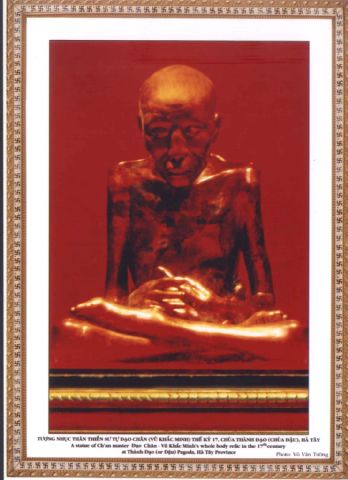
Video
Hinh Anh Vang Trang (Thich Nhat Tu)
(A) Thiền Na là thuật ngữ Trung Hoa, do từ tiếng Phạn “Dhyana” mà
ra. Thiền Na chỉ sự tập trung tinh thần và sự tĩnh tâm, trong đó mọi sự
phân biệt nhị nguyên đều biến mất—Ch’an-na is a Chinese version from
the Sanskrit word “Dhyana,” which refers to collectedness of mind or
meditative absorption in which all dualistic distinctions disappear.
(B) Tịnh lự—Làm vắng lặng dòng suy tưởng. Thiền Na là Ba La Mật thứ
năm trong lục độ Ba La Mật (thực tập thiền na để được trí huệ Bát Nhã),
trong đó tất cả mọi biện biệt giữa chủ thể và đối tượng, giữa thật và
giả, đều bị xóa bỏ—Quiet thought—Quiet meditation—The fifth paramita
(to practice dhyana to obtain real wisdom or prajna). In dhyana all
dualistic distinctions like subject, object, true, false are
eliminated.
· Abstract.
· Meditation.
· Thought.
· Reflection.
· Profound and abstract religious contemplation.
· Get rid of evil.
· Quiet meditation.
Thiền Nhân,禪人, Một thành viên của
Thiền phái—A member of the Ch’an (Zen) (Meditative or Intuitive) sect
Thiền Ni,禪尼, Ni Cô—A nun
Thiền Phái Nhật Bản:
Japanese Zen sects:
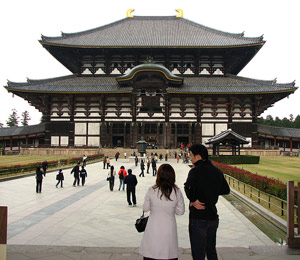
Video Zen
Garden
& Music
Video Japanese
Temples 2
(A) Lịch sử Thiền phái Nhật Bản—The history of Japanese Zen sects:
Theo Giáo sư Junjiro Takakusu trong Cương Yếu Triết Học Phật Giáo,
Thiền du nhập vào Nhật Bản bằng nhiều đợt—According to Prof. Junjiro
Takakusu in The Essentials of Buddhist Philosophy, Zen was introduced
to Japan several times:
1) Đệ tử của Huyền Trang là Đạo Chiêu (Doshô 629-700), đến Trung
Quốc vào năm 654, lần đầu tiên mang Thiền về truyền bá tại Thiền đường
Gangôji ở Nara: Hsuan-Tsang’s pupil, Dosho, who went to China in 654
A.D., introduced and taught Zen for the first time in the Zen Hall of
Gangôji, Nara.
2) Kế đến là Đạo Tuấn (Dosen), một vị luật sư Trung Hoa, đến Nara
năm 710 và truyền Bắc Tông. Ngài truyền pháp cho Hành Biểu (Giôhyô) năm
733 và Hành Biểu truyền cho Tối Trừng: Next, Tao-Hsuan, a Chinese
Vinaya (discipline) master, came to Nara in 710 A.D. and taught the Zen
of the Northern School. He transmitted it to Giôhyô in 733 A.D., who in
turn taught it to Saicho (Dengyô Daishi).
3) Một vị Thiền sư Nam tông là Nghĩa Không (Giku), là đệ tử của
Diêm Quan Tề An (Enkwan Saian) đến Kyoto và giảng Thiền từ năm 851 đến
858 tại chùa Đàn Lâm Tự (Danrinji) do hoàng hậu của Ta Nga Thiên Hoàng
(Danrin) lập nên. Ông thành công mỹ mãn trong công cuộc truyền bá giáo
pháp của ông: A special Zen instructor of the Southern School, Giku, a
pupil of Ch’i-An, came to Kyoto and taught Zen from 851 to 858 A.D. in
Danrinji Temple built by the Empress Danrin. He was successful in his
teaching.
***Trong những trường hợp kể trên, sự truyền bá đều được triều đình
ủng hộ nhưng không bền lâu. Vị thiền sư sau cùng phải thất vọng bỏ về
Trung Quốc năm 858, để lại một thành tích là Lã Sanh Môn (Rashomon),
Kyoto, ghi chứng một kỷ lục về sự truyền bá Thiền tại Nhật Bản: In all
the above cases the propagation was assisted by the Court but did not
continue long. The last-mentioned teacher went home disappointed in 858
A.D., leaving a monument at Rashomon, Kyoto, inscribed: “A record of
the propagation of Zen in Japan.”
(B) Triết lý Thiền—Zen philosophy: Cốt lõi của Thiền tông được tóm
lược như sau: “Cứ nhìn vào trong tâm thì sẽ thấy được Phật quả.” Tông
phái nầy nhấn mạnh vào sự thiền định hay thiền quán mà chỉ riêng một
điều nầy đã có thể dẫn đến giác ngộ. Thiền sư Dogen, một trong những
hình ảnh tiêu biểu của Thiền tông Nhật Bản. Ông đã bắt đầu cuộc sống tu
sĩ với sự tìm lời giả đáp cho câu hỏi: “Vì sao có nhiều vị Phật phải
hành trì con đường giác ngộ cho mình như thế, trong khi tất cả chúng
sanh đều đã sẵn có Phật quả nơi họ?” Không tìm được người nào ở Nhật
Bản có thể giải đáp thỏa đáng cho mình, ông đã đi đến Trung Quốc để tìm
sự soi sáng. Tại đây, ông đã được giác ngộ bởi một tu sĩ Phật giáo
Thiền tông. Khi trở về Nhật Bản, ông truyền bá chủ thuyết: “Tất cả mọi
người đều đã được giác ngộ. Về bản chất, họ là những vị Phật. Hành
Thiền chính là một hành động của Phật.”—The essence of Zen Buddhism is
summed up as follows: “Look into the mind and you will find
Buddhahood,” this sect lays great stress on meditation or contemplation
which alone can lead one to enlightenment. Zen master Dogen, one of the
most important and representative features of Zen Buddhism. Dogen
started his monastic life as a monk seeking an answer to the question:
“Why did so many Buddhas practise the way of self-enlightenment,
although all living beings, by their very nature, already had
Buddhahood in them." As nobody in Japan could satisfy him with a
convincing answer, he went to China to seek light. There he attained
enlightenment under the instruction of a Zen Buddhist monk. On his
return to Japan he propagated the following doctrine: “All human beings
have already been enlightened. They are Buddhas by nature. The practice
of meditation is nothing but the Buddha’s act itself.”
(C) Các Thiền phái Nhật
Bản—Japanese Zen sects:
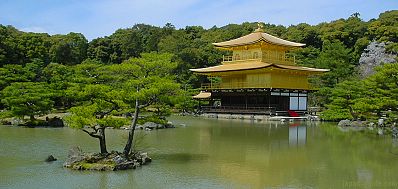
1) Phái Chân Ngôn: Shingon
Sect—Các giáo lý và phương pháp tu tập
của phái nầy được đưa vào Nhật Bản từ Trung Quốc bởi Kukai (hay Hoằng
Pháp Đại Sư vì ông được biết qua danh hiệu nầy nhiều hơn) vào thế kỷ
thứ IX. Pháp môn tu hành của phái Chân Ngôn xoay quanh ba phương thức
quán tưởng: mạn đà la, mật chú, và thủ ấn—The doctrines and practices
of this sect were brought from China to Japan in the ninth century by
Kukai (or Kobo-daishi, as he is more popularly known). Shingon
discipline and practice revolve around three meditational devices: the
mandala, the mantra, and the mudra.
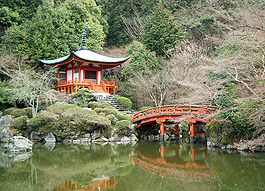
2) Phái Lâm Tế: Lin-Chi
sect—Giáo lý phái Lâm Tế được Vinh Tây Minh
Am (1141-1215) thiết lập vững chắc ở Nhật. Phái Lâm Tế đặc biệt mạnh ở
Kyoto, nơi có nhiều chùa và tự viện hàng đầu của phái nầy—The teachings
of Lin-Chi sect were firmly established in Japan by Eisai Myoan
(1141-1215). The Lin-Chi sect is particularly strong in Kyoto, where
many of its head temples and monasteries are located.
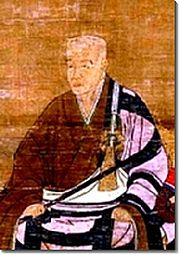
3) Phái Hoàng Bá: Huang-Po
Sect—Thiền phái nầy được Ấn Nguyên đại
sư đưa vào Nhật Bản năm 1654. Tổ đình phái nầy xây theo kiểu Trung Quốc
là chùa Mampuku gần Kyoto. Phái Hoàng Bá là thiền phái ít có ảnh hưởng
nhất ngày nay tại Nhật Bản—This Zen sect was introduced into Japan from
China in 1654 by Zen master Yin-Yuan. Its head temple built in the
Chinese style, is Mampukuji, near Kyoto. Huang-Po sect is the least
influential of the Zen sects in present-day Japan.
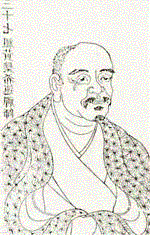
4) Phái Tào Động: Ts’ao-Tung
sect—Một trong hai thiền phái có thế
lực hơn cả ở Nhật Bản, phái kia là Lâm Tế. Có nhiều thuyết nói về nguồn
gốc của cái tên “Tào Động.” Một cho rằng đây là chữ đầu của tên của hai
vị thiền sư Động Sơn Lương Giới và Tào Sơn Bổn Tịch. Thuyết khác cho
rằng chữ Tào chỉ Lục Tổ, vì ngài cũng được biết qua tên Tào Khê Huệ
Năng—One of the two dominant Zen sects in Japan, the other being the
Lin-Chi. There are several theories as to the origin of the names of
Ts’ao-Tung. One is that it stems from the first character in the names
of two masters in China, Tung-Shan-Liang-Chih and Ts’ao-Shan-Pen-Chi.
Another theory is that the Ts’ao refers to the Sixth Patriarch, who was
also known in Japan as Ts’ao-Tzi-Hui-Neng.
Thiền Phạm Thiên,禪梵天, Ba cõi trời Phạm
Thiên trong cõi Sơ Thiền sắc giới—The three Brahmaloka heavens of the
first dhyana
** For more information, please see Thiên
Thiền Pháp,禪法, Pháp môn hay tông
chỉ nhà Thiền được tìm thấy trong Như Lai Thiền trong các kinh điển, và
Tổ Sư Thiền hay Đạt Ma Thiền được Tổ Bồ Đề Đạt Ma truyền sang Trung
Quốc (phép thiền mầu nhiệm được truyền cho nhau bằng tâm ý giữa các vị
tổ sư)—Methods of mysticism as found in the dhyanas records in the
sutras (Tathagata-dhyanas) and traditional dhyana, or the intuitional
method brought to China by Bodhidharma
Video
Thien Quan va Giai Thoat (Thich Nhat Tu)
Thiền Phòng,禪房,Meditation Hall
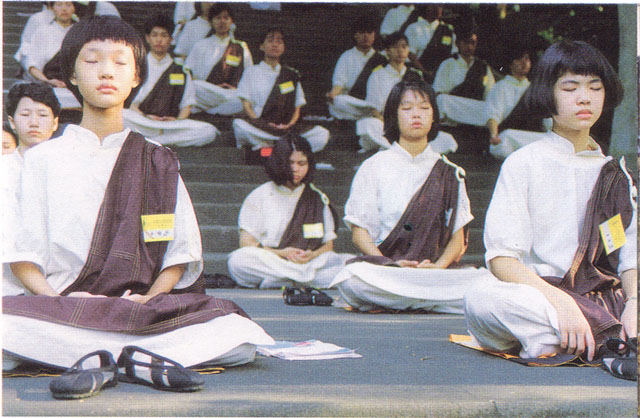
Video Anh Sang Phap
lac That (Cai luong)
1) Nơi hành thiền: Meditation abode, a room for meditation, a cell,
a hermitage—See Thiền Đường.
2) Tên thường dùng để gọi “Tự Viện”—A common name for a monastery.
Thiền Quán:
Dhyana-contemplation—Visualization—Calling to
attention—Imagining in the mind.
Thiền Quán Và Niệm Phật: Thiền quán là phương cách khó thực tập.
Phật dạy người tu Thiền trước tiên phải tu phép “Tứ Niệm Xứ,” quán thân
bất tịnh, quán thọ thị khổ, quán tâm vô thường, quán pháp vô ngã. Khi
đã biết thân, thọ, tâm, pháp đều không sạch, khổ, vô thường và vô ngã,
đều giả dối như mộng huyễn, thì chơn tánh sẽ tự hiển bày. Vài người cố
gắng thật nhiều để tập trung tư tưởng và loại bỏ những lôi cuốn bên
ngoài, nhưng tâm họ vẫn bận bịu đủ thứ. Tuy nhiên, nếu họ cố gắng niệm
Phật thì họ có thể dễ dàng đạt đến nhất tâm bất loạn. Hơn nữa, Kinh
điển Tịnh Độ đơn giản, dễ hiểu và dễ thực hành. Nếu có đầy đủ tín, hạnh
nguyện và dụng công niệm Phật, thì Phật A Di Đà và Thánh chúng sẽ gia
hộ tiếp dẫn về Tây Phương Cực Lạc—Meditation is a difficult way to
practise. The Buddha taught: “Zen practitioners who want to cultivate
must, first of all, practice the Four Foundations of Mindfulness, to
contemplate the body is impure, all feelings as suffering, the ordinary
mind as impermanent and all phenomena as lacking self-nature. When we
realize that body, feelings, mind and phenomena are impure, the source
of suffering, impermanent, without self-nature, false, dream-like and
illusory, the True Thusness Nature will manifest itself. Some people
have tried very hard to concentrate and abandon all distractions, their
mind is still preoccupied with all delusions. However, if they try to
focus on recitation the Buddha’s name, they can reach
single-mindedness. Furthermore, the Pure Land Sutras are simple and
easy to understand and practice. If you are utterly sincere in your
faith, conducts and vows with all efforts, you will be welcome by
Amitabha Buddha and other Saints in the Western Pure Land.
Thiền Quán Về Tâm: Meditation on the mind—Qua thiền tập liên tục
chúng ta có thể thấy được tâm thanh tịnh. Chỉ có thiền tập liên tục,
chúng ta có thể vượt qua trạng thái tâm dong ruổi và xả bỏ những loạn
động. Cùng lúc chính nhờ thiền tập mà chúng ta có thể tập trung tư
tưởng để quán sát những gì khởi lên trong tư tưởng, trong thân, trong
cảm thọ, nghe, nếm, ngửi và tưởng tượng, vân vân. Qua thiền tập liên
tục, chúng ta có thể quán sát rằng tất cả là vô thường, từ đó chúng ta
có khả năng buông bỏ, và Niết bàn hiển hiện ngay lúc chúng ta buông bỏ
tất cả—Through continuous meditation we can perceive our mind clearly
and purely. Only through continuous meditation we can gradually
overcome mental wandering and abandon conceptual distractions. At the
same time we can focus our mind within and observe whatever arises
(thoughts, sensations of body, hearing, smelling, tasting and images).
Through continuous meditation we are able to contemplate that they all
are impermanent, we then develop the ability to let go of everything.
Nirvana appears right at the moment we let go of everything.
Thiền Quán Về Tâm Xả: Meditation on equanimity—Chúng ta nên thực
tập thiền quán về tâm xả để giảm thiểu sự phát triển của sân giận người
nầy và luyến ái người kia—We should try to achieve equanimity through
meditation to reduce developing of anger toward one person and
attachment toward another person.
Thiền Quật,禪窟, Hang động để hành
thiền hay an cư—A cell, or cave, for meditation, or retirement from the
world
Thiền Quyền,禪拳, Musti (skt)—Dấu hiệu
của thiền định được tượng trưng bởi nắm tay trái, tay phải tượng trưng
cho trí tuệ (Tượng Đức Phật Thích Ca có hai vị hộ pháp, bên trái là Bồ
Tát Phổ Hiền tượng trưng cho thiền định, bên phải là Bồ Tát Văn Thù
tượng trưng cho trí huệ)—The meditation fist, the sign of meditation
shown by the left fist, the right indicating wisdom
** For more information, please see Samantabhadra in
Sanskrit/Pali-Vietnamese Section and Văn Thù Sư Lợi in
Vietnamese-English Section.
Thiền Sinh: Meditator or Zen student.
Thiền Sư,禪師, Kammatthanacariya
(p)—A Zen Master—A meditation teacher
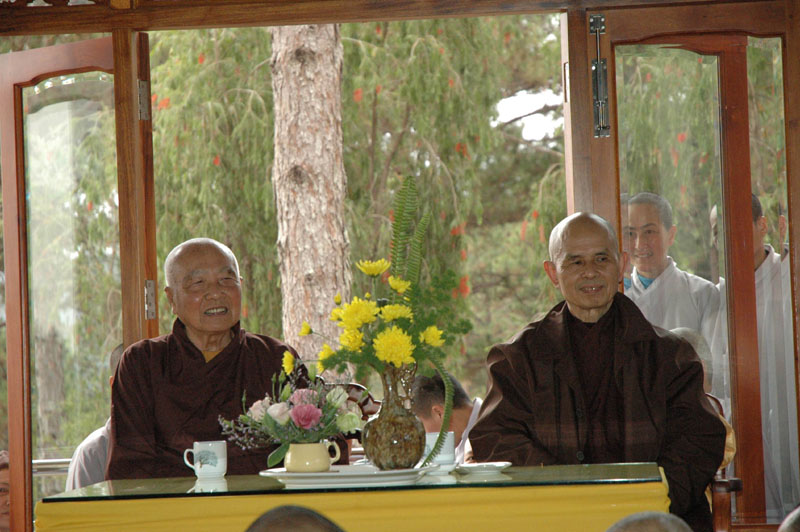
Video Huineng:
Chan/Zen Master
Video Peace is Every
Step (Thich Nhat Hanh)
Video Living in the
Present Moment (Thich Nhat Hanh)
Video Mindful
Movement (Thich Nhat Hanh)
1) Một vị Thầy dạy Thiền nói chung: A master, or teacher, of
meditation, or of the Ch’an school in general.
2) Một vị Thầy đã chứng ngộ và dạy thiền: A Zen master who has
already attained self-realization or enlightenment. He was allowed to
teach Zen to his disciples.
3) Bậc Thầy Thiền vĩ đại hay danh tiếng. Danh hiệu nầy thường được
phong tặng sau khi vị thầy đã viên tịch, mặc dù một vài bậc thầy đã đạt
được danh hiệu nầy ngay trong lúc còn sống: A great or renowned Zen
master. The title is usually conferred posthumously, though some
masters have achieved this distinction during their life time.
Thiền Sư Vạn Hạnh: Ngày
sanh của Thiền Sư không ai biết. Lúc thiếu
thời ông đã tỏ ra thông minh đỉnh ngộ phi thường. Ông xuất gia năm 21
tuổi. Ông thị tịch vào đêm trăng tròn năm 1018—Zen Master Vạn Hạnh’s
date of birth was unknown. At the young age, he was extraordinarily
intelligent. He left home at the age of 21. He died on the full moon
night of 1018—The author of this poem:
Thân như điện ảnh hữu hoàn vô
Vạn mộc xuân vinh thu hựu khô
Nhậm vận thịnh suy vô bố úy
Thịnh suy như lộ thảo đầu phô!
Our life is a simple lightning which
comes and goes (appears then disappears).
As springtime offers blossoms, only to fade (wither) in the fall.
Earthly flourish and decline, O friends, do not fear at all.
They are nothing but a drop of dew on the grass of morning!
Thiền Tam Muội,禪三昧, Thiền na và tam
muội—Dhyana and samadhi (skt)
1) Thiền na dịch là “tư duy.” Tư duy trong cõi sắc giới thì gọi là
thiền—Dhyana is considered meditating. Meditation in the visible or
known is called Dhyana.
2) Tam muội dịch là “định.” Tư duy trong cõi vô sắc giới thì gọi là
Tam Muội—Samadhi is considered as abstraction. Concentration on the
invisible, or supermundane is called Samadhi.
Thiền Tâm: Zen mind—Empty
mind is Zen mind: Vô tâm là thiền tâm.
Video Introduction
to Zen Mind
Video Zen Mind
Thiền Tập,禪習, Tu hành bằng cách
thực tập thiền—The practice of religion through the mystic trance
Thiền Tăng,禪僧, Một vị sư của Thiền
Tông hay một vị sư tu Thiền—A monk of the Zen (Ch’an) sect, a monk in
meditation
Thiền Thất,禪室, Thiền Cư—Thiền
Đường—Thiền Phòng—Thiện Viện—Meditation hall or room
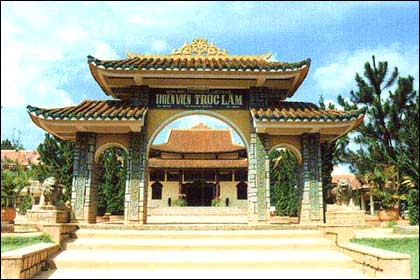
** For more information, please see Thiền
Đường.
Thiền Thiên,禪天, Có bốn Thiền Thiên,
nơi mà các bậc tu thiền có thể tái sanh về (cõi sắc giới có bốn tầng
trời mà người tu thiền sẽ được sanh về đấy)—Dhyana heavens, four in
number, where those who practice meditation may be reborn
** For more information, please see Tứ Thiền.
Thiền Thực: See Thiền Duyệt Thực.
Thiền Tịnh:
1) Thiền Tông và Tịnh Độ Tông: The Zen and the Pure Land sects.
2) Thiền tịnh dịch sang Hoa ngữ có nghĩa là thiền tịnh lự hay yên
lặng, kiểm soát tư tưởng: Dhyana in Chinese means quiet or silent
meditation, or quieting of thoughts (controlling of thoughts).
Thiền Tọa,禪坐, Tọa thiền (kiết
già)—To sit (cross-legged) in meditation

Phuong
Phap Toa Thien (HT Thanh Tu)
Video Zazen-A Guide
to Sitting
Thiền Tông,禪宗, The Zen Sect
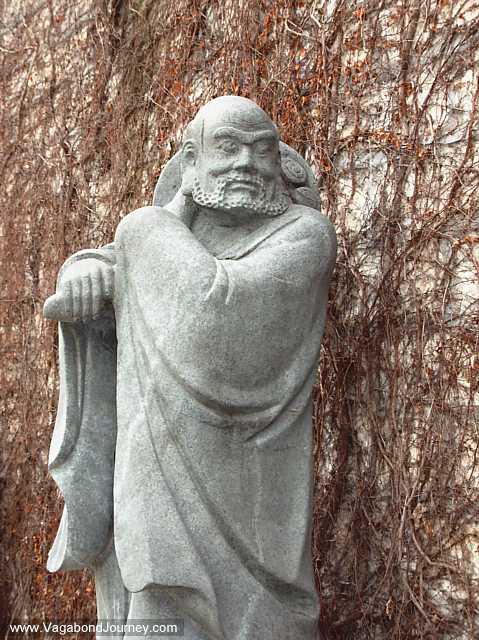
Video Huineng:
Chan/Zen Master
Video A Day in the
Life of a Zen Monk
Video Introduction
to Zen Mind
Video Zen Mind
Video Zen Buddhism
and Western Society
(I) Thiền Tông Trung Hoa—The Zen
Sect in China:
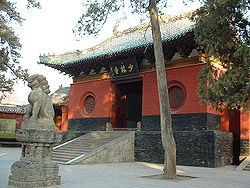
(A) Thiền tông, Phật Tâm tông, hay Vô Môn tông, được Tổ Bồ Đề Đạt
Ma, Tổ thứ 28 ở Ấn Độ, mang vào Trung Quốc. Thiền được coi như là một
trường phái quan trọng của Phật giáo. Tổ Bồ Đề Đạt Ma đến Trung Hoa vào
khoảng năm 470 và trở thành người sáng lập ra phái Mật Tông và Thiền
Tông ở đây. Người ta nói ngài đã hành thiền trước một bức tường của
Thiếu Lâm tự trong chín năm. Những đệ tử của Bồ Đề Đạt Ma hoạt động
mạnh mẽ ở mọi nơi và đã hoàn toàn chiến thắng các tôn giáo bản địa để
rồi cuối cùng Thiền tông được đánh giá rất cao ở Trung Quốc—The Ch’an
(Zen), meditative or intuitional, sect usually said to have been
established in China by Bodhidharma, the twenty-eighth patriarch, who
brought the tradition of the Buddha-mind from India. Ch’an is
considered as an important school of Buddhism. Bodhidharma came to
China about 470 A.D. and became the founder of esoteric and Zen schools
there. It is said that he had practised meditation against the wall of
the Shao-Lin-Tzu monastery for nine years. The followers of Bodhidharma
were active everywhere, and were completely victorious over the native
religions with the result that the teachings of Zen have come to be
highly respected everywhere in China.
· Sơ Tổ Bồ Đề Đạt Ma: The first patriarch Bodhidharma.
· Nhị Tổ Huệ Khả: The successor of Bodhidharma or the second
patriarch was Hui-K’o.
· Tam Tổ Tăng Sán: The third patriarch was Sêng-Ts’an.
· Tứ Tổ Đạo Tín: The fourth patriarch was T’ao-Hsin.
· Ngũ Tổ Hoằng Nhẫn: The fifth patriarch was Hung-Jên.
· Lục Tổ Huệ Năng: The sixth patriarch was Hui-Neng.
(B) Triết lý Thiền—Zen Philosophy
a) Theo triết lý chính của Thiền tông, nhìn vào nội tâm, chứ không
phải nhìn ra bên ngoài, là cách duy nhất để đạt đến sự giác ngộ mà
trong tâm trí con người thì cũng giống như là Phật quả vậy. Hệ tư tưởng
nầy chú trọng vào ‘trực cảm,’ với một đặc điểm là không có ngôn từ nào
để tự diễn đạt, không có một phương thức nào để tự giải thích, không có
sự chứng minh dài dòng nào về chân lý riêng của mình một cách thuyết
phục. Nếu có sự diễn đạt thì chỉ diễn đạt bằng ký hiệu và hình ảnh. Qua
một thời gian, hệ tư tưởng nầy đã phát triển triết lý trực cảm của nó
đến một mức độ khiến nó vẫn còn là một triết lý độc đáo cho đến ngày
nay: According to the Zen sect, the key theory of Zen, to look inwards
and not to look outwards, is the only way to achieve enlightenment,
which to the human mind is ultimately the same as Buddhahood. In this
system, the emphasis is upon ‘intuition,’ its peculiarity being that it
has no words in which to express itself, no method to reason itself
out, no extended demonstration of its own truth in a logically
convincing manner. If it expresses itself at all, it does so in symbols
and images. In the course of time this system developed its philosophy
of intuition to such a degree that it remains unique to this day.
(C) Cương yếu Thiền
Tông—Preliminary of the Zen Sect:
1) Theo Kinh Lăng Già, Thiền tông tin vào đốn ngộ, chứ không qua
nghi lễ hay kinh điển. Tu thiền trực ngộ bằng tuệ giác bên trong.
Truyền thống truyền thừa Mật giáo lấy câu chuyện Đức Phật trong hội
Linh Sơn giơ bông hoa, và ngài Ca Diếp trực ngộ bằng cái mỉm cười làm
nguồn gốc (dĩ tâm truyền tâm, giáo ngoại biệt truyền)—According to the
Lankavatara Sutra, the Zen sects believe in direct enlightenment,
disregarded ritual and sutras and depended upon the inner light and
personal influence for the propagation of its tenets, founding itself
on the esoteric tradition supposed to have been imparted to Kasyapa by
the Buddha, who indicated his meaning by plucking a flower without
further explanation. Kasyapa smiled in apprehension and is supposed to
have passed on this mystic method to the patriarchs.
(II) Thiền tông Việt
Nam—Vietnamese Zen


Phuong
Phap Toa Thien (HT Thanh Tu)
Video Anh Sang Phap
lac That (Cai luong)
Chính ra Khương Tăng Hội
là vị Thiền sư Việt Nam đầu tiên; tuy nhiên, thiền phái Việt Nam chỉ
bắt đầu được thành lập từ thời Thiền sư Tỳ Ni Đa Lưu Chi mà thôi. Phật
giáo Thiền tông có nhiều nhánh tại Việt Nam, là phái Tỳ Ni Đa Lưu Chi,
phái Vô Ngôn Thông, và phái Thảo Đường—Hjiang-Jing-Hui was the first
Vietnamese Zen master; however, Vietnamese Zen sects only developed at
the time of Zen master Vinitaruci. Zen Buddhism has several branches in
Vietnam, namely, the Vinitaruci, the Wu-Yun-T’ung, and the Tsao-T’ang.
1) Phái Tỳ Ni Đa Lưu Chi—Vinitaruci Zen sect: Dòng thứ nhất là dòng
Thiền Tỳ Ni Đa Lưu Chi, được khai sáng bởi một vị Tăng Ấn Độ, đệ tử của
Tam Tổ Tăng Xán—The first branch was founded in Vietnam by an Indian
monk named Vinitaruci, who was one of the great disciples of the third
patriarch, Seng-Ts’an—See Tỳ Ni Đa Lưu Chi and Tăng Xán.

2) Phái Vô Ngôn Thông—Wu-Yun-T’ung Zen sect: Dòng Thiền thứ nhì là
dòng Vô Ngôn Thông, được khai sáng bởi Thiền sư Vô Ngôn Thông, một
Thiền sư Trung Hoa, đệ tử của Tổ Bách Trượng Hoài Hải—The second branch
was founded by a Chinese Zen master named Wu-Yun-T’ung, a great
disciple of Pai-Ch’ang-Huai-Hai—See Vô Ngôn Thông, and Bách Trượng Hoài
Hải.
3) Phái Thảo Đường—Tsao-T’ang Zen sect: Dòng Thiền thứ ba là dòng
Thảo Đường, được khai sáng bởi Thiền sư Thảo Đường, đệ tử của Đức Sơn
Tuyên Giám—The third branch was founded by Tsao-T’ang, a disciple of
Te-Shan—See Thảo Đường Thiền Sư and Đức Sơn Tuyên Giám.
4) Phái Trúc Lâm—Trúc Lâm Zen sect: Dòng Thiền Trúc Lâm do sơ Tổ
Trần Nhân Tông khai sáng—Trúc Lâm Zen sect was founded by the first
patriarch Trần Nhân Tông—See Trần Nhân Tông.
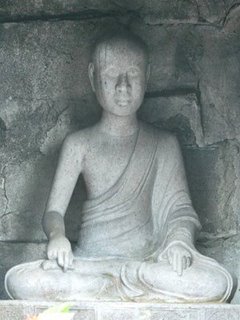
5) Phái Lâm Tế—Lin-Chi Zen sect: Phái Lâm Tế được truyền thẳng từ
Trung Hoa từ tổ Lâm Tế—The Lin Chi Zen sect was transmitted directly
from China from Lin Chi Patriarch.
6) Phái Tào Động—T’ao-T’ung Zen sect: Phái Tào Động được truyền
thẳng từ Thiền phái của Lục Tổ ở Tào Khê, Trung Quốc—T’ao-T’ung Zen
sect was transmitted directly from T’ao-Tsi, China.
(III) Thiền phái Nhật
Bản—Japanese Zen sects: Phật giáo Thiền tông
có ba nhánh tại Nhật Bản, gọi là Lâm Tế (Rinzai), Tào Động (Soto), và
Hoàng Bá (Obaku)—Zen Buddhism has three branches in Japan, namely, the
Rinzai, the Soto, and the Obaku—See Thiền Phái Nhật Bản.
Video Japanese
Temples 2
Thiền Trấn,禪鎭, Một miếng gỗ dùng để
gõ đầu vị sư ngủ gục trong lúc hành thiền—The meditation-warden, a
piece of wood so hung as to strike the monk’s head when he nodded in
sleep
** For more information, please see Thiền Cầu and Thiền Trượng.
Thiền Trí,禪智, Thiền định và trí
huệ—Meditation and wisdom
** For more information, please see Thiền Quyền, Samantabhadra, and
Văn Thù Sư Lợi.
Thiền Trượng,禪杖, Cây gậy dùng đánh
thức người hôn trầm khi ngồi tọa thiền (được làm bằng trúc hoặc sậy)—A
staff or pole for touching those who fall asleep while assembled in the
meditation
Thiền Tuệ,禪慧, See Thiền Huệ
Thiền Tủy,禪髓
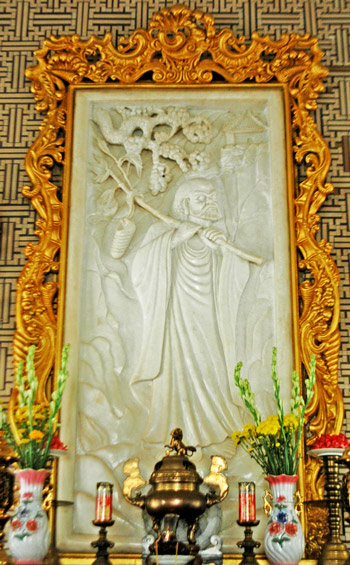
Kinh Lăng Già dùng
từ nầy với nghĩa là tinh túy hay cốt tủy của đạo Thiền, (sau 9 năm diện
bích, Tổ Bồ Đề Đạt Ma muốn trở về Ấn Độ; trước lúc ra đi ngài kêu chúng
đệ tử lại hỏi: “Về sau nầy nếu có ai hỏi về sở đắc của mình, các ngươi
có thể nói được chăng?” Phó Đạo thưa: “Theo con là không chấp văn tự,
mà chỉ vận dụng theo đạo.” Tổ nói: “Ngươi đã nắm được phần da của ta.”
Ni Tổng Trì thưa: “Theo con hiểu như ngài Khánh Hỷ chỉ thấy Phật A Súc
một lần rồi không thấy nữa.” Tổ nói: “Ngươi đã nắm được phần thịt của
ta.” Đạo Dục thưa: “Tứ đại đất nước lửa gió vốn không, ngũ ấm chẳng có,
nên con thấy không có một pháp nào khả đắc.” Tổ nói: “Ngươi đã được
phần xương của ta.” Huệ Khả từ ngoài bước vào làm lễ, rồi đứng đó chớ
không nói năng gì cả. Tổ nói: “Ngươi đã nắm được phần tủy của ta rồi
vậy.”)—The Lankavara Sutra uses the term with the meaning of the marrow
of meditation
Thiền Tư,禪思, Những tư tưởng kỳ bí
về thiền—Meditation thoughts; the mystic trance
Thiền Và Tịnh Độ: Zen and Pure Land—Thiền và Tịnh độ không hai. Nếu
liễu ngộ thì liễu ngộ cả hai; ví bằng mê mờ thì mê mờ cả hai, vì dù
thiền hay tịnh độ cũng đều quy tâm, ngoài tâm không pháp—Zen and Pure
Land have always been non-dual. If we thoroughly understand one, we
thoroughly understand both. If we fail to understand one, we will fail
on both, Zen or Pure Land focus on “Mind.” There are no dharmas outside
the mind.
Thiền Vị,禪味, Mùi vị của Thiền khi
nhập vào thiền định, thân tâm có cảm giác mùi vị tuyệt vời, nhẹ nhàng
khoan khoái, tịch tĩnh—Meditation-flavour, the mysterious taste or
sensation experienced by one who enter abstract meditation.
Thiền Viện: See Thiền Đường.
Thiển Học: Cái học nông cạn—Shallow (slight) knowledge.
Thiển Kiến: Ý kiến nông cạn—Shallow opinion.
Thiển Lạp,淺臘, Kém tuổi đạo, chỉ
các vị Tỳ Kheo tuổi hạ còn ít—Of few years, i.e. youthful in monastic
years
Thiển Lược,淺略, Những vấn đề thô
thiển và giản lược (ý nói những vấn đề mà Mật giáo ám chỉ Hiển
giáo)—Superficial—Simple—Not profound
Thiển Nghĩ: Theo ý kiến thô thiển của tôi—In my humble opinion.
Thiển Tài: Tài mọn—Slight (shallow) talent.
Thiển Thâm: Cạn và sâu—Shallow and deep.
Thiển Trí,淺智, Trí mọn—Shallow
(superficial) mind
Thiển Văn: See Thiển học.
Thiển Ý: Shallow opinion—In my humble opinion.
Thiện: Kusala, Su, Sadhu, or Bhadra (skt).
(I) Nghĩa của “Thiện”—The meanings of “Kusala”
1) Thiện là trái với ác: Những hành pháp hữu lậu và vô lậu thuận
ích cho đời nầy và đời khác (trên thông với Bồ Tát và Phật, dưới thấu
trời và người)—Kusala (skt)—Good—Proper—Right—Wholesome.
2) Đức Hạnh: Virtuous.
3) Giỏi về cái gì: Well—Good at.
4) Sắp lại cho có thứ tự: To put in order.
5) Sửa chữa: To repair.
6) Thiện xảo: Skillful.
Thiện Ác Bất Nhị: Good and evil are not dualism—See Bất Nhị.
Thiện Bẩm: Thiện tánh bẩm sinh—Endowment—Innate prospensity.
Thiện Bình,善甁, Bhadra-kumbha
(skt)—See Hiền Bình
Thiện Bổn:
1) Thiện căn: Good stock, or roots.
2) Gieo trồng thiện căn: Planting good seed or roots.
3) Thiện căn giác ngộ: Good in the root of enlightenment.
Thiện Cảm: Sympathy.
Thiện Cảm Sâu Xa: Profound sympathy.
Thiện Căn,善根, Kusala-mula
(skt)—Cái thiện của ba nghiệp thân, khẩu, ý có thể sinh ra diệu quả về
sau nầy—Good roots—Good qualities (of body, speech and mind), good seed
sown by a good life to be reaped later
Thiện Châu Phần Dương Thiền Sư: Shan-Chou-Fen-Yang—See Phần Dương
Thiện Châu.
Thiện Chí,善至, Avyapada-samkappa
(p)—Good will
Thiện Chính: Good policy.
Thiện Chung: Natural death—Death of old age.
Thiện Cử: Charitable work.
Thiện Đô,繕都, Jantu (skt)—Thiền
Đầu—Thiền Đậu—Thiền Đâu—Chúng sanh—All living beings
Thiện Giác,善覺, See Suprabuddha in
Sanskrit/Pali-Vietnamese Section
Thiện Hành: Good deeds.
Thiện Hiện,善現, Sudrsa (skt)
1) Vẻ đẹp đẽ mạnh khỏe hiện ra bên ngoài: Beautiful appearing—Well
being—Welfare—Well Manifest—Good manifestation—Healthy in appearance.
2) Tên của Ngài Tu Bồ Đề: Name of Subhuti (Tu Bồ Đề).
3) Ái Thân Thiên: Vị Trời ở cõi dục giới có thân hình tuyệt
diệu—The heaven of lovely form in the desire-realm, but said to be
above the devalokas.
4) Sudrsa (skt)—Cõi trời thứ bảy trong Phạm giới Thiên—The seventh
Brahmaloka, eighth of the Dhyana heavens.
Thiện Hiện Sắc: Sudrsa (skt)—See Thiện Hiện Thiên.
Thiện Hiện Thiên,善現天, Sudrsa (skt)—Cõi
Trời thứ ba trong Ngũ Tịnh Cư Thiên—Heaven of Beautiful Presentation,
the third heaven in the five pure-dwelling heavens
** For more information, please see Ngũ Tịnh
Cư Thiên.
Thiện Tuệ Địa,善慧地, Sadhumati
(skt)—See Thập Địa Phật Thừa (9)
Thiện Hữu,善友, Kalyanamitra (skt)—A
friend of virtue—The good companion—A friend in good life or one who
stimulates to goodness—A religious counselor

** For more information, please see Thiện Hữu Tri Thức.
Thiện Hữu Tri Thức: Kalyana-mitra (skt).
(I) Nghĩa của Thiện Hữu Tri Thức—The meanings of Good-Knowing
Friend (Advisor):
Thiện Kiến,善見, Sudarsana
(skt)—Beautiful to see—Good to see
** For more information, please see Tô Đạt
Lê Xá Na.
Thiện Kiến Thành,善見城, Sudarsana (skt)—A
Good-To-Behold City—See Thiên Đế Thích Thành
Thiện Kiếp,善劫, Bhadrakalpa
(skt)—Tên khác của Hiền Kiếp—A good kalpa, especially that in which we
live—See Hiền Kiếp
Thiện Lai,善來, Svagata, or Suvagata
(skt)—Welcome
1) Từ mà các vị Tỳ Kheo Ấn Độ dùng để hoan nghênh những người đến
chùa: The term which Indian Bhiksus used to welcome those who come to
the monastery.
2) Trong kinh điển Pali có ghi lại, xưa khi muốn nhận ai vào Tăng
đoàn, Phật chỉ nói “Thiện lai, Tỳ kheo!”—The Pali scriptures say that
the Buddha once accepted his followers into the monkhood, simply by
saying “Welcome, monk!”
3) Danh hiệu của Phật: A title of a Buddha—See Thiện Thệ.
Thiện Luật Nghi: Good rules and customs.
Thiện Ma Mạt
Lạt Nam,繕摩末剌諵,
Janma-marana (skt)—Sanh tử—Birth and death
** For more information, please see Sanh Tử and Nhị Chủng Sanh Tử.
Thiện Mỹ: Beautiful.
Thiện Nam Tín Nữ,善男信女, Good men and
believing (good) women—Good son and good daughter—Believers in
Buddhism.
Thiện Nam Tử,善男子, Những đứa con của
những gia đình tốt; từ Đức Phật dùng để gọi những người tại gia hay
xuất gia mà tín tâm nghe và hành trì Phật pháp—Good sons—Sons of good
families—Gentlemen—One of the Buddha’s terms to address to his
disciples
Thiện Nam Tử Thiện Nữ Nhân: Good men and believing women—See Thiện
Nam Tử.
Thiện Nghệ: To have experience in one’s profession—To be skilled in
one’s trade.
Thiện Nghiệp,善業, Wholesome karma—Good
karma—Good deeds—Skillful action—Kusala karma
Theo Kinh Pháp Cú, câu 183, Đức Phật dạy: “Chớ làm các điều ác,
gắng làm các việc lành, giữ tâm ý trong sạch. Ấy lời chư Phật
dạy.”—According to the Dharmapada Sutra, verse 183, the Buddha taught:
Not to do evil, to do good, to purify one’s mind, this is the teaching
of the Buddhas.”
Thiện Ngôn: Good words.
Thiện Nguyệt,善月, Ba tháng tốt để ăn
trường chay như tháng giêng, tháng năm và tháng chín; vì trong ba tháng
nầy quỷ thần sẽ đi rảo để báo cáo về hành vi của thế nhân—Good months,
i.e. the first, fifth and ninth; because they are the most important in
which to do good works and thus obtain a good report in the spirit
realm
Thiện Nha: Sudanta (skt)—Good teeth.
Thiện Nhân,善因,
1) Nhân do thiện căn mà tạo ra thiện quả: A wholesome cause will
produce a wholesome result (good fruit).
2) Một người tốt, tin theo thuyết nhân quả của Phật Giáo và sống
một đời thiện lành: A good man—An honest man, especially one who
believes in Buddhist ideas of causality and lives a good life.
Thiện Pháp: Good method—Good law—Good ways.
Thiện Pháp Hữu Lậu: Good deeds done in a mortal body is rewarded
accordingly in the character of another mortal body.
Thiện Quả,善果, Kết quả thiện diệu
nhờ nương vào thiện nghiệp—Good fruit from good cause; good fortune in
life resulting from previous goodness
Video
Nhan Qua Khong Sai (Thich Nhat Tu)
** For more information, please see Thiện Nhân (1).
Thiện Quỷ: See Thiện Thần, and Thiên Long Bát Bộ.
Thiện Sanh,善生,
1) Sujata (skt)—Sanh ra trong dòng hoàng tộc—Well-born, of high
birth.
2) Susambhava (skt)—Tiền thân của Đức Phật Thích Ca—A former
incarnation of Sakyamuni.
Thiện Sanh Kinh,善生經, See Kinh Lễ Sáu
Phương in Appendix A
Thiện Sự,善事, Good act
Thiện Tai,善哉, Sadhu (skt)—Lành
Thay! Quý hóa thay! (từ dùng để tán thán hay khen
ngợi)—Good—Excellent!—See Thiện Lai
Thiện Tài,善財, Skillful
Thiện Tài Đồng Tử,善財童子, Sudhana
(skt)—
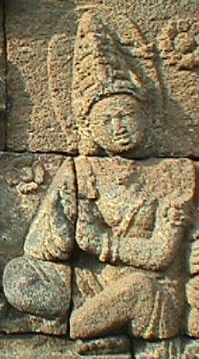
Thiện Tài Đồng Tử (trong các chùa , bên trái tượng Quan Âm Bồ Tát
có đặt tượng Thiện Tài Đồng Tử), một Phật tử được nói đến trong Kinh
Hoa Nghiêm. Tên ông là Sudhana có nghĩa là “Thiện Tài” và lý do ông có
tên nầy là vì lúc ông vừa mới sanh ra thì đột nhiên châu báu xuất hiện
trong nhà cha ông. Ông là nhân vật chính trong chương cuối cùng và cũng
là chương dài nhất trong Kinh Hoa Nghiêm. Trong khi tìm cầu giác ngộ,
ông đã viếng thăm và tòng học với 53 vị thiện hữu tri thức và đã trở
thành ngang hàng hay bình đẳng với Phật trong một đời (Trong Kinh Hoa
Nghiêm, phẩm Nhập Pháp Giới: “Ngài Văn Thù ở trong khu rừng trang
nghiêm có 500 vị đồng tử, mà Thiện Tài là một người phát tâm trong số
500 vị ấy. Thiện Tài sau đó đi về phương nam tham học cùng 53 vị tri
thức và chứng nhập pháp giới)—A disciple mentioned in the Avatamsaka
Sutra (Kinh Hoa Nghiêm). His name means “Good Wealth” and the reason
for him to obtain such name was that when he was born, myriad treasures
suddenly appeared in his father’s home. The main protagonist in the
last and longest chapter of the Avatamsaka Sutra. In seeking
enlightenment, he tried to visit and study with fifty-three spiritual
advisors and became equal with the Buddha in just one lifetime
Thiện Tánh,善性, Bản tánh thiện, một
trong tam tánh—Good nature—Good in nature, or in fundamental quality,
one of the three types of characters
**For more information, please see Tam Tánh.
Thiện Tâm,善心,
a) Tâm thiện lành với những tư tưởng thiện lành: Wholesome mind
(good heart—Good mind) withgood thoughts.
b) Tâm thiện lành bao gồm những việc làm thiện lành đối với tha
nhân, từ bi, bố thí, nhẫn nhục, ái ngữ, yêu thương, tín tâm, luôn
nguyện cứu độ tha nhân—Benevolence—Good mind includes beneficial
intentions towards others, compassion, loving-kindness, generosity,
patience, good speech, tolerance, love, faith, wishing to help others,
etc.
c) Thiện tâm giúp đẩy lùi những tâm tiêu cực: Wholesome mind can be
used to dispel negative minds.
Thiện Tâm Quán: Contemplation on good heart.
1) Thiện Tâm Quán hay quán yêu thương có thể tẩy trừ sân hận:
Contemplation on love can be used to dispel anger.
2) Ganh tỵ có thể vượt qua bằng cách quán sát lòng biết ơn và sự
hoan hỷ của tha nhân: Jealousy can be overcome by contemplating on
appreciation and rejoicing in the good qualities of others.
Thiện Thay! Thiện Thay!: Lành thay! Lành thay!—Sadhu (skt)—Good!
Excellent!
Thiện Thần,善神, Các vị thần hộ trì
Chánh Pháp—The good devas or spirits who protect Buddhism—Fortune
saints
** For more information, please see Thiên Long Bát Bộ.
Thiện Thệ,善逝, Sugata (skt)—Đấng
Thiện Thệ, một danh hiệu của Phật—The Blessed One—Well departed—A title
of a Buddha

Thiện Thủ,善取, To be skilful with
one’s hands
Thiện Tín: Good faith—Believers in Buddhism.
Thiện Tri,善知, Vibhavana (skt)—Nhận
biết rõ ràng—Clear perception
Thiện Tri Thức,善知識, Kalyanamitta
(p)—Kalyanamitra (skt)—Good-knowing advisor—A friend of vitue—A well
wishing friend—A learned master—A good friend or intimate, one well
known and intimate—See Thiện Hữu Tri Thức in Vietnamese-English Section
Thiện Túc: Upavasatha, or Posadha (skt).
1) Chỉ trú ngụ nơi điều thiện—Abiding in goodness.
2) Một vị Phật tử (tại gia) giữ được tám giới (bát quan trai giới):
A disciple who keeps eight commandments.
Thiện Tuệ Địa,善慧地, Sadhumati
(skt)—See Thập Địa Phật Thừa (9)
Thiện Vô Lậu Pháp: Kusalanasrava (skt)—Các đức tính tốt thoát khỏi
các lậu hoặc mà hành giả có trí tuệ hưởng được khi họ đắm mình sâu
trong hạnh phúc của Thiền định và an trú trong sự hiện hữu như thị
(đúng như sự hiện hữu)—Good virtues free from evil flowings by the wise
cultivators when they are deeply drunk in the the bliss of the samadhi
and abiding in the bliss of existence as it is.
Thiện Vô Úy,善無畏, Vị đầu tiên là
Thiện Vô Úy (Subhakarasimha 637-735)—Subhakarasimha (637-735)
· Ông từng là một vị vua của xứ Orissa. Ông xuất gia làm Tăng và
đến đại học Na Lan Đà nơi Pháp Mật trụ trì. Ông thâm hiểu Du Già, chân
ngôn, và ấn quyết, ông khởi hành đi Kasmir và Tây Tạng, và cuối cùng
đến Trường An vào năm 716, nơi đó ông được vua Huyền Tôn (685-762) tiếp
đón nồng hậu. Ông là người sáng lập ra Mật Tông vào khoảng năm 720: The
first arrival was Subhakararimha (637-735), who had been king of
Orissa. He joined the Sangha and went to the Nalanda University over
which Dharmagupta presided. Well versed in Buddhist concentration
(yoga), mystical verses (dharani) and fingers at last came to Ch’ang-An
in 716, where he was well received by the Emperor Hsuan-Tsung
(685-762). He was the founder of the Tantra School (the secret teaching
of Yoga) around 720 A.D.—See Mật Tông.
Thiện Xảo,善巧,
1) Xảo Diệu: Clever—Skillful.
2) Phương Tiện Thiện Xảo: Skillful means.
Thiện Ý,善意, Good intention—Good
will—Good faith
Thiêng Liêng: Sacred.
Thiếp: Phụ thêm vào—To add—To attach to.
Thiếp Sân: Daksina (skt)—Bố thí cúng dường—Offerings—Donations.
Thiết,設b,
1) Cắt—To cut—To carve.
2) Giả thiết: Suppose—Assume.
3) Sắt: Iron.
4) Thiết lập: To set up—To establish—To institute—To arrage.
Thiết Bát,鐵鉢, Bát bằng sắt—Iron
patra, or almsbowl

Thiết Đa Đồ Lư: Satadru (skt).
1) Sông Sutlej thuộc vùng bắc Ấn Độ: The River Sutlej in northern
India.
2) Theo Eitel trong Trung Anh Phật Học Từ Điển, Thiết Đa Đồ Lư là
một vương quốc cổ về phía bắc Ấn Độ, nổi tiếng giàu khoáng sản. Vị trí
chính xác của vương quốc nầy cho tới hiện nay vẫn chưa ai
biết—According to Eitel in The Dictionary of Chinese-English Buddhist
Terms, Satadru is an ancient kingdom in northern India, noted for its
mineral wealth. Exact position is unknown.
Thiết Đổ Lỗ,設覩嚕, Satru (skt)—Kẻ
thù—An enemy—A destroyer
Thiết Lập: To found—To establish—To errect—To form—To constitute.
Thiết Lợi La: Sarira
(skt)—Xá lợi—Relics or remains—See Xá Lợi.
Thiết Lợi Phất
Đát La,設利弗怛羅,
Sariputra (skt)—See Xá Lợi Phất
Thiết Luân,鐵輪, Cakravala (skt)
1) Bánh xe bằng sắt: The iron wheel.
2) See Thiết Vi Sơn.
Thiết Luân Vương,鐵輪王, Người trị vì cõi
Nam Diêm Phù Đề, một trong tứ Luân Vương—Iron-Wheel King, ruler of the
South and of Jambudvipa, one of the four Cakravala kings
**For more information, please see Tứ Luân.
Thiết Nghĩ: To think.
Thiết Tế,鐵際, Biên tế của các vị
Thiết Luân Vương—The boundary of the Cakravalas
Thiết Thành,鐵城, Thành bằng sắt hay
địa ngục—The iron city or the hell
Thiết Tháp: Tháp bằng sắt—Iron-stupa.
Thiết Thắng,切勝, Một danh hiệu của
Ngài Mã Minh Bồ Tát—A title of Asvaghosa Bodhisattva
Thiết Thụ: Cây sắt—Không hy vọng nở hoa kết trái được—Iron tree.
Thiết Thực: Realistic.
Thiết Thuởng Ca,設賞迦, Sasanka (skt)—Theo
Eitel trong Trung Anh Phật Học Từ Điển, Thiết Thưởng Ca, quốc vương của
xứ Karnasuvarna, người đã cố tình hủy hoại Bồ Đề Thọ thiêng liêng. Về
sau ông bị Siladitya sát hại—According to Eitel in The Dictionary of
Chinese-English Buddhist Terms, Sasanka, a king of Karnasuvarna, who
tried to destroy the sacred Bodhidruma. Later he was destroyed by
Siladitya
Thiết Trát,鐵札, Sổ sách bằng sắt ở
dưới âm phủ, dùng để ghi tội và công của mỗi người—Iron tablets in
hades, on which are recorded each person’s crimes and merits
Thiết Trụ: Trụ sắt—The iron-pilar.
Thiết Vi Sơn,鐵圍山, Cakravala
(skt)—Cakravada (skt)—Núi Thiết Vi hay núi sắt bao quanh thế giới. Núi
Tu Di là trung tâm, bên ngoài có tứ châu, bảy núi và tám biển—The Iron
Ring Mountain, supposed to encircle the earth, forming the periphery of
a world. Mount Meru is the centre and between it and the Iron Mountains
are four continents, seven metal-mountains and the eight seas.
Thiết Yếu Nhứt: Most essentially.
Thiệt:
1) Lưỡi: Jihva (skt)—Tongue.
2) Thật: Real—Genuine.
3) Thiệt mất: To lose—To suffer loss.
4) Thiệt hại: Damaged.
Thiệt Bất Lạn: Lưỡi không cháy mất, một từ dùng cho ngài Cưu Ma La
Thập. Người ta nói khi hỏa táng, cái lưỡi của ngài không bị cháy—Tongue
unconsumed, a term for Kumarajiva, on his cremation his tongue is said
to have remained unconsumed.
Thiệt Căn,舌根, The organ of taste
Thiệt Thòi: To be detriment of oneself—To suffer loss.
Thiệt Thức,舌識, Thiệt thức phát sinh
liền khi thiệt căn tiếp xúc với một vị nào đó, lúc ấy chúng ta mới kinh
qua phân biệt giữa vị nầy với vị khác, cũng từ đó dục vọng khởi
sinh—Taste consciousness—Tongue consciousness or perception—Gustatory
consciousness—The tongue consciousness develops immediately through the
dominant condition of the tongue when the tongue faculty focuses on a
certain taste. At that very moment, we experience and distinguish
between tastes and desire arises.
Thiệt Tình: Sincere.
Thiệt Tướng: Tướng lưỡi rộng dài của Đức Phật, một trong ba mươi
hai hảo tướng của Ngài (ý nói không nói dối)—The broad, long tongue of
a Buddha, one of the thirty-two physical signs.
Thiêu:
1) Hỏa Thiêu: To cremate.
2) Thiêu Đốt: To burn.
Thiêu Cứu Địa Ngục,燒灸地獄, Địa ngục đốt
nóng, một trong bát đại nhiệt địa ngục—The burning, blistering hell,
one of the eight great hot hells
** For more information, please see Bát Đại Nhiệt Địa Ngục.
Thiêu Hủy: To destroy completely by fire—To burn down.
Thiêu Hương,燒香, Đốt hương cúng Phật,
một trong năm loại cúng dường—To burn incense, one of the five kinds of
offering
Khuyết Lậu,缺漏, Deficiency
Thiểu Dục Tri Túc: Thiểu dục là có ít dục lạc; tri túc là biết đủ.
Thiểu dục tri túc là ít ham muốn mà thường hay biết đủ. Tri túc là bằng
lòng với những điều kiện sinh hoạt vật chất tạm đủ để sống mạnh khỏe
tiến tu. Tri túc là một phương pháp hữu hiệu nhất để phá lưới tham dục,
để đạt được sự thảnh thơi của thân tâm và hoàn thành mục tiêu tối hậu
của sự nghiệp tu tập—Content with few desires. “Thiểu Dục” means having
few desires; “tri túc” means being content. Knowing how to feel
satisfied with few possessions means being content with material
conditions that allow us to be healthy and strong enough to practice
the Way. “Knowing how to feel satisfied and being content with material
conditions” is an effective way to cut through the net of passions and
desires, attain a peaceful state of body and mind and accomplish our
supreme goal of cultivation.
Thiếu Lâm Tự: Ngôi tự viện
tại Thiếu Thất, thuộc huyện Đăng
Phong, tỉnh Hồ Nam, nơi Tổ Bồ Đề Đạt Ma đã diện bích chín năm—The
monastery at Shao-Shih in Têng-Fêng district, Hunan province, where
Bodhidharma sat with his face to a wall for nine years.
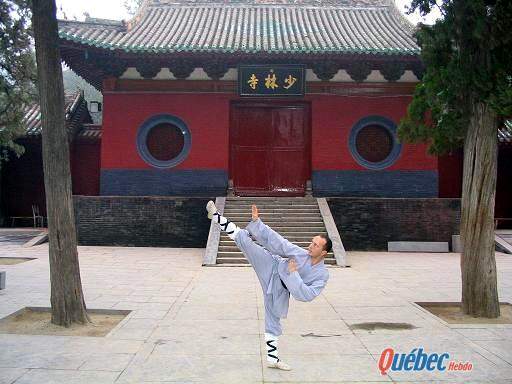
Thiểu Quang Thiên: Parittabhas (skt)—Trời Tứ Phạm hay đệ nhứt thiên
trong nhị thiền thiên—The fourth Brahmaloka or the first region of the
second dhyana heavens.
Thiểu Số: Minority.
Thiểu Tài Quỷ: Quỷ đói thường ăn cắp vì thiếu thức ăn—Hungry ghosts
who pilfer (ăn cắp vặt) because they are poor and get but little food.
Thiểu Thất: Trên núi Tung Sơn, nơi Tổ Bồ Đề Đạt Ma xây dựng ngôi
Thiếu Lâm Tự—Shao-Shih, a hill on the Sung-Shan where Bodhidharma set
up his monastery.
Thiểu (Thiếu) Thất Lục Môn Tập: Six brief treatises attributed to
Bodhidharma , but their authenticity is denied.
Thiểu Tịnh Thiên,少淨天, Parttasubhas—Đệ
nhất thiên thuộc đệ tam thiền ở cõi sắc giới—The first and smallest
heaven (brahmaloka) in the third dhyana region of form
Thiệu:
1) Giới thiệu: To introduce—To present.
2) Tiếp nối: To continue.
3) Truyền trao: To hand down.
Thiệu Kỳ Sở Sơn: See Sở Sơn Thiệu Kỳ.
Thiệu Long,紹隆, Nối pháp làm cho
ngày thêm hưng thịnh—To continue or perpetuate and prosper Buddhist
truth, or the Triratna
Thính Giáo,聽教, Nghe và phụng hành
Phật pháp—To hear the Buddha’s doctrine—Those who hear and obey the
Buddha’s doctrine
Thính Hơi: To have a good nose for smelling or finding things out.
Thính Quan: Auditory organ—Organ of hearing.
Thính Tai: To have a keen sense of hearing—To be quick of hearing.
Thính Thị: Audio-visual.
Thính Văn,聽聞, Nghe và phụng
hành—To hear and to obey
Thình Lình: All of a sudden—Unexpectedly—Suddenly—All at once.
Thỉnh: Mời một cách thành kính—To invite (request—ask)
respectfully.
Thỉnh An: Vấn an—To ask after someone’s health.
Thỉnh Chiết,請折, To ask—To request
Thỉnh Chiết,請折, Hỏi hay yêu cầu—To
ask for
Thỉnh Giả,請假, Tạm Giả—Xin phép
nghỉ hay xin phép đi ra ngoài—To ask for leave of absence or permission
to go out
Thỉnh Giáo: To ask for (religious) advice.
Thỉnh Giáo Nơi Thiện Hữu Tri Thức: Seeking guidance from spiritual
advisors.
Thỉnh Ích,請益, Yêu cầu tăng thêm—To
ask for an increase (for more or for advancement)
Thỉnh Khách: To invite guests.
Thỉnh Mời: To invite respectfully.
Thỉnh Nguyện: To demand—To request—To ask.
Thỉnh Phật,請佛, To invite a Buddha
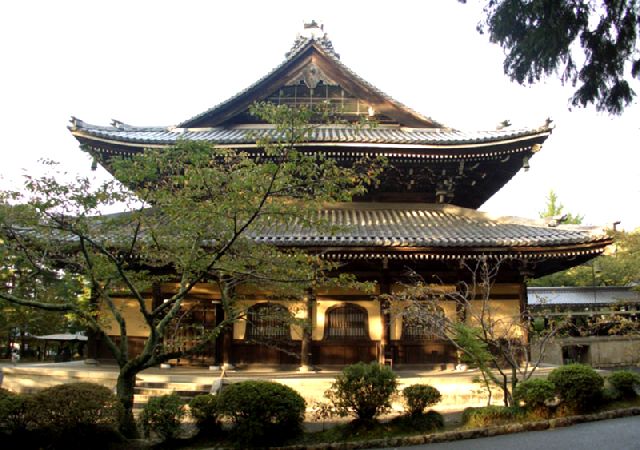
Thỉnh Phật Chuyển Pháp: To request the Buddha to turn the dharma
wheel—Đây là hạnh nguyện thứ sáu trong Phổ Hiền Thập Hạnh Nguyện. Thỉnh
Phật chuyển Pháp (thuyết pháp) là đem ba nghiệp thanh tịnh thân khẩu ý
thỉnh chư Phật nói pháp nhiệm mầu nhằm giúp giác ngộ chúng sanh—This is
the sixth of the ten conducts and vows of Samantabhadra Bodhisattva. To
request the Buddhas to turn the dharma wheel means using all manner of
skillful means of body, mouth and mind, we sincerely and diligently
request that all Buddhas turn the wonderful dharma wheel to enlighten
sentient beings.
Thỉnh Phật Trụ Thế: To request the Buddha to remain in the
world—Đây là hạnh nguyện thứ bảy trong Phổ Hiền Thập Hạnh nguyện. Thỉnh
Phật trụ thế là thỉnh xin chư Phật ở lại đời trải qua vô lượng kiếp vì
lợi lạc của chúng sanh—This is the seventh of the ten conducts and vows
of Universal Worthy Bodhisattva. To request the Buddha to remain in the
world means to request the Buddhas to remain in the world for as many
kalpas to continue to bring benefits and bliss to all living creatures.
Thỉnh Thoảng: Sometimes—At times—From time to time—Now and then—On
and off (off and on).
Thỉnh Vũ,請雨, Cầu Mưa—To pray for
rain
Sí Thịnh,熾盛,
Prosperous—Thriving—Flourishing